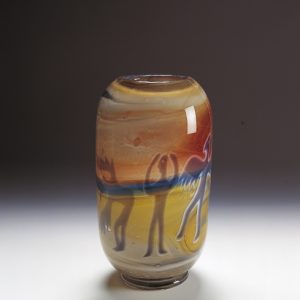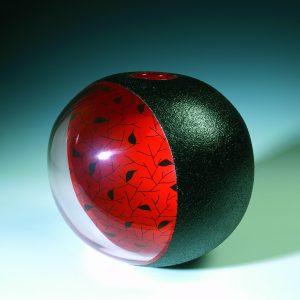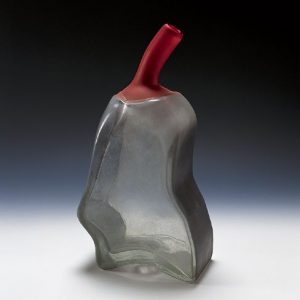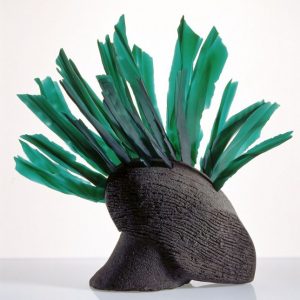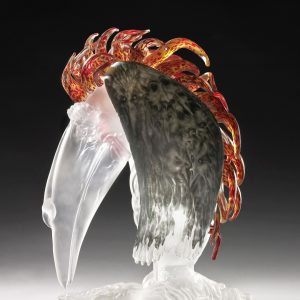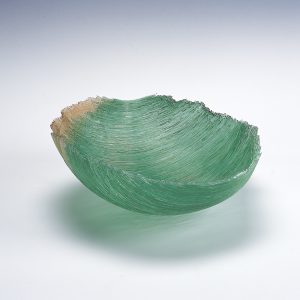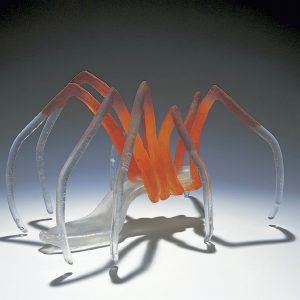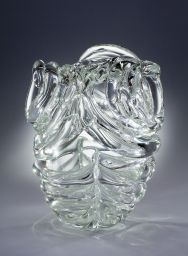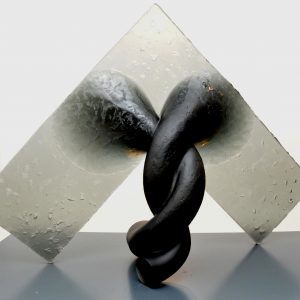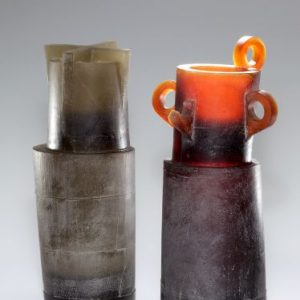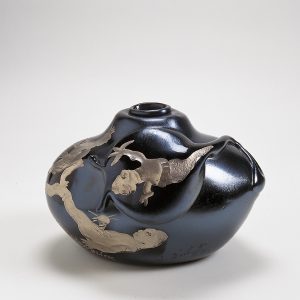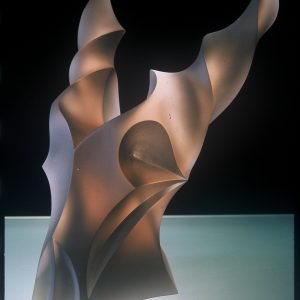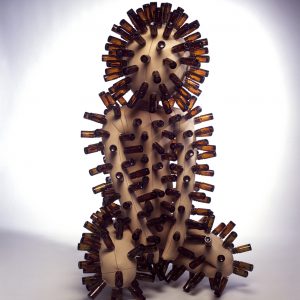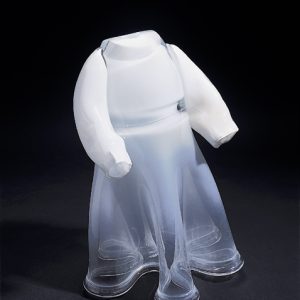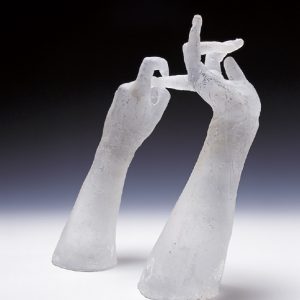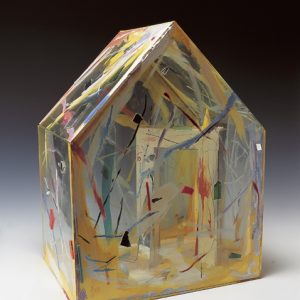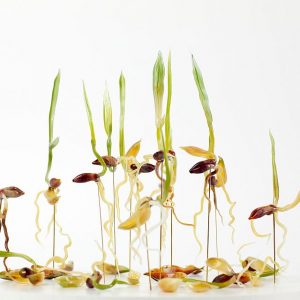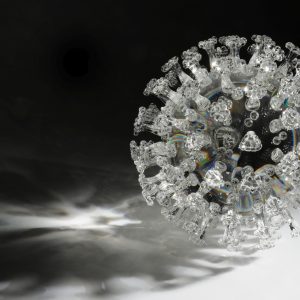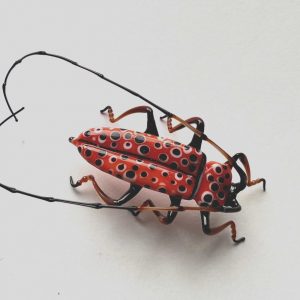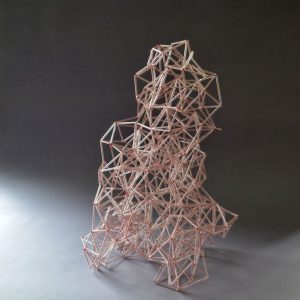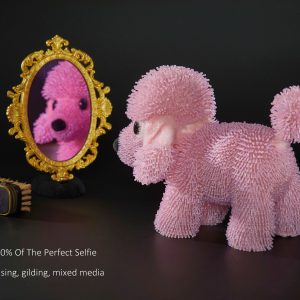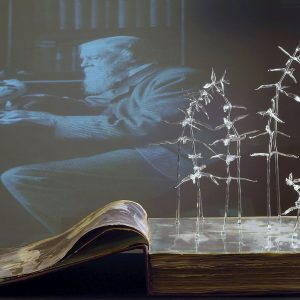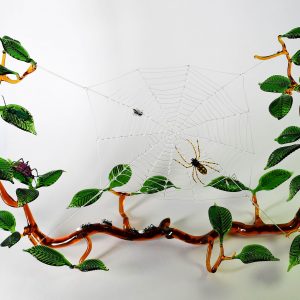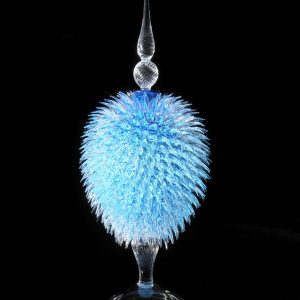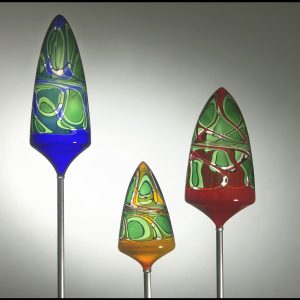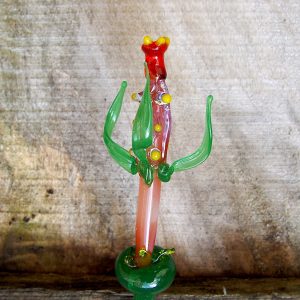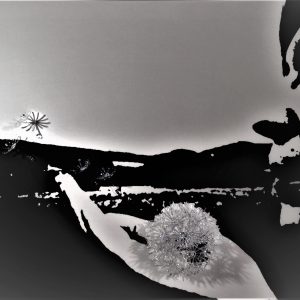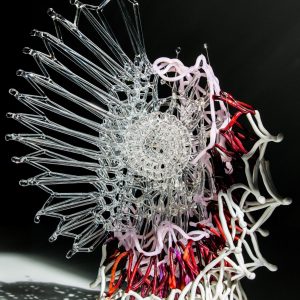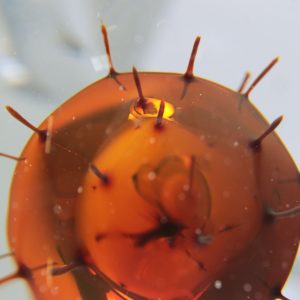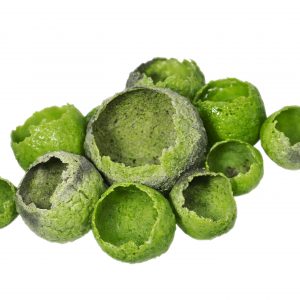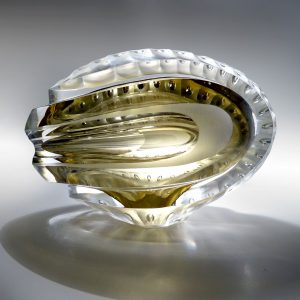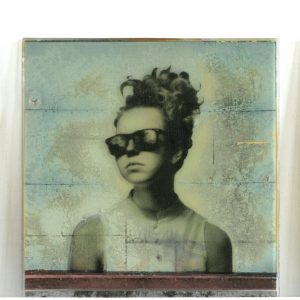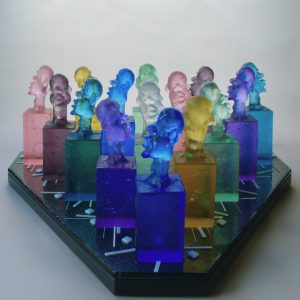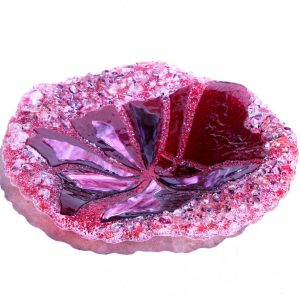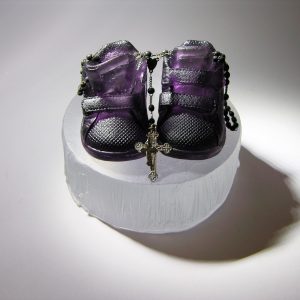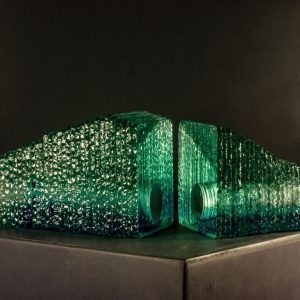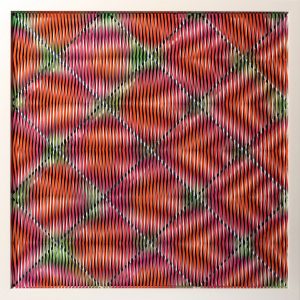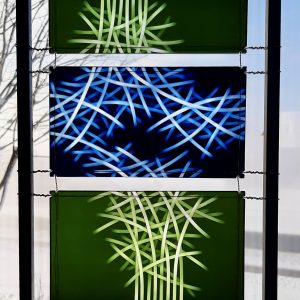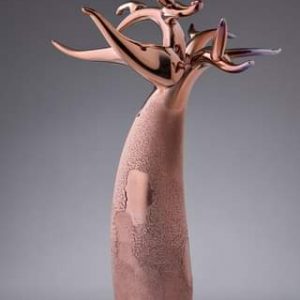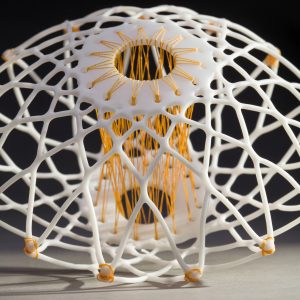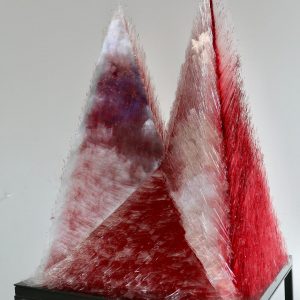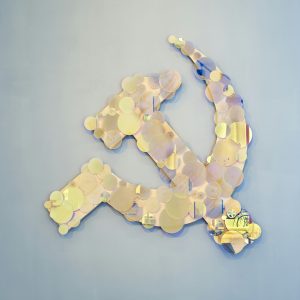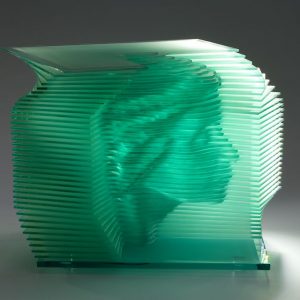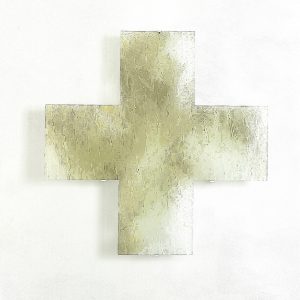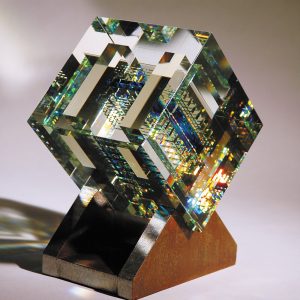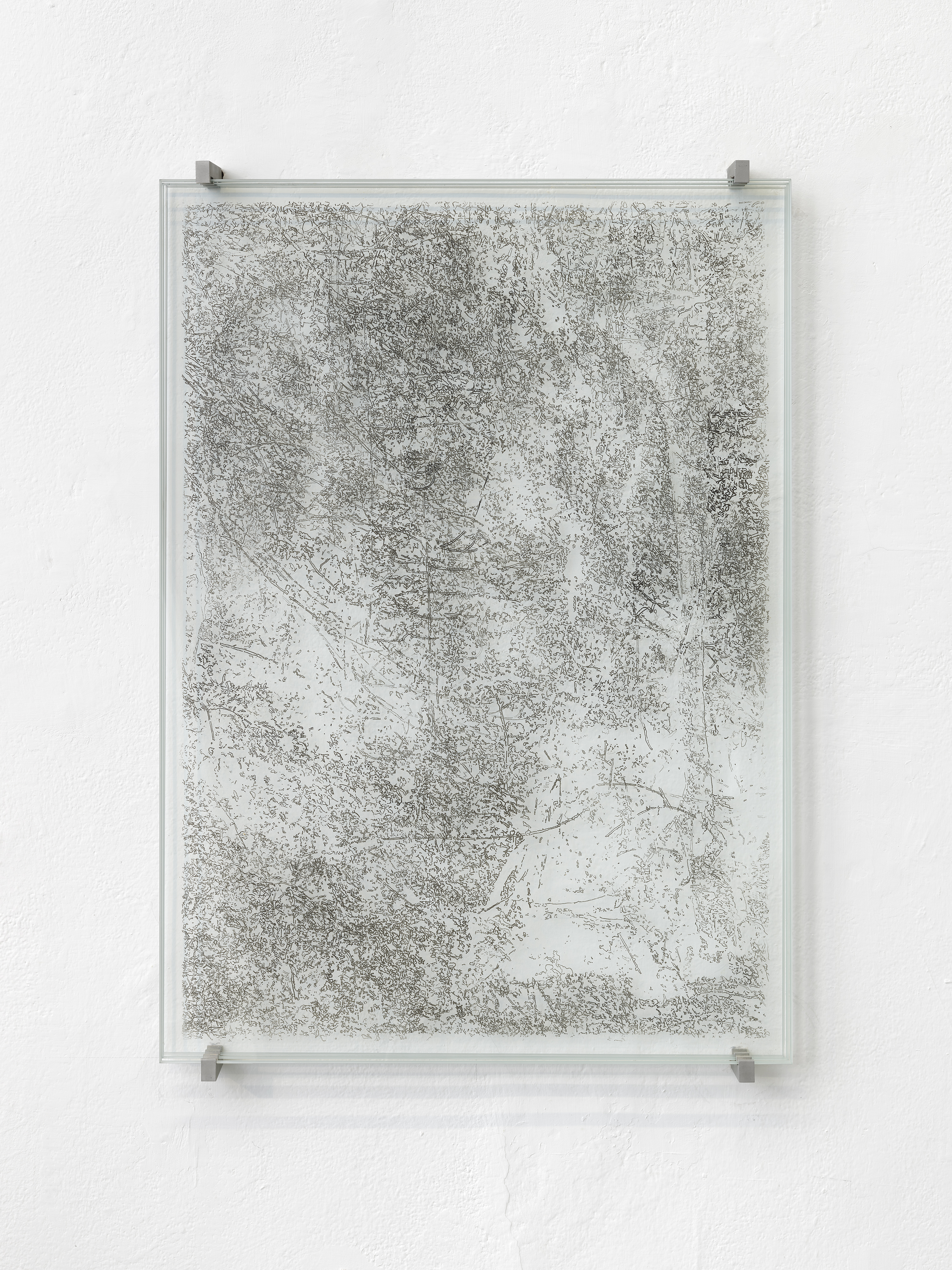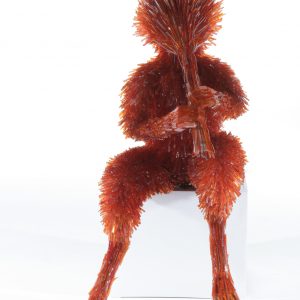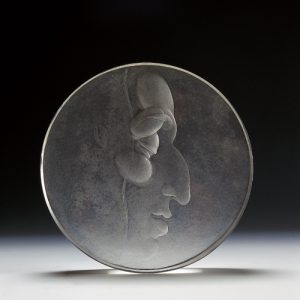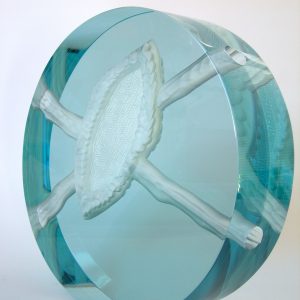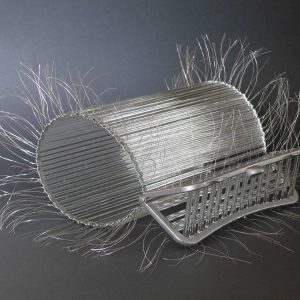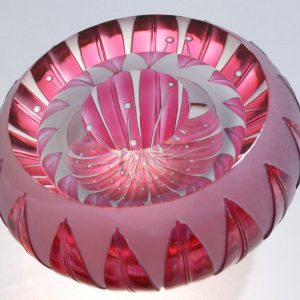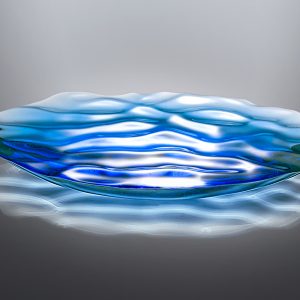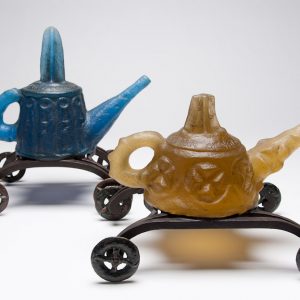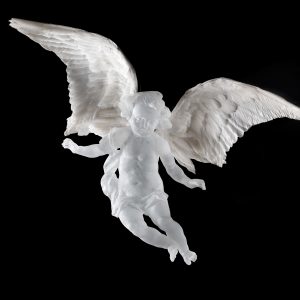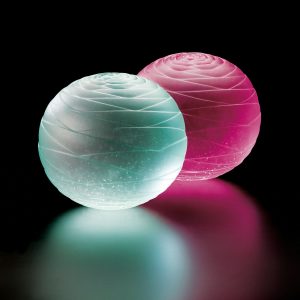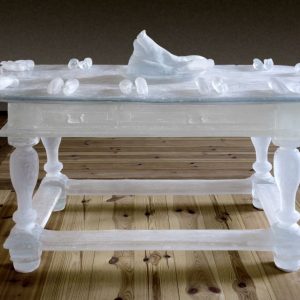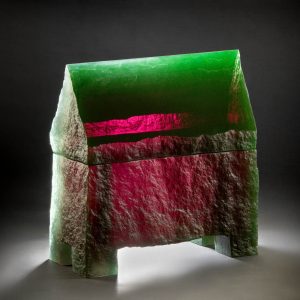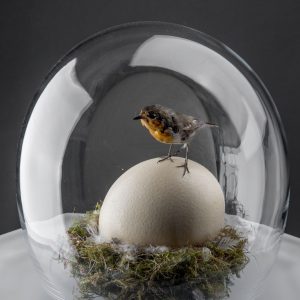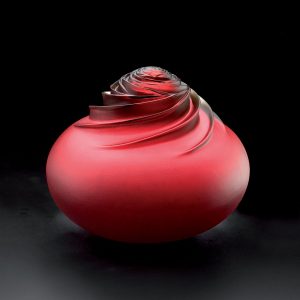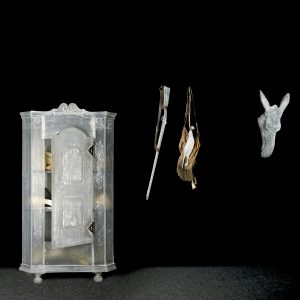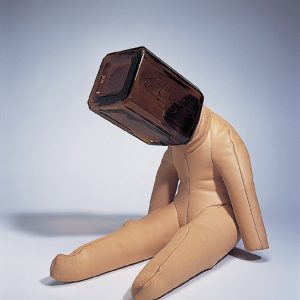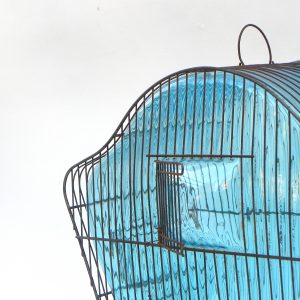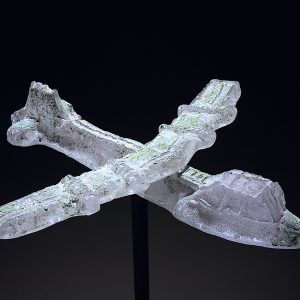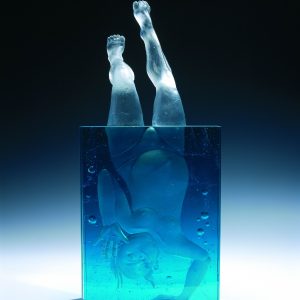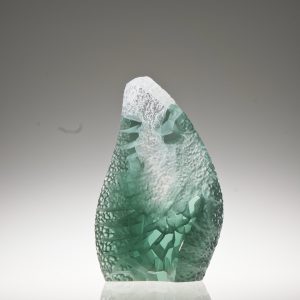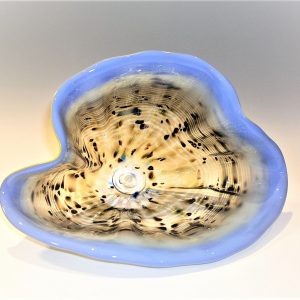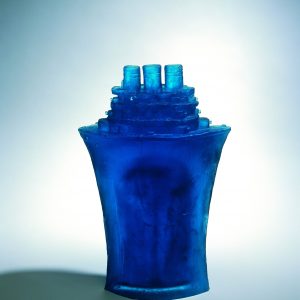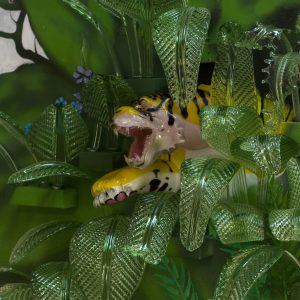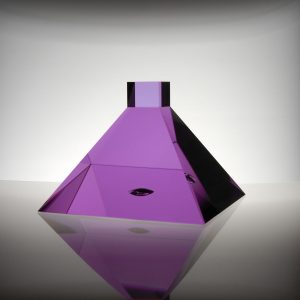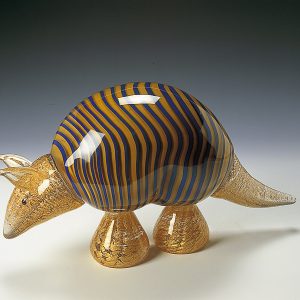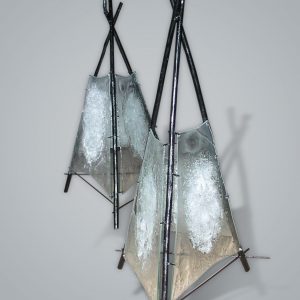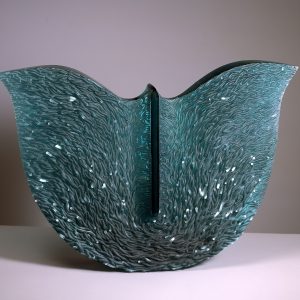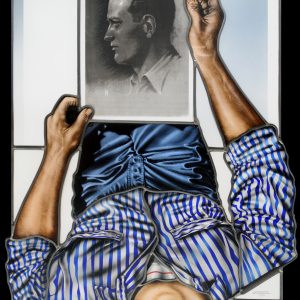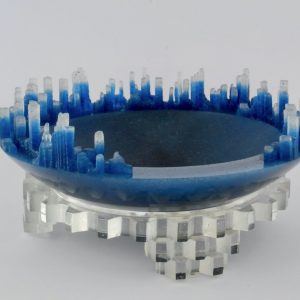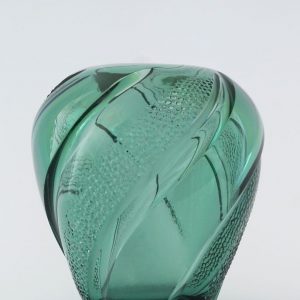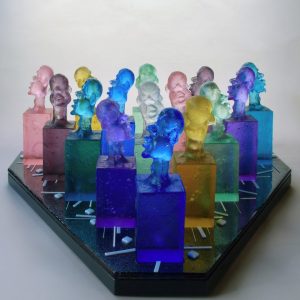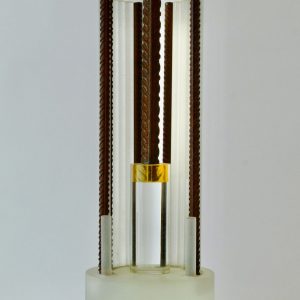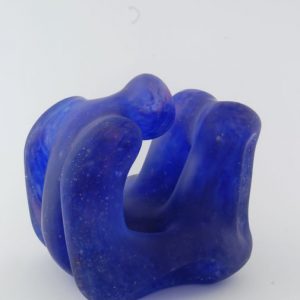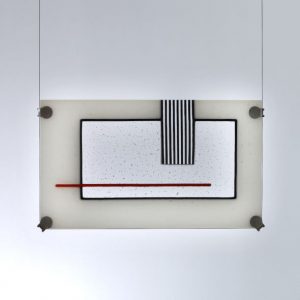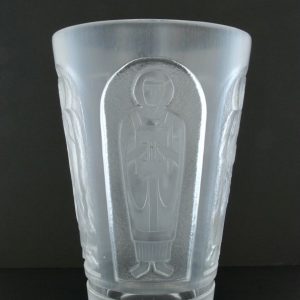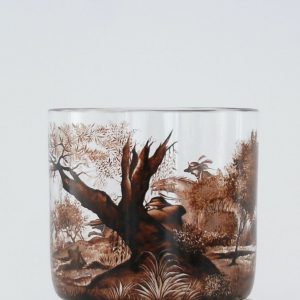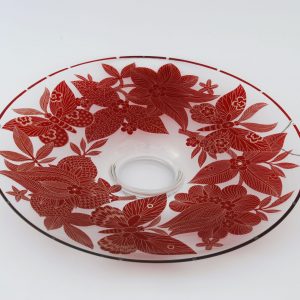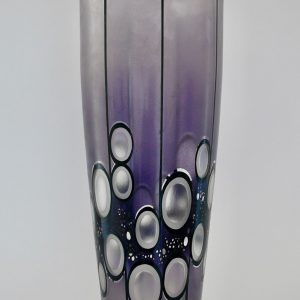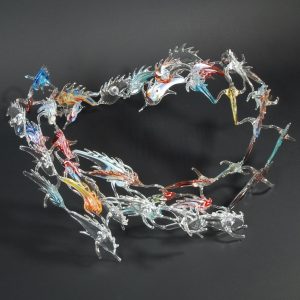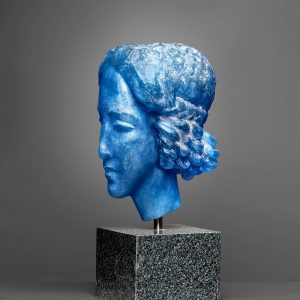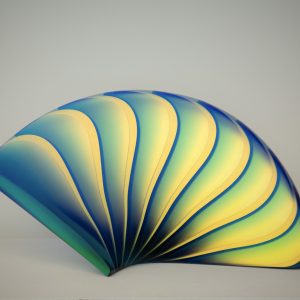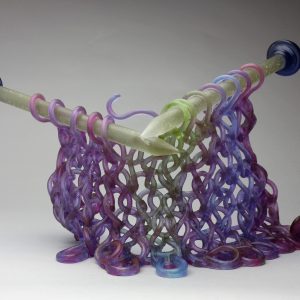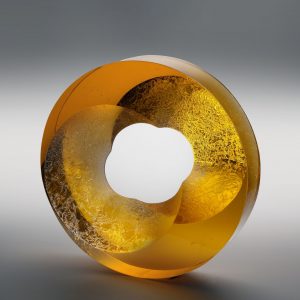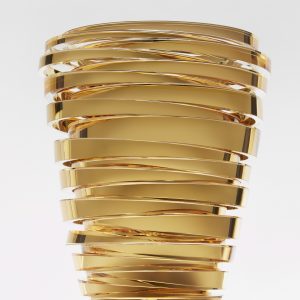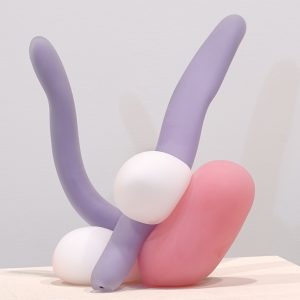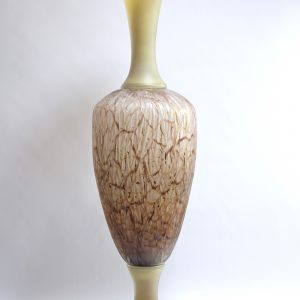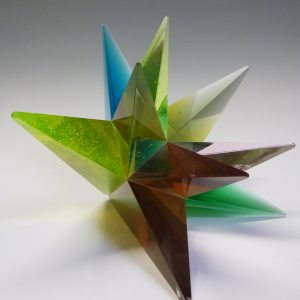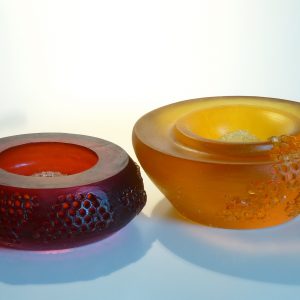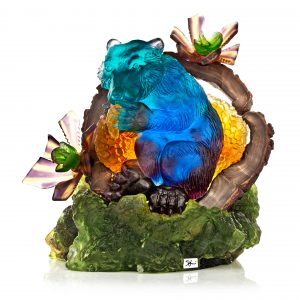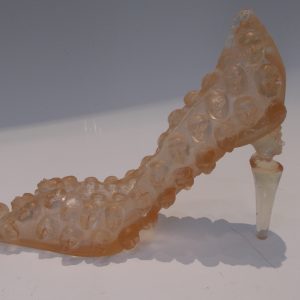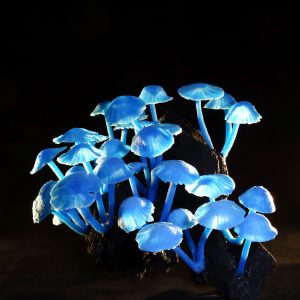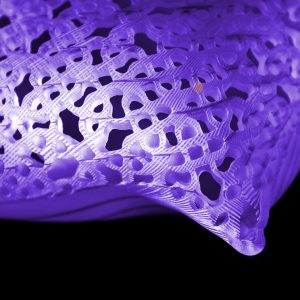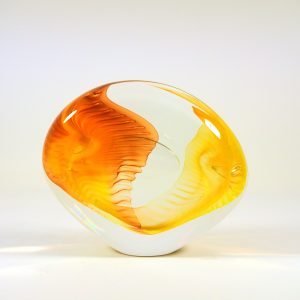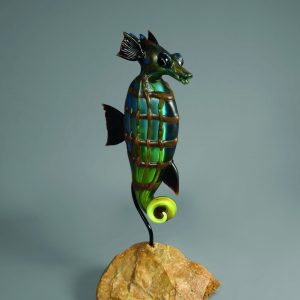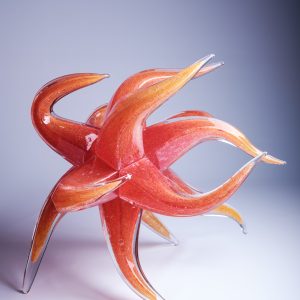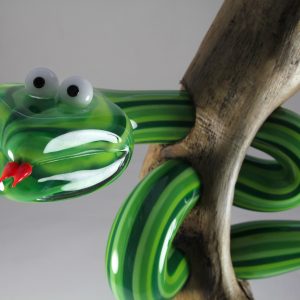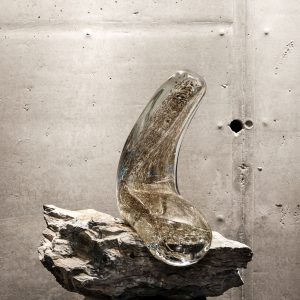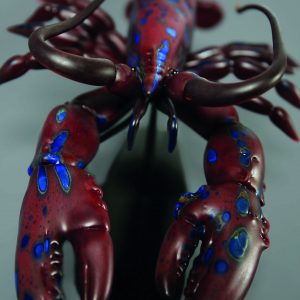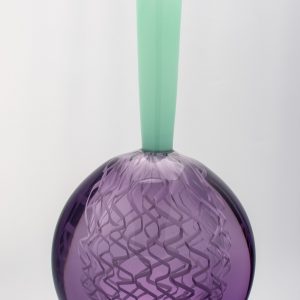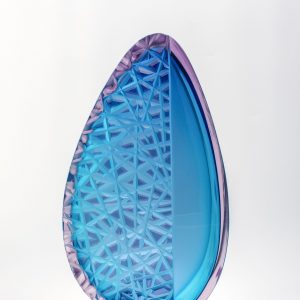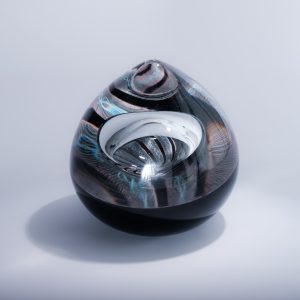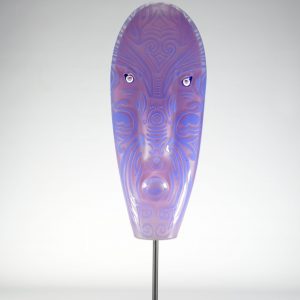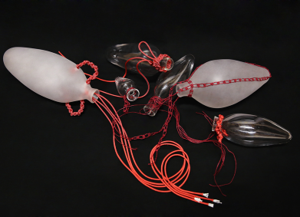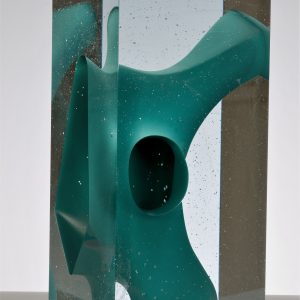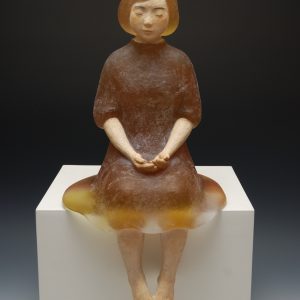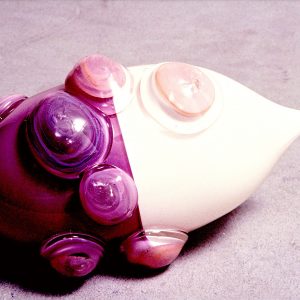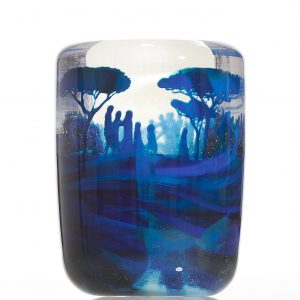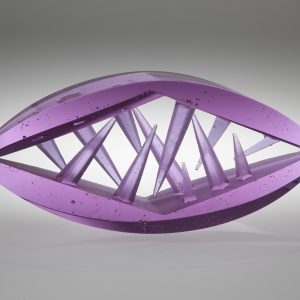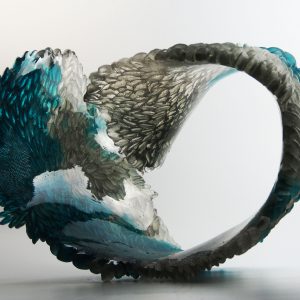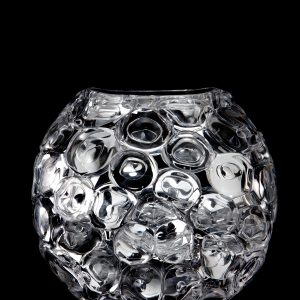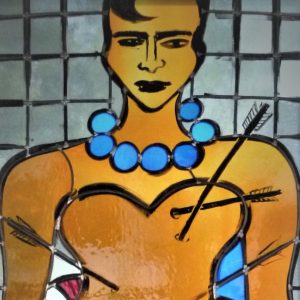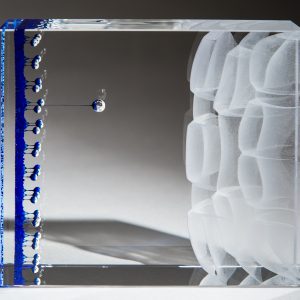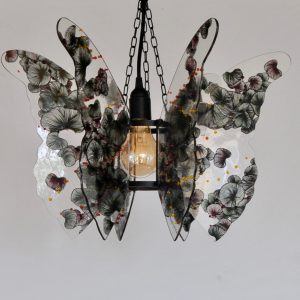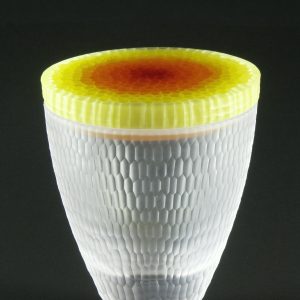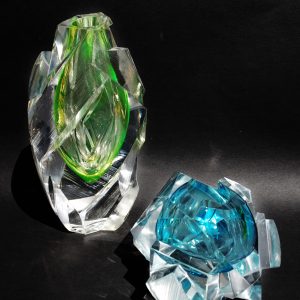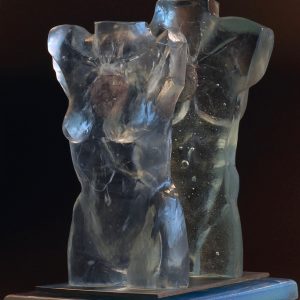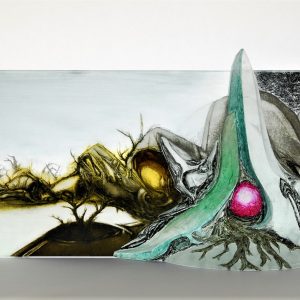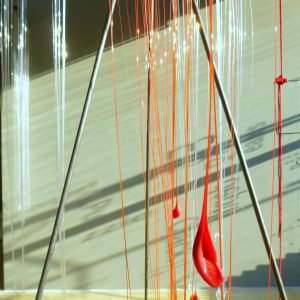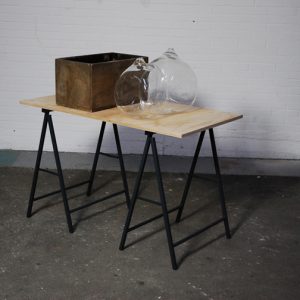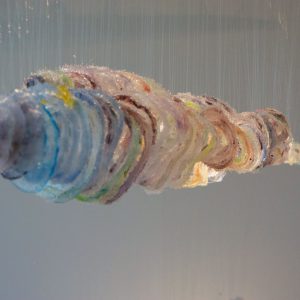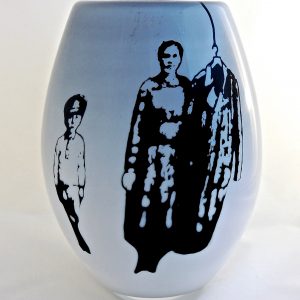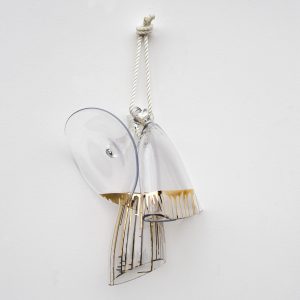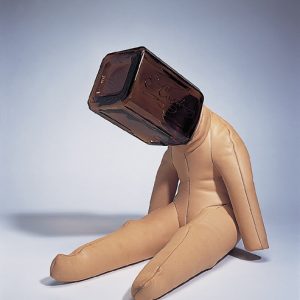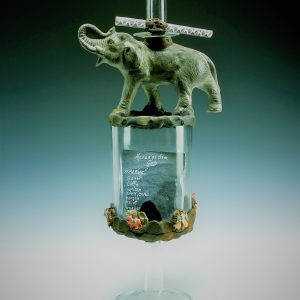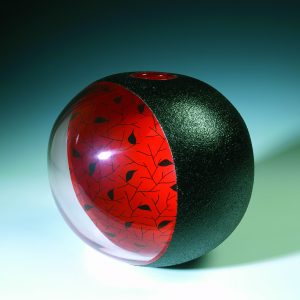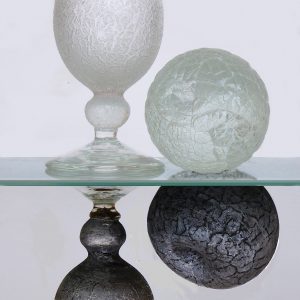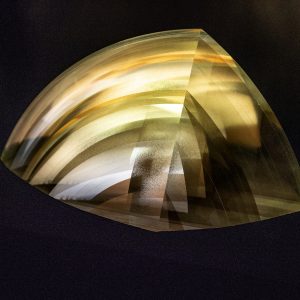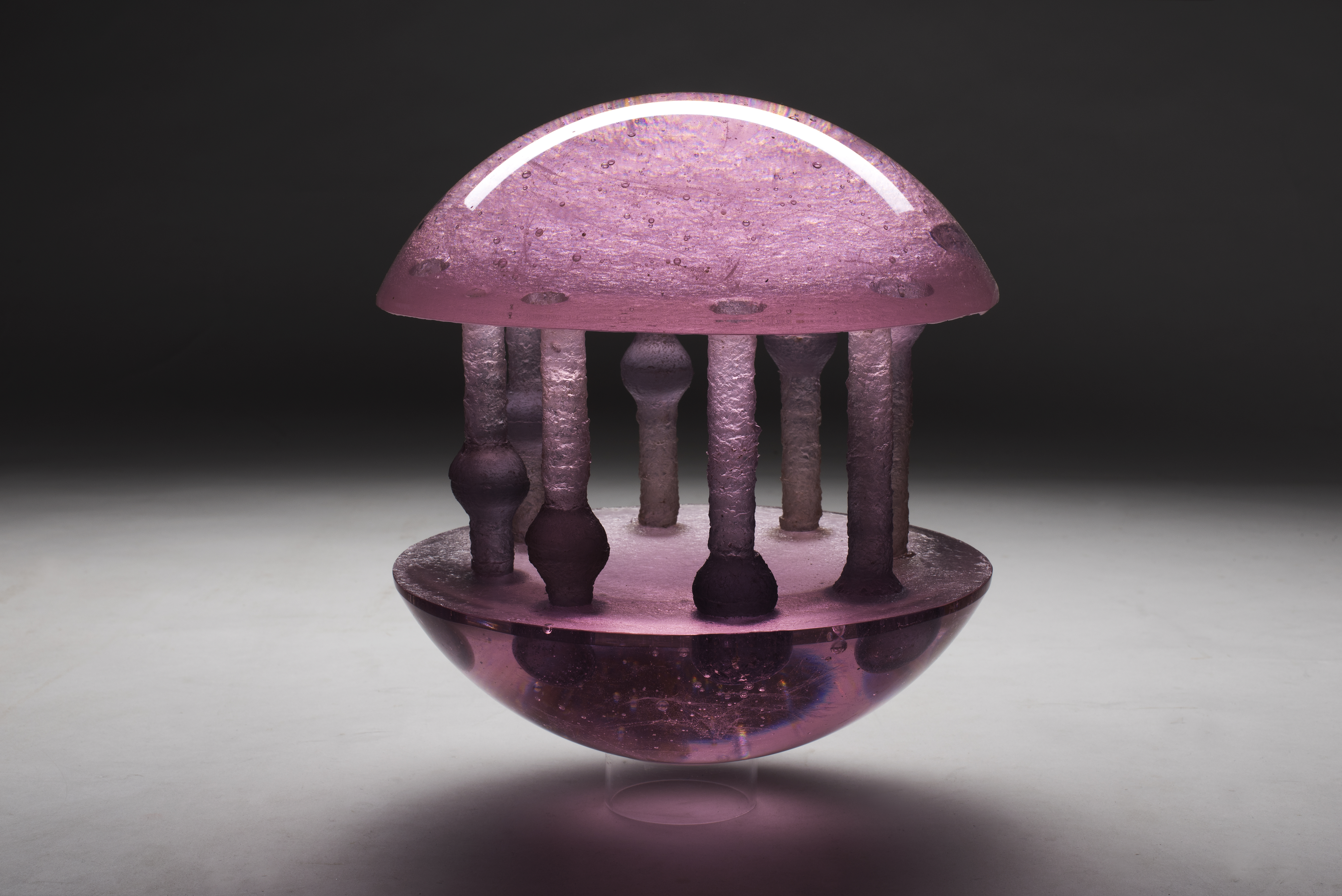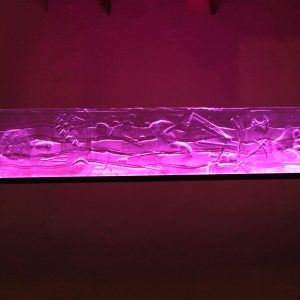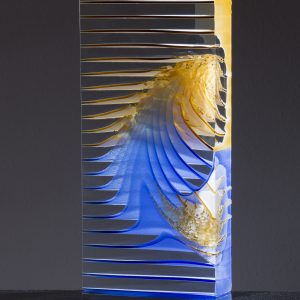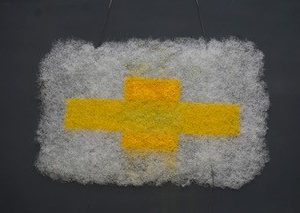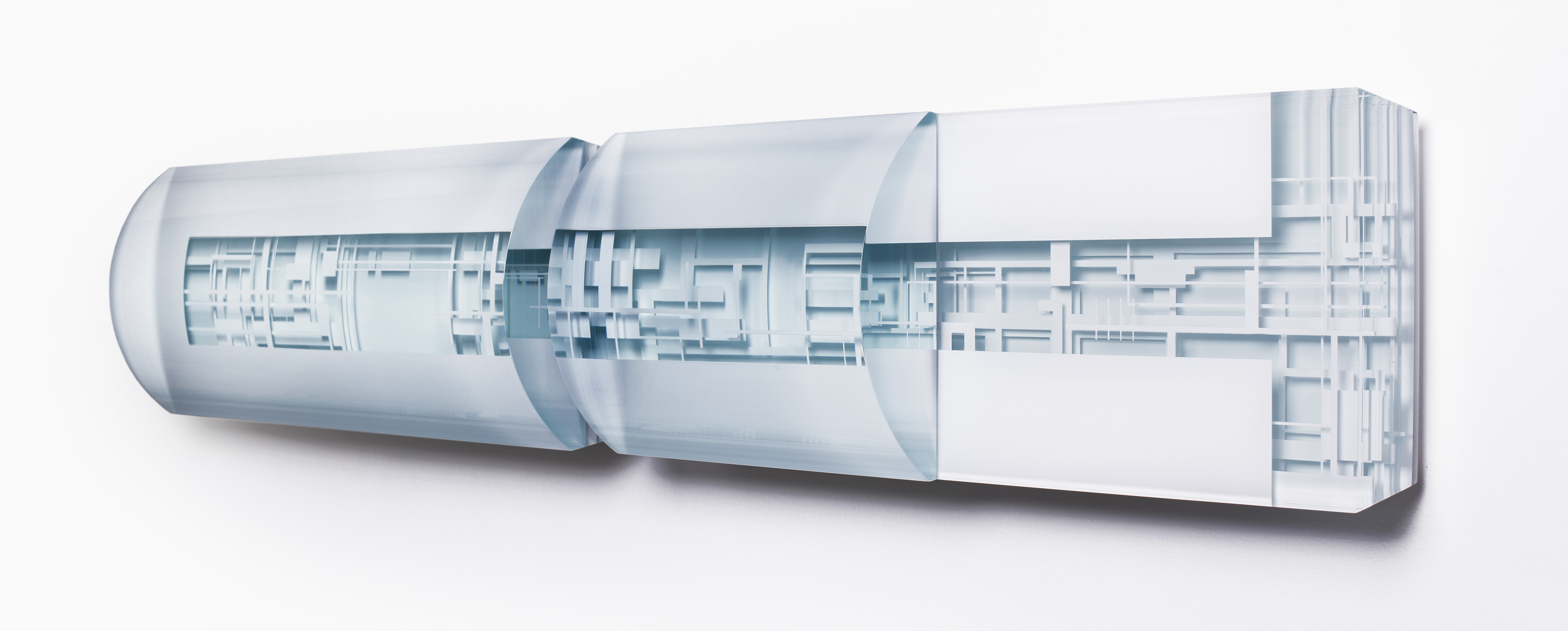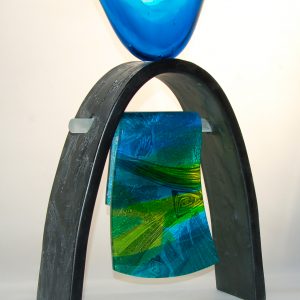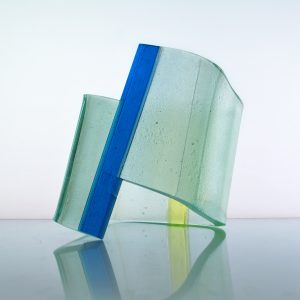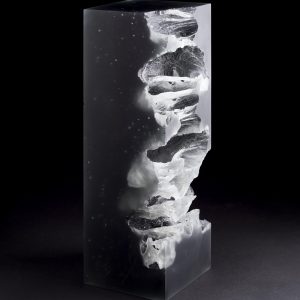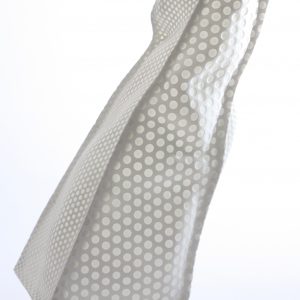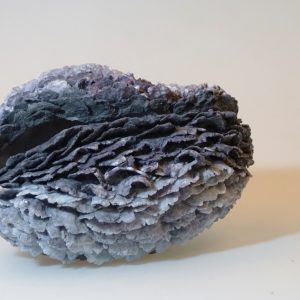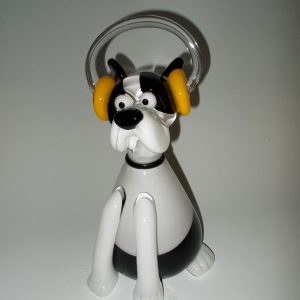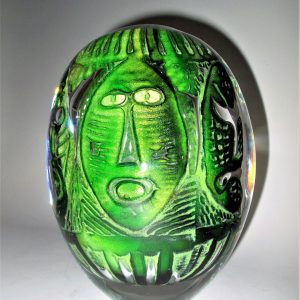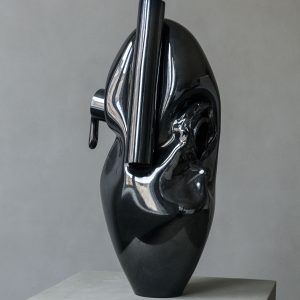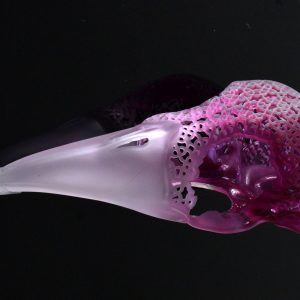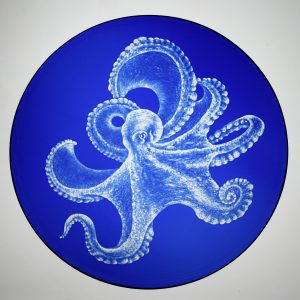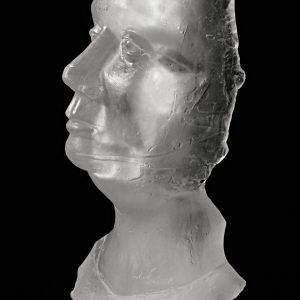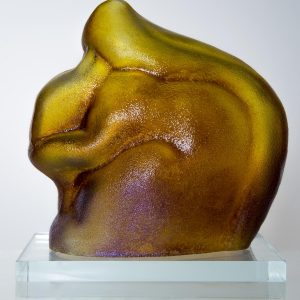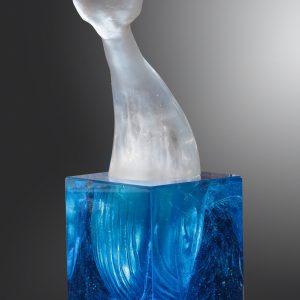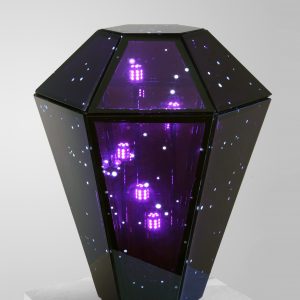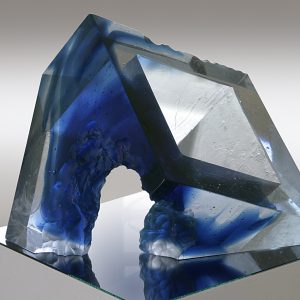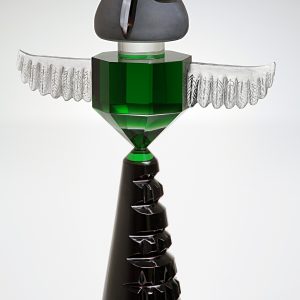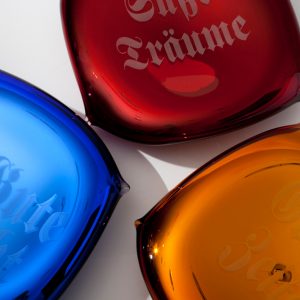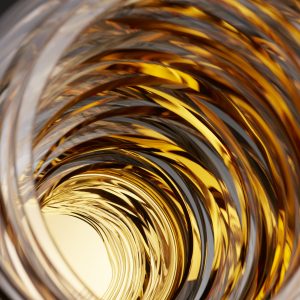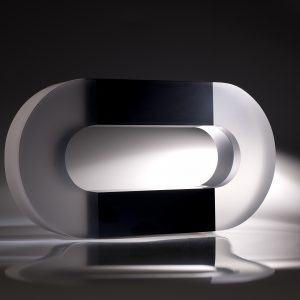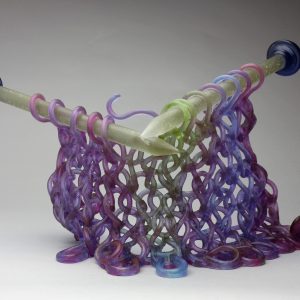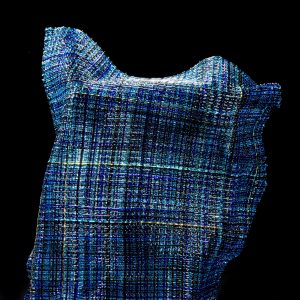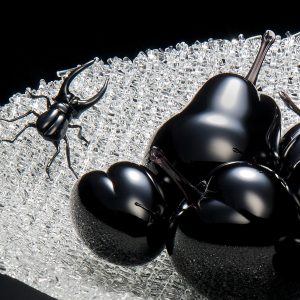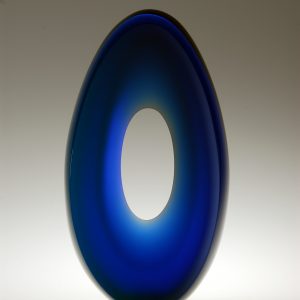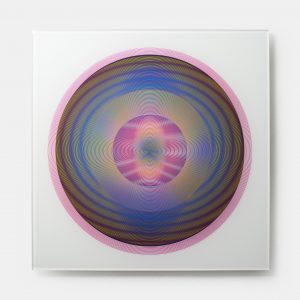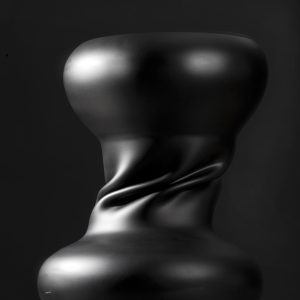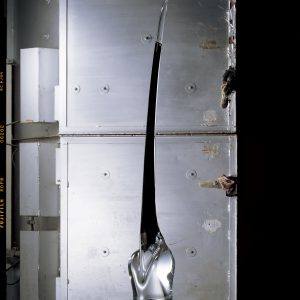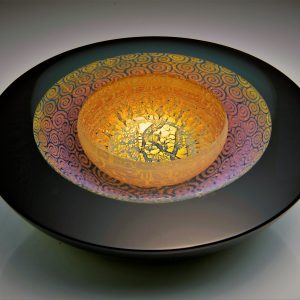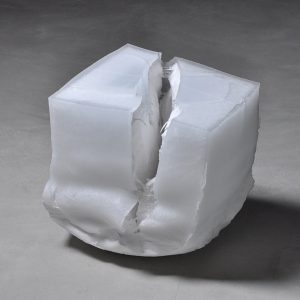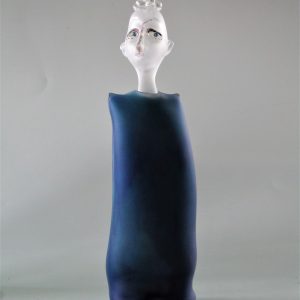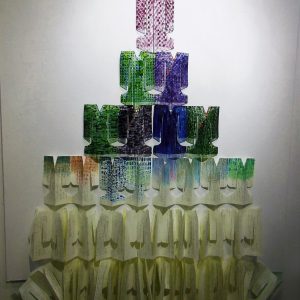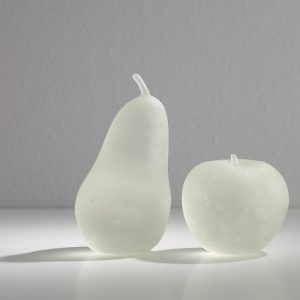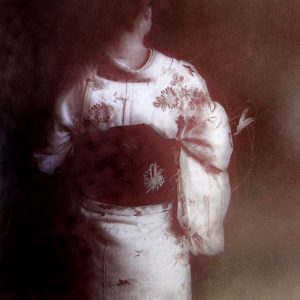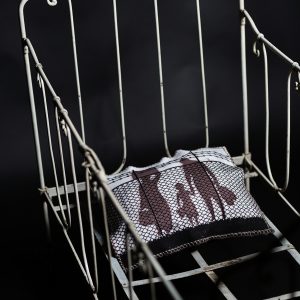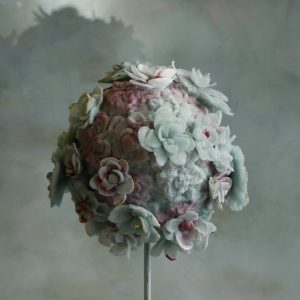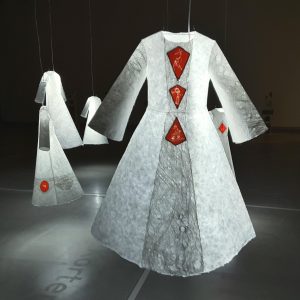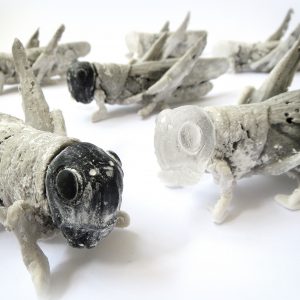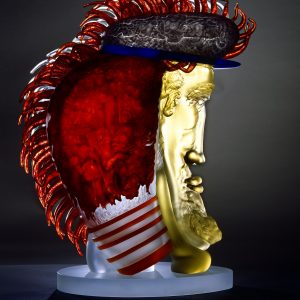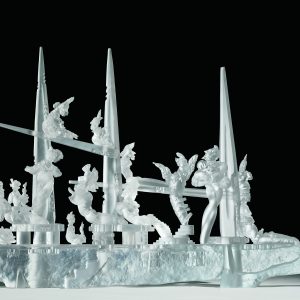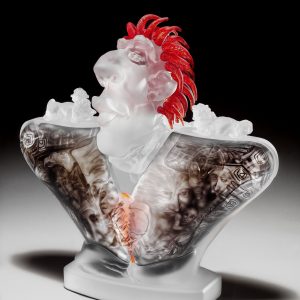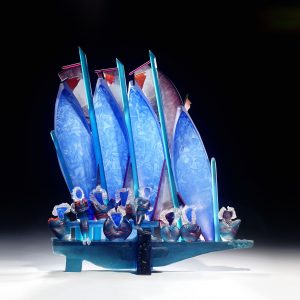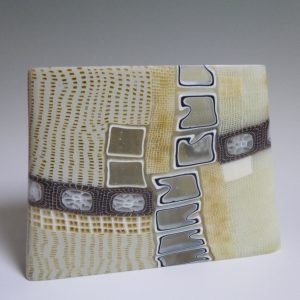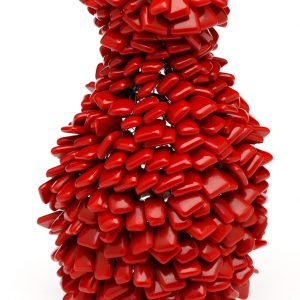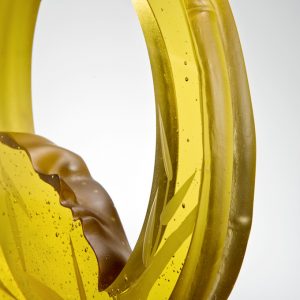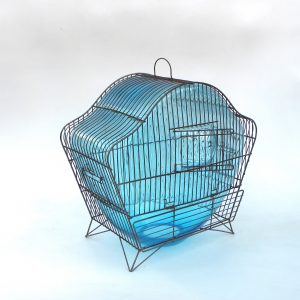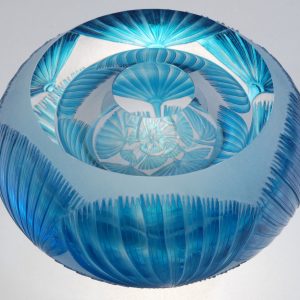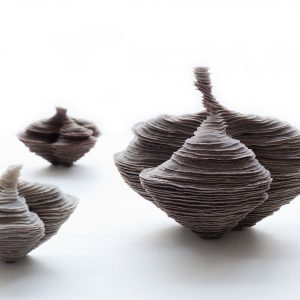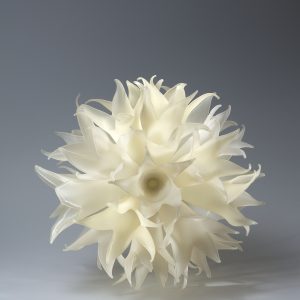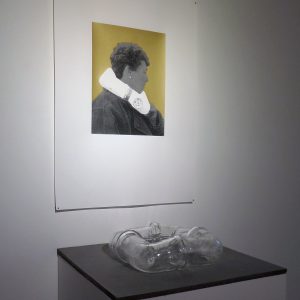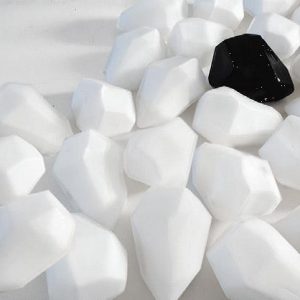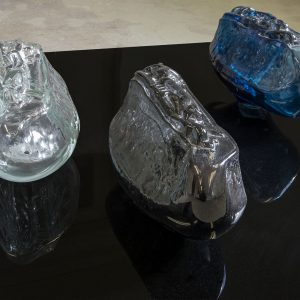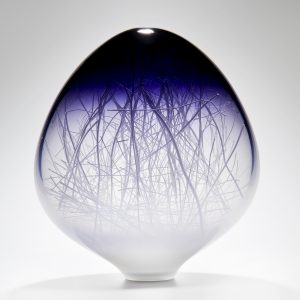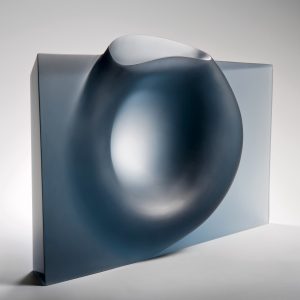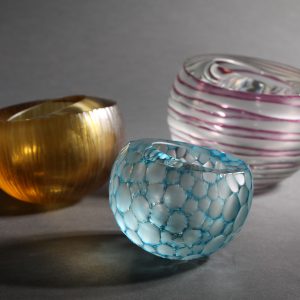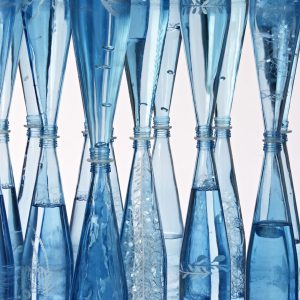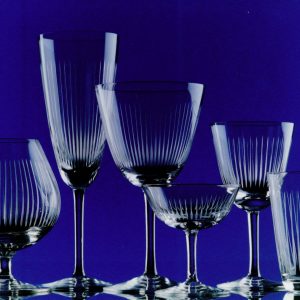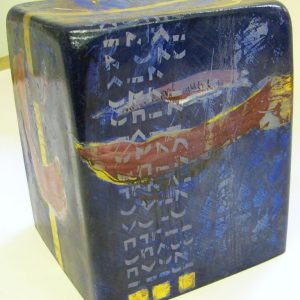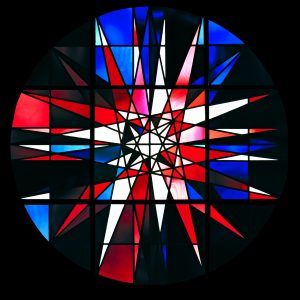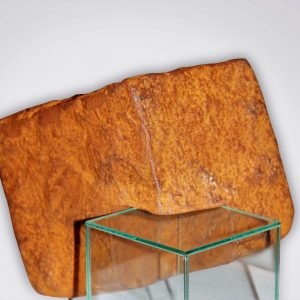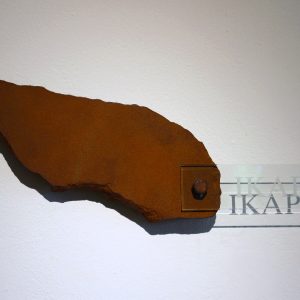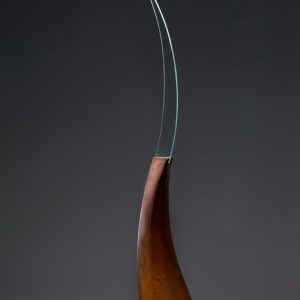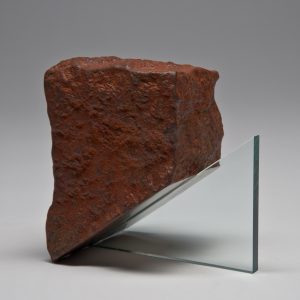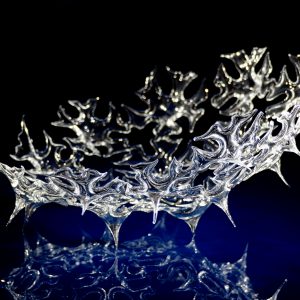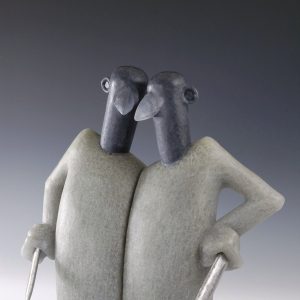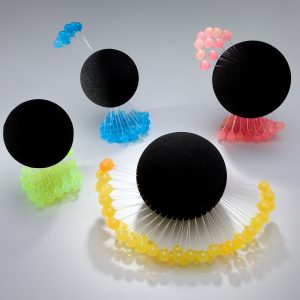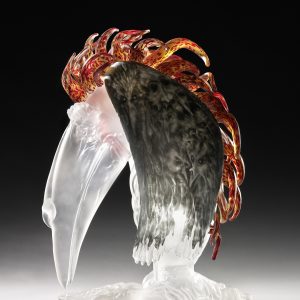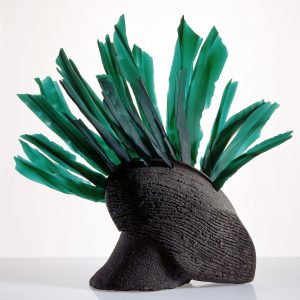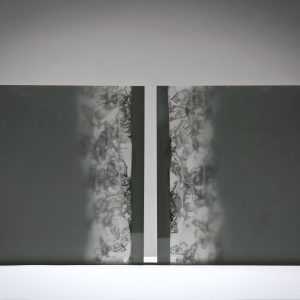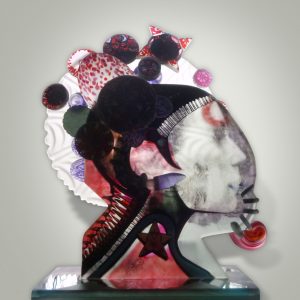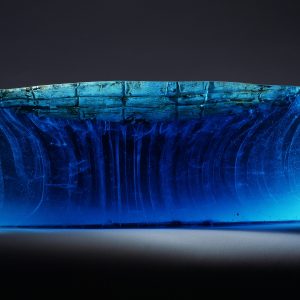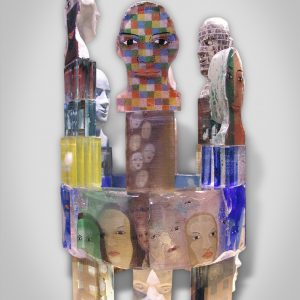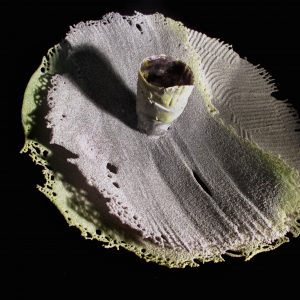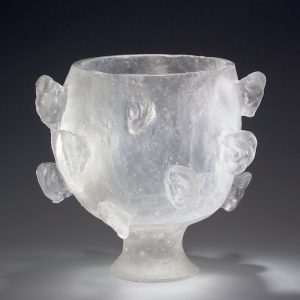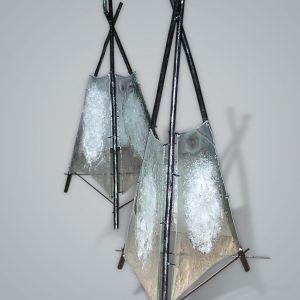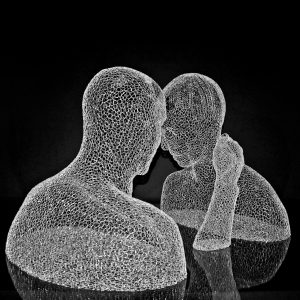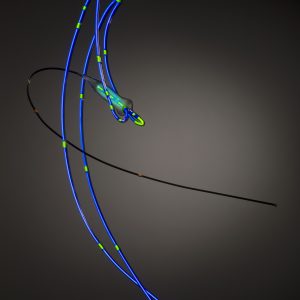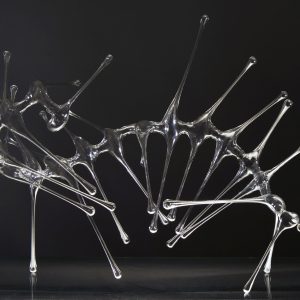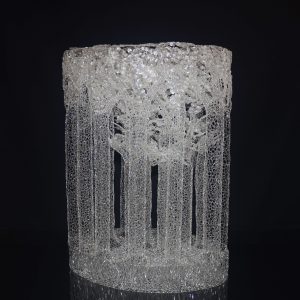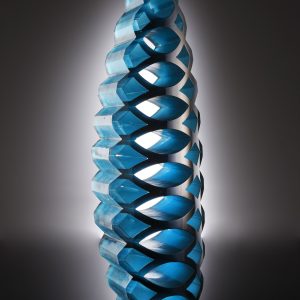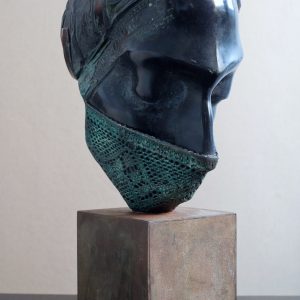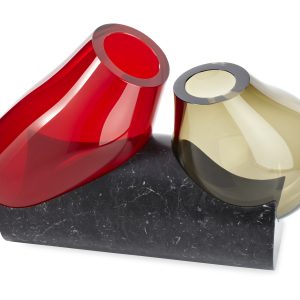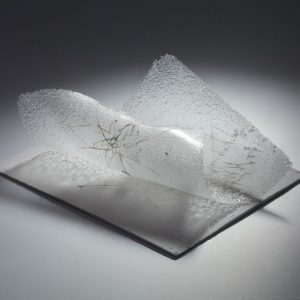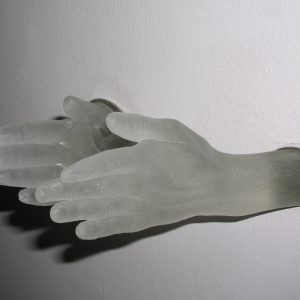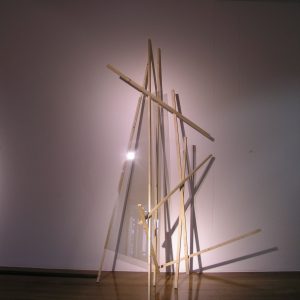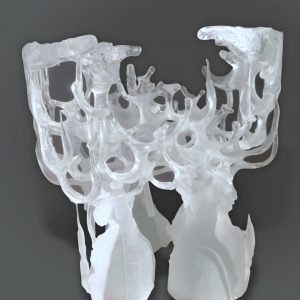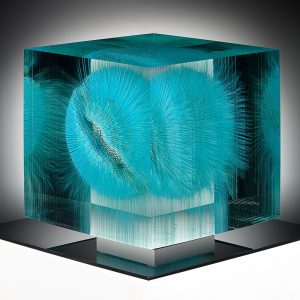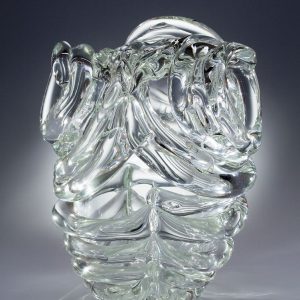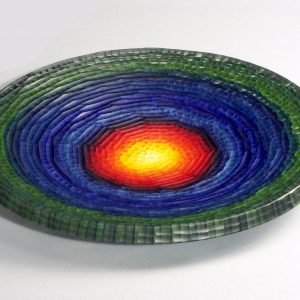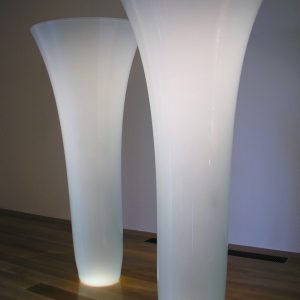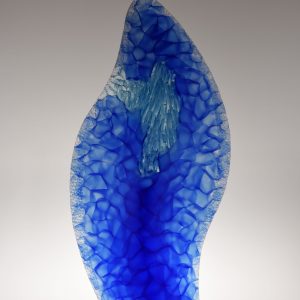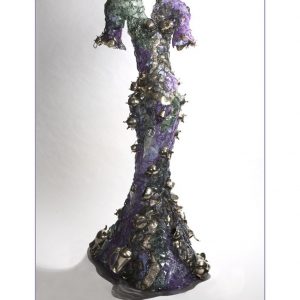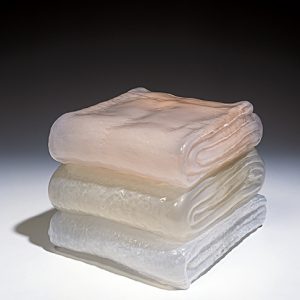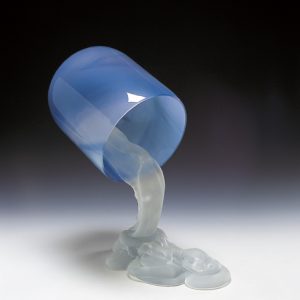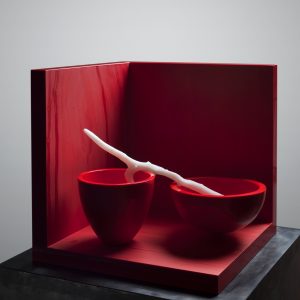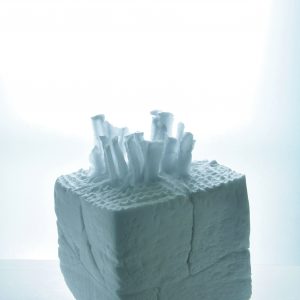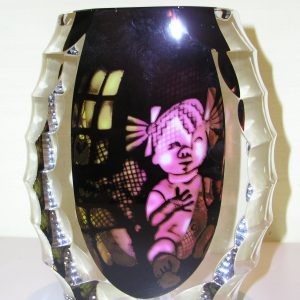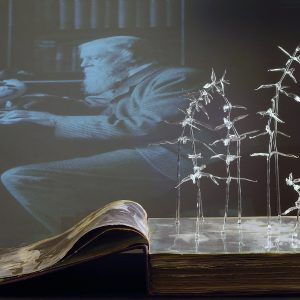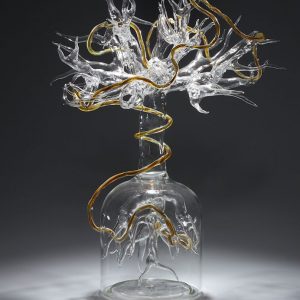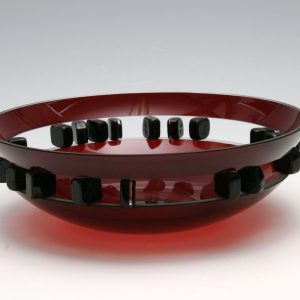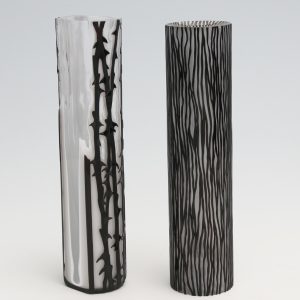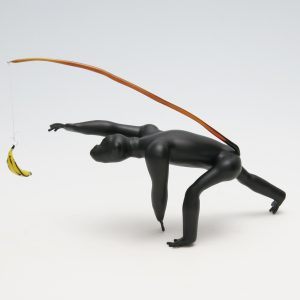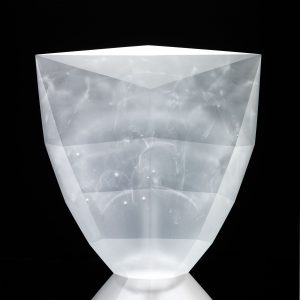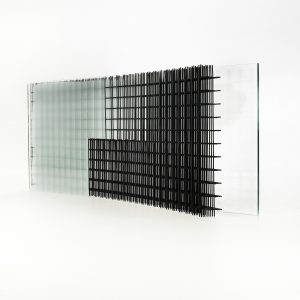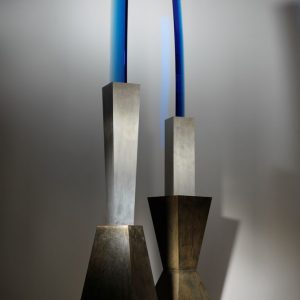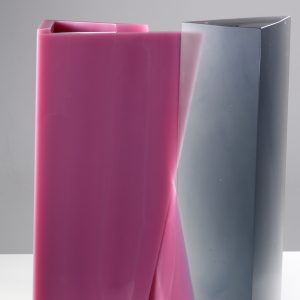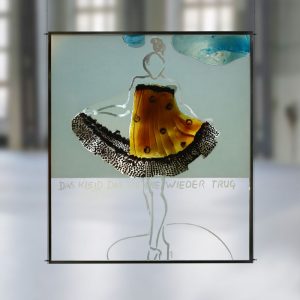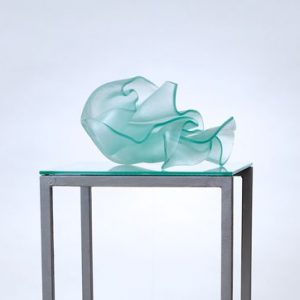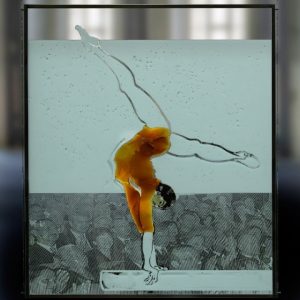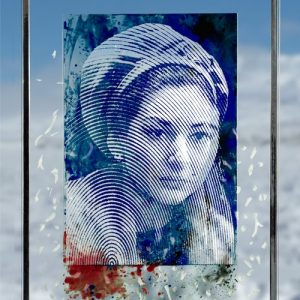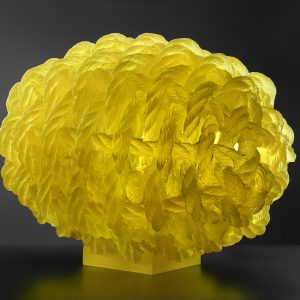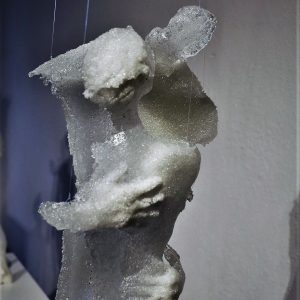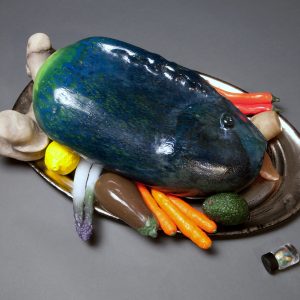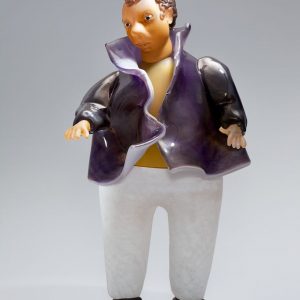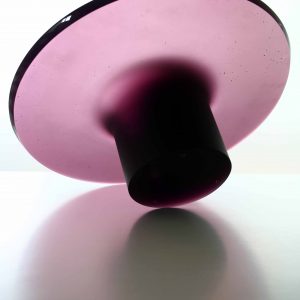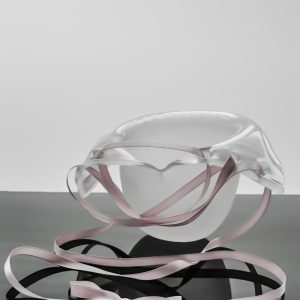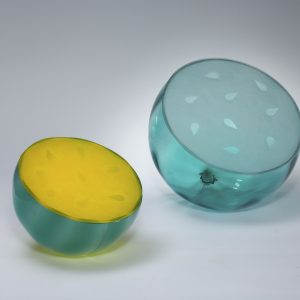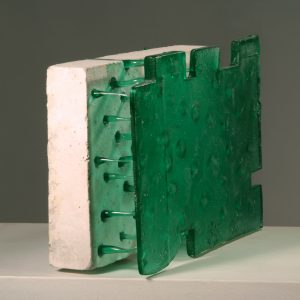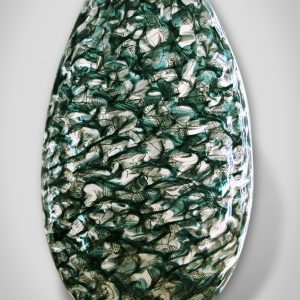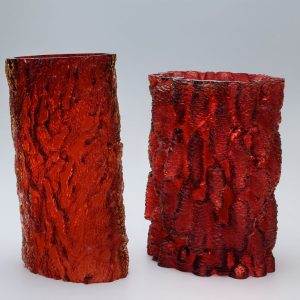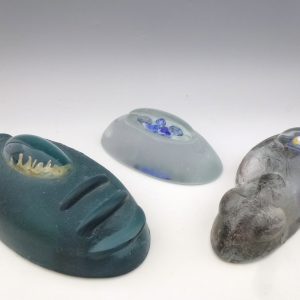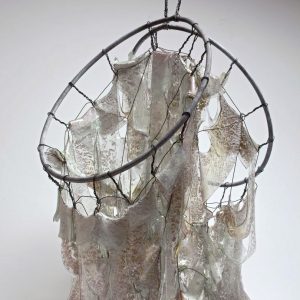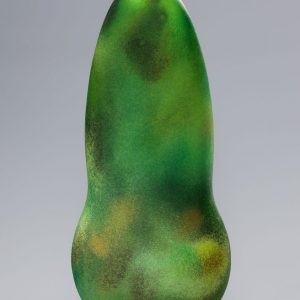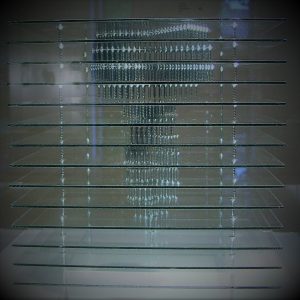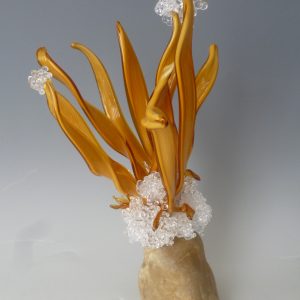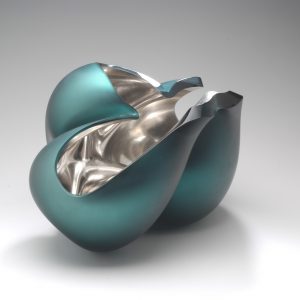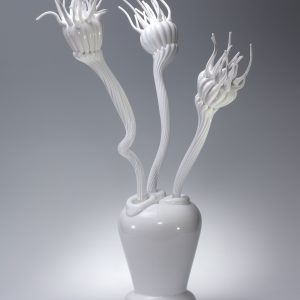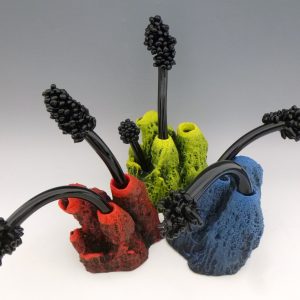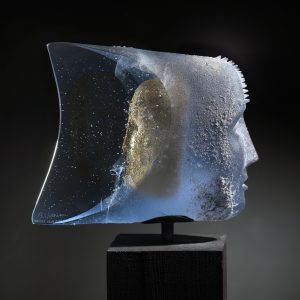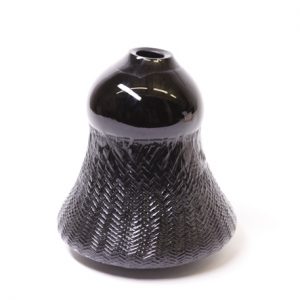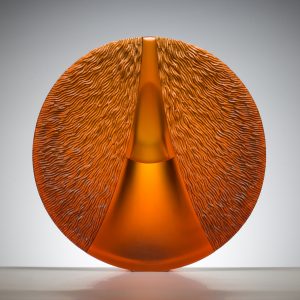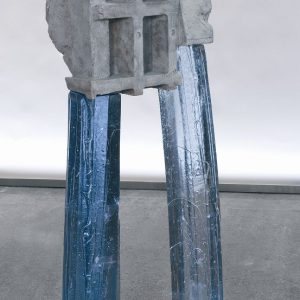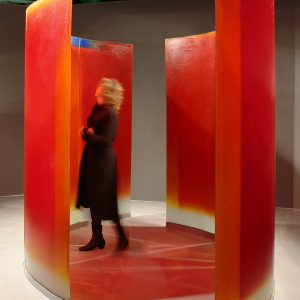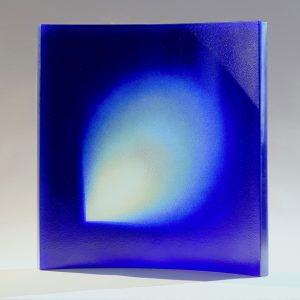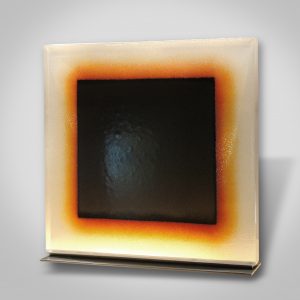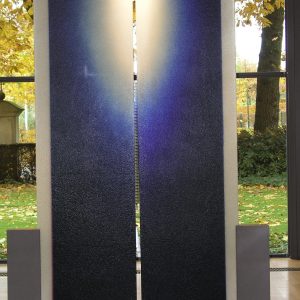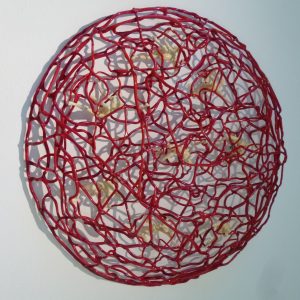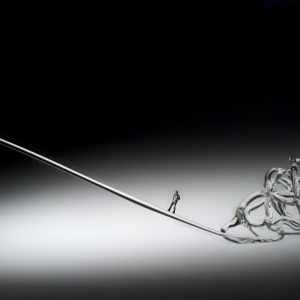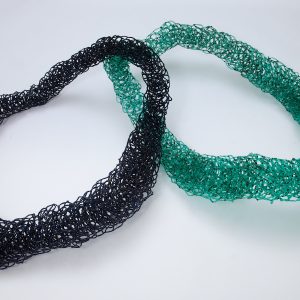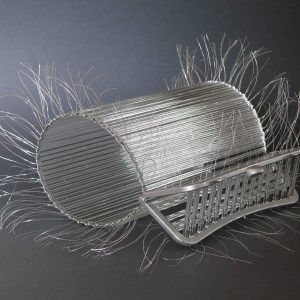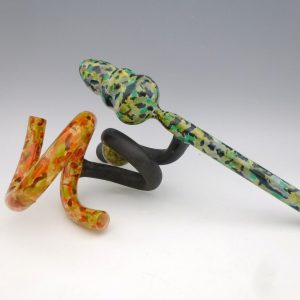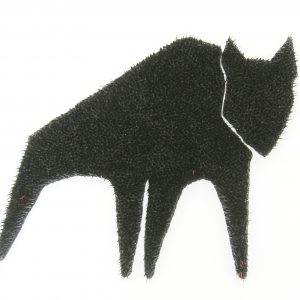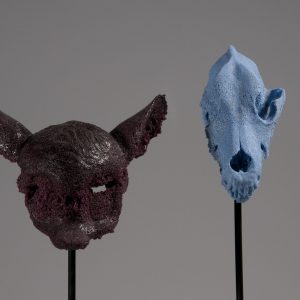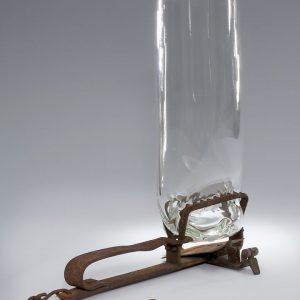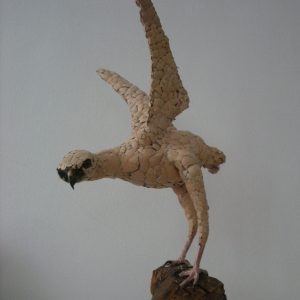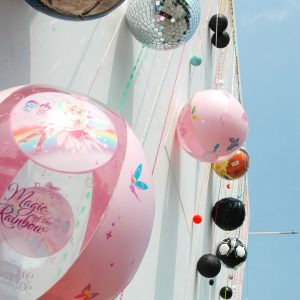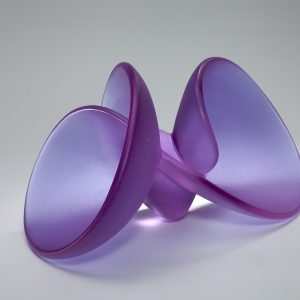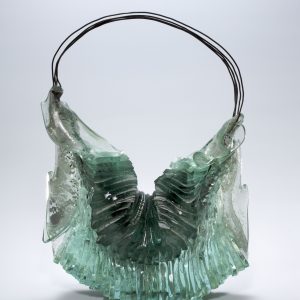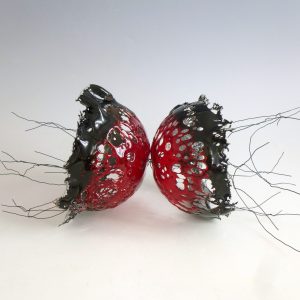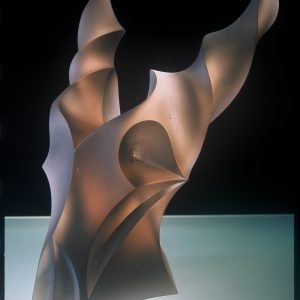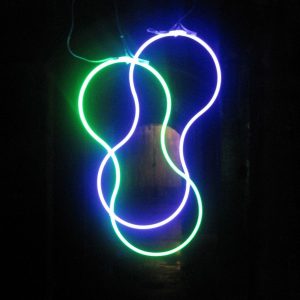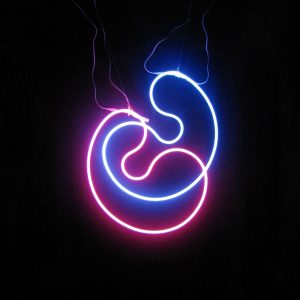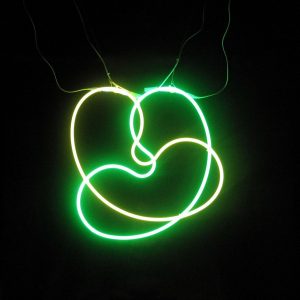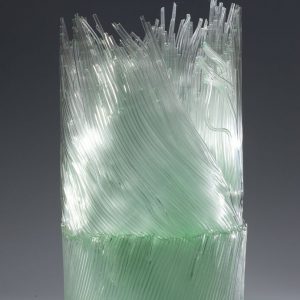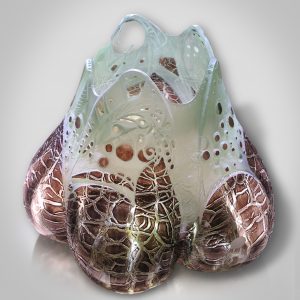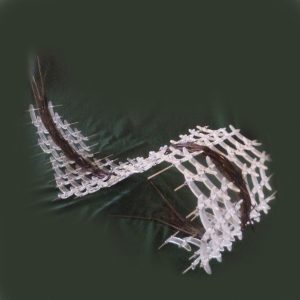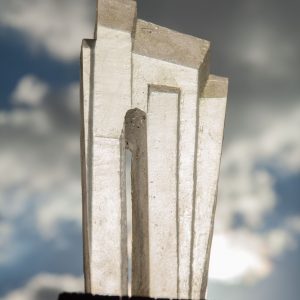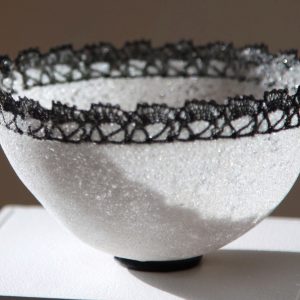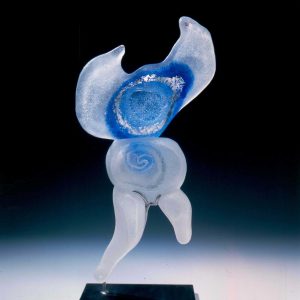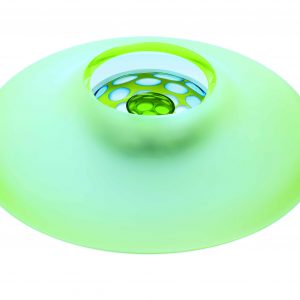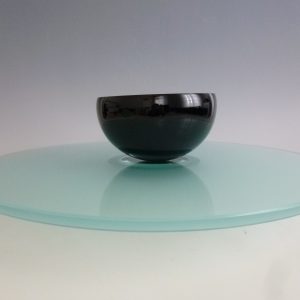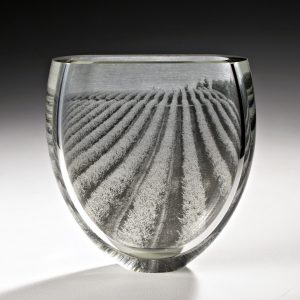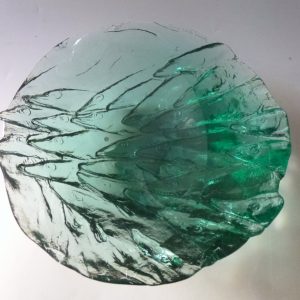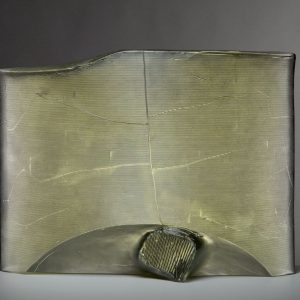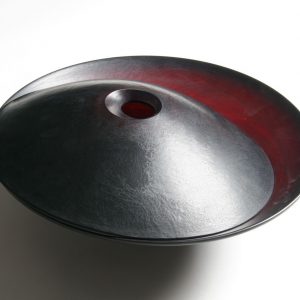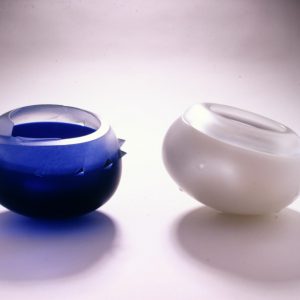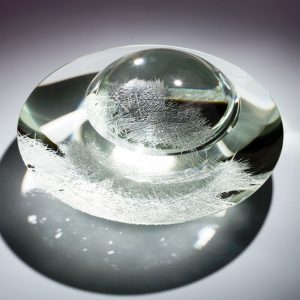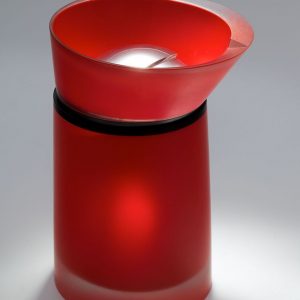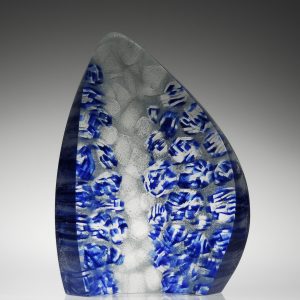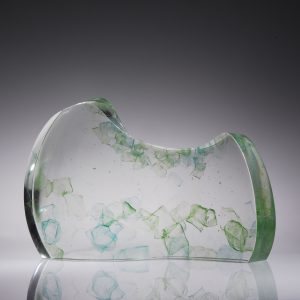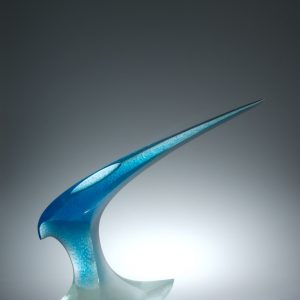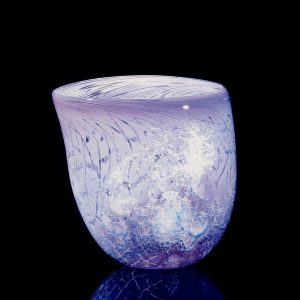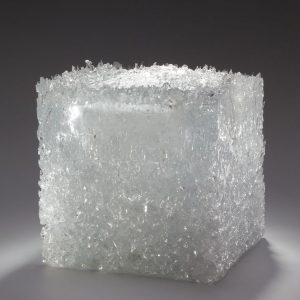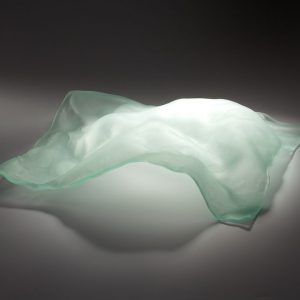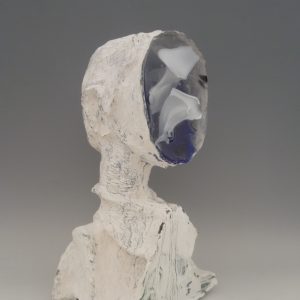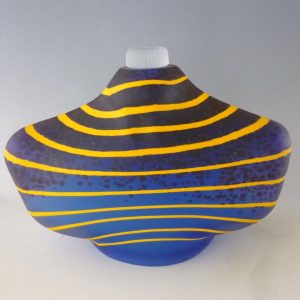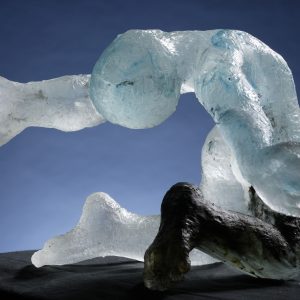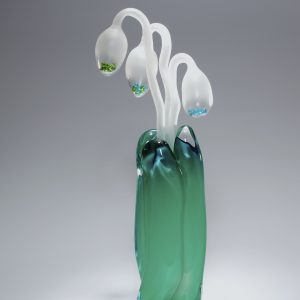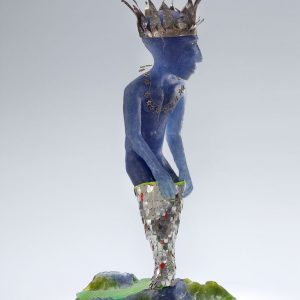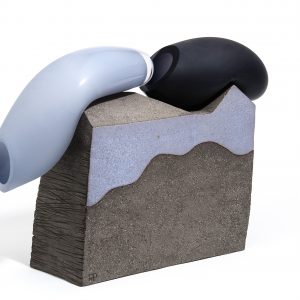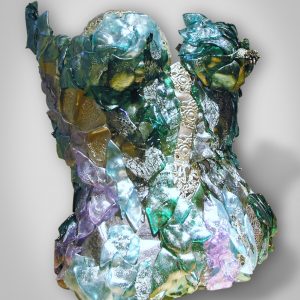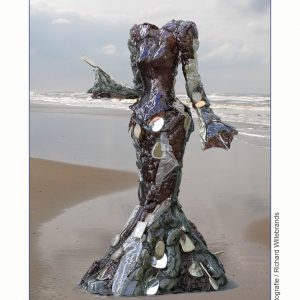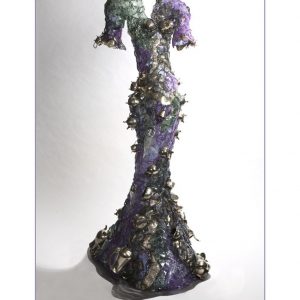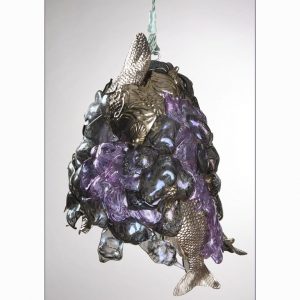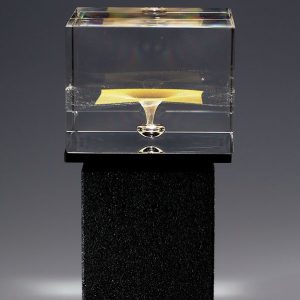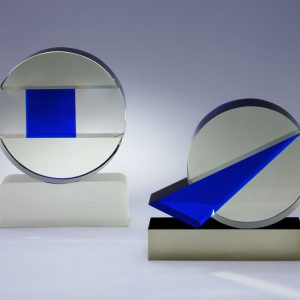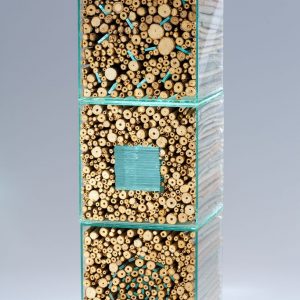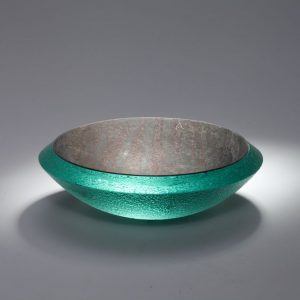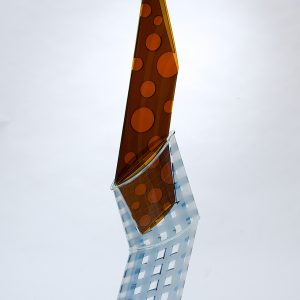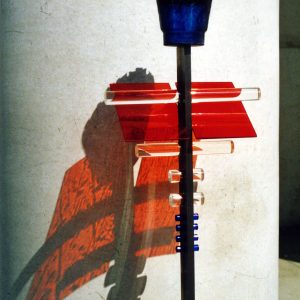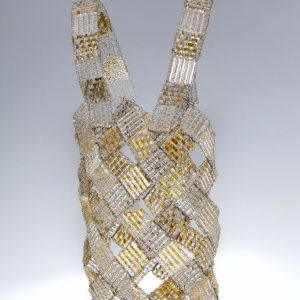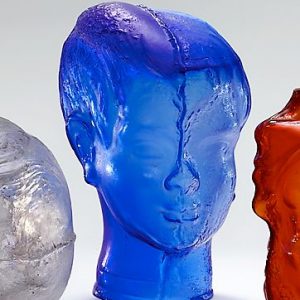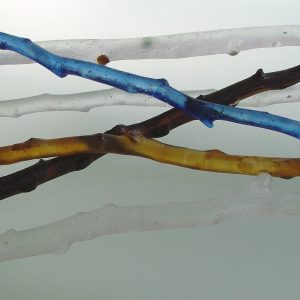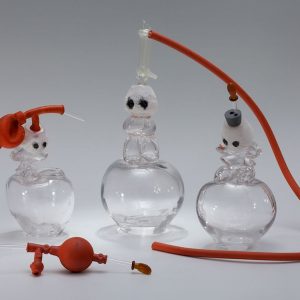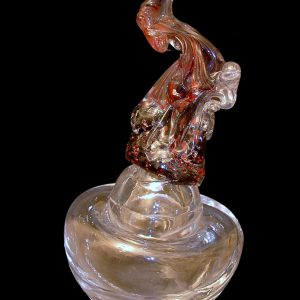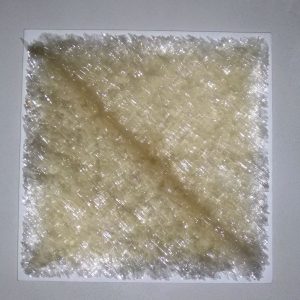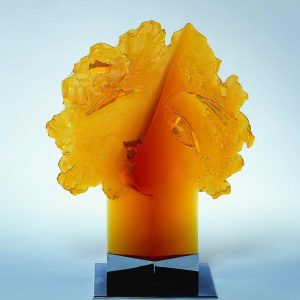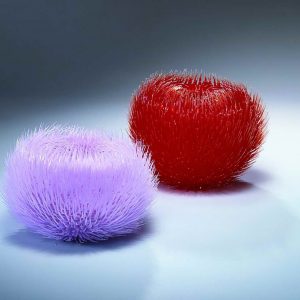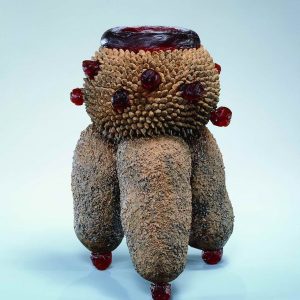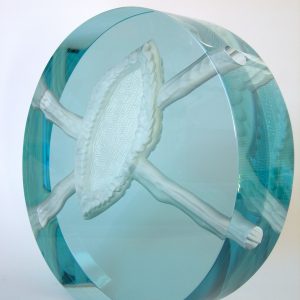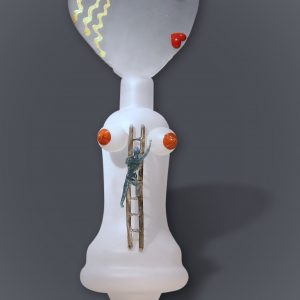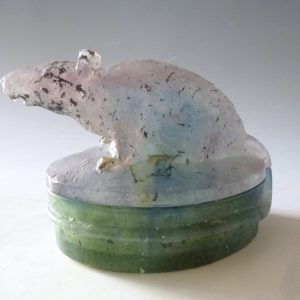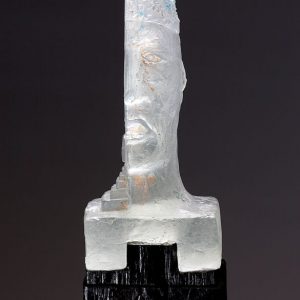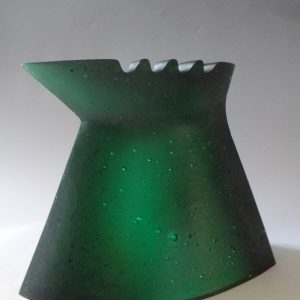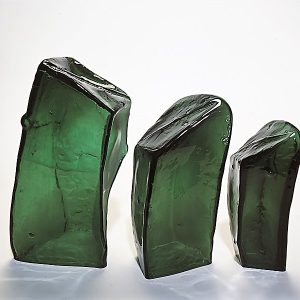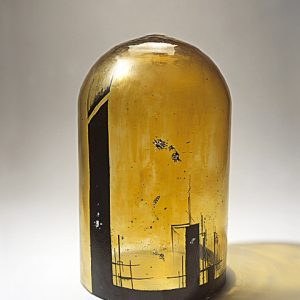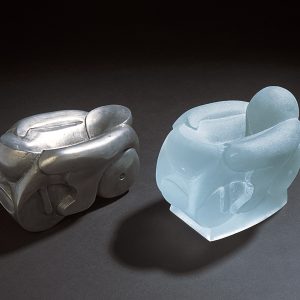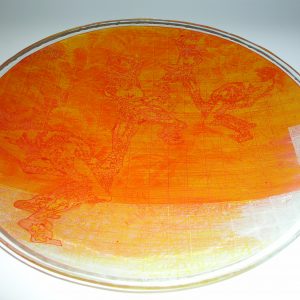2023
In Memory of Lilly Ernsting – Benefactor and Glass Collector
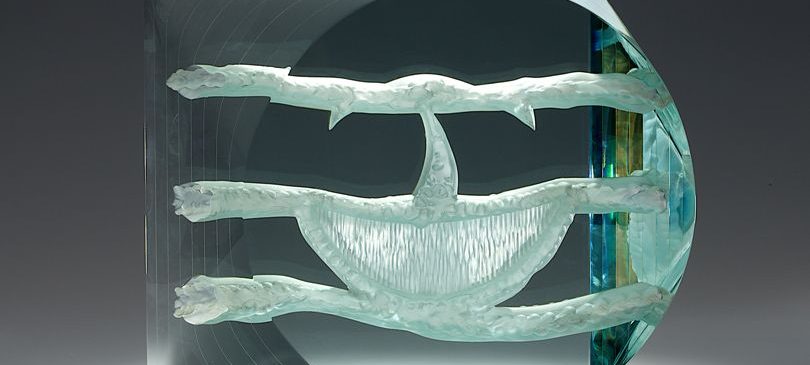
In Memory of Lilly Ernsting – Benefactor and Glass Collector
Lilly Ernsting (1930–2023) and her husband Kurt (1929–2011) were successful entrepreneurs and major benefactors and patrons of culture, education and social projects.
They also delighted in sharing their enthusiasm for contemporary art glass, opening hearts and arousing curiosity and interest in this particular genre of art. Over a period of nearly five decades, Lilly Ernsting steadily amassed a glass collection of world standing that will continue to be augmented after her passing.
Based on a desire to not keep their unique collection all to themselves but to share it with an interested public, the Ernstings founded the Glasmuseum in 1996 and the Glasdepot in Lette in 2006. Ever since then, the museum’s central mission has been to keep up with new trends in German and international art glass and to promote and exhibit the work of young glass artists. The Glasdepot furthermore offers visitors a chance to view the entire, continuously growing glass collection.
Back in the mid-1970s, as Lilly Ernsting was making plans for a hiking holiday in the Bavarian Forest, she could not have imagined how the trip would change and enrich her life. On a chance visit to a gallery with her husband, she discovered art glass for the first time. Instantly fascinated, she acquired her first glass object: a simple bowl by Willi Pistor. The spark was ignited that would trigger the creation of one of the most important private glass collections anywhere in the world.
Her curiosity aroused, Lilly Ernsting proceeded over the next few years to acquire examples of studio glass, a type of art that was still new at the time, at galleries, exhibitions and through personal contact with artists including Erwin Eisch and Theodor Sellner.
Her growing collection took a decisive turn when she met the charismatic Dutch gallerist Jaap de Harder in 1985: “An aesthete to the core, he introduced me to a whole new way of thinking as I felt and contemplated the beauty and quality of glass art: away from functional glass and toward glass objects and sculptural glass,” she later said of him. When Jaap de Harder died much too young in 1993, Lilly Ernsting took over his estate. With unabated passion, she continued to single-mindedly collect contemporary international art glass. She was assisted in her endeavours by the artist Mieke Groot until 2006 and by the managing director of the Ernsting Stiftung Alter Hof Herding, Dr. Ulrike Hoppe-Oehl, until today.
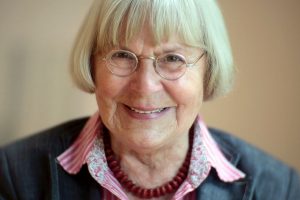 Lilly Ernsting belonged to the first generation of collectors of European studio glass, so that the history of her collection also traces the development that genre. Her motto was: Never look to the past! And thus she always directed her attention ahead to the latest trends on the glass scene, a strategy that has given her collection an independent and distinctive profile. As a collector, she had her own personal relationship with the works from the outset, often associating them with cherished memories. Each piece was for her a fresh discovery.
Lilly Ernsting belonged to the first generation of collectors of European studio glass, so that the history of her collection also traces the development that genre. Her motto was: Never look to the past! And thus she always directed her attention ahead to the latest trends on the glass scene, a strategy that has given her collection an independent and distinctive profile. As a collector, she had her own personal relationship with the works from the outset, often associating them with cherished memories. Each piece was for her a fresh discovery.
We are so very grateful that she allowed us to share in her journey through the exciting world of glass!
Photo above:
Ronald Fischer, Eine Arche auf Reisen, 2005 – Photo Horst Kolberg
Photos (from left):
Lilly Ernsting – Photo Martin Timm
Theodor G. Sellner, o.T., 1983 – Photo Ron Zijlstra / Mieke Groot, o.T., 2003 – Photo Ron Zijlstra / Richard Meitner, Fles, 1988 – Photo Ron Zijlstra / Wojciech Peszko, Archa III, 2008 – Photo Stanisław Sielicki
Stanisław Borowski, The Bird III, 2006 – Photo Sasa Fuis / Toots Zynsky, o.T., 1984 – Photo Ron Zijlstra / Simsa Cho, Spider Shoe, 1996 – Photo Ron Zijlstra / Ritsue Mishima, Tre Gole, 2009 – Photo Horst Kolberg
Stanislava Grebeníčková, Argema, 2011 – Photo Galerie Welti / Franz X. Höller, Paar VII, 2005 – Photo Horst Kolberg / Erwin Eisch, Der Lichtblick, 1981 – Photo Ron Zijlstra / František Janák, Capricorn I, 2005 – Photo František Janák
Gareth Noel Williams, Booster, 2003 – Photo Ron Zijlstra / Lieve van Stappen, Taufkleid, 1999 – Photo Ron Zijlstra / Deborah Hopkins, o.T., 1995 – Photo Ron Zijlstra / Therman Statom, o.T., 1989 – Photo Ron Zijlstra
To be on fire
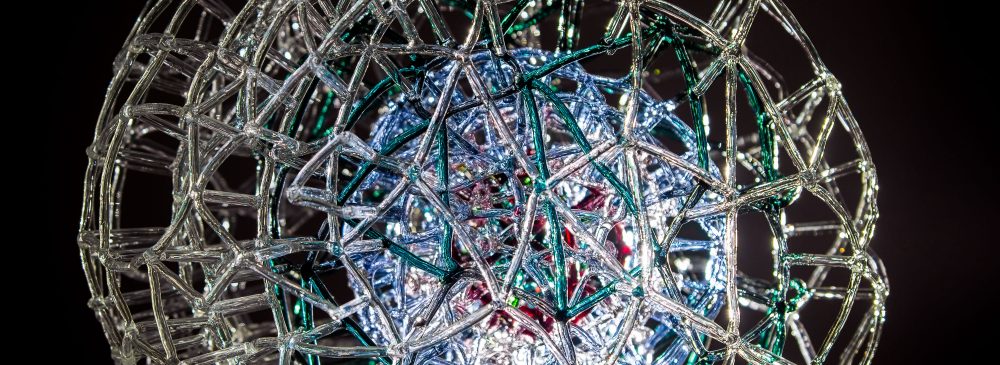
To be on fire
We regularly focus on a specific theme in order to introduce you to different glass art techniques, tracing their development and potential on the current art scene. So now, after last year’s show on cold glass techniques, we are taking a look at lamp glass in what is, incidentally, our third exhibition on this topic. There is good reason for revisiting this theme, because an expedition through today’s European lamp glass scene is an exciting one, full of new discoveries.
Lamp glass got its name from being blown freely over the open flame of a lamp rather than moulded in a furnace – although this designation can be misleading as today the flame comes from a gas burner. Up until the mid-nineteenth century, an oil lamp was actually used, equipped with an additional air supply.
Lamp glass is a very old technique, dating back to antiquity. The craft then began to flourish in the sixteenth century, radiating outwards from Venice. France, the Netherlands and Germany became additional key locations. Today, as in the past, the German centre of lamp-blown glass is the Thuringian Forest, specifically the town of Lauscha.
For a long time, lamp glass was considered the art of small objects, allowing craftspeople to perfectly shape beads, miniatures, ornaments and small vessels.
Ever since the early 1990s, however, the lamp glass scene has been spreading, and today it is sparking a revival of art glass on an unprecedented scale. The lamp glass technique has even been adopted by the youngest generation of artists. Artists’ enthusiasm for lamp glass is evident in the creative ideas they conceive for this technique and the resulting objects. With free, sculptural, and sometimes large-format pieces, they are revolutionising lamp glass, opening up new possibilities for modern art.
We have invited nine outstanding artists from different European countries to present their work. They all share a common technique, and yet the “world” in which each one works tells its very own story. This is demonstrated by their artwork.
Please join us in exploring the work of our featured artists: Falk Bauer, André and Rebekka Gutgesell, Krista Israel, James Lethbridge, Susan Liebold, JanHein van Stiphout, Christine Vanoppen and Nataliya Vladychko.
We also promise you a “déjà vu” experience with artists from our collection.
Photo above: Susan Liebold, Kugel 1, 2022 – Foto Ronny Koch
Photos (from left):
Nataliya Vladychko, Triticum, 2020 – Photo Steven van Kooijk
James Lethbridge, Nightingale’s Sorrow – a Covid 19 replica – Photo James Lethbridge
Falk Bauer, Reisigbündler, 2022 – Photo Falk Bauer
Christine Vanoppen, Infinity, 2019 – Photo Christine Vanoppen
Krista Israel, Good Hair Is 90% Of The Perfect Selfie, 2021 – Photo Steven van Kooijk Photography
Siobhan Healy, Herbarium, 2011 – Photo Lighthouse Photographics
Falk Bauer, Spinnennetz mit Insekten, 2023 – Photo Falk Bauer
James Lethbridge, Acanthus Veronese in Blue – Photo James Lethbridge
André Gutgesell, Familie 1, 2 + 3, 2018 – Photo Lutz Naumann
JanHein van Stiphout, Flora Venena (detail), 2005 – Photo JanHein van Stiphout
Rebekka + André Gutgesell, Let it Go, or the start of the journey, 2014 – Photo Rebekka Gutgesell
Susan Liebold, Freistehendes Objekt, 2023 – Photo Ronny Koch
NEW ACQUISITIONS 2021 / 2022
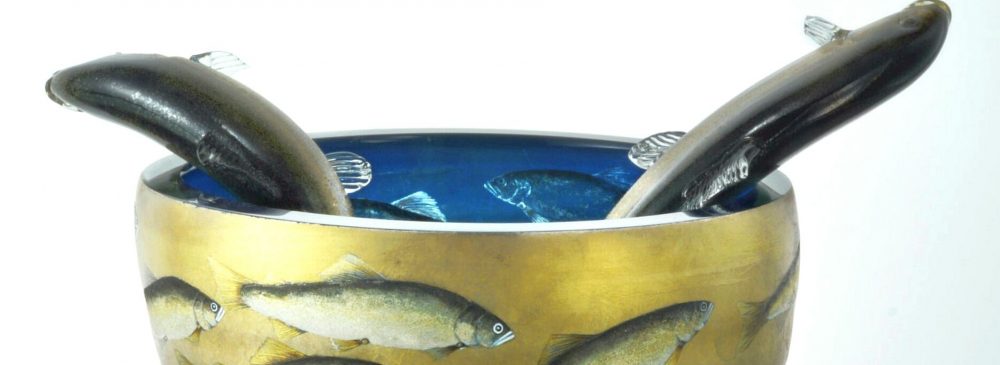
NEW ACQUISITIONS 2021 / 2022
We set out without luggage, always in search of new glass art, and we returned with bags full! Many artists have put the recent years of standstill brought about by COVID to good use as a highly creative phase for themselves. But they had to overcome considerable challenges, as the circumstances of the pandemic were not exactly congenial to carrying out artistic work processes with the material of glass. And yet they managed to find resourceful ways out of the crisis, as is noticeable in their new pieces. Once again, glass art proved its ability to thrive even under the most adverse conditions.
Sabine Nein, who lives and works in the Franconia region, has tellingly named her new work “Tunnel Vision (Light at the End of the Tunnel)”. She wished to give form to the idea that even in a seemingly hopeless situation, the light of hope can shine.
We have also become acquainted with the distinctive works of the multi-award-winning Japanese artist Hiroshi Yamano. One of the most influential artists on the Japanese glass scene, he is also highly respected worldwide for his wide-ranging skills and innovative techniques. Yamano’s art betrays the influence of Shintoism, a Japanese religion in which nature is experienced as divine. His works are gentle nature studies, showing flowers, birds, clear water and frequently fish, a personal symbol for Yamano. “I am a fish that is always looking for something. I am a fish that cannot stop swimming until my body stops moving,” says the artist, who has spent the past decades travelling the world and gathering inspiration.
We, too, have once more been inspired by the unusual new artistic discoveries we made on our travels to exhibitions, fairs and art events. Artists from all over the world showed their latest pieces there, presenting a wide range of objects, sculptures and installations based on diverse techniques and forms.
We are sure you will share our delight in the 60 or so new works that now enrich our collection – there are certainly some surprises in store amongst our 2021 and 2022 acquisitions!
Photo above: Hiroshi Yamano, New Fish Catcher #1, 2021 – Photo Hiroshi Yamano
Photos (from left):
Torsten Rötzsch, Varianten B 1.1.7, B 1.167.2, B 1.351 (1), 2021 – Photo Torsten Rötzsch
Ursula Distler, …sie sind unter uns…, 2021 – Photo Ursula Distler
Patrick Roth, H.R.G., 2022 – Photo Patrick Roth
Micha Karlslund, Triptych with Teen (2), 2020 – Photo Micha Karlslund
Reiner Eul, Gestörte Kommunikation, 2021 – Photo Reiner Eul
Robert Emeringer, Spring Flowers – Red Rose, 2021 – Photo Zaiga Baiza
Ursula-Maren Fitz, Schattenwelten II, 2021 – Photo Ursula-Maren Fitz
Sabine Nein, Tunnelblick (Licht am Ende des Tunnels), 2021 – Photo Hans Nein
Olga Pusztay, Geometrische Poesie, 2022 – Photo Zoltan Szalai
Wilhelm Vernim, o.T., 2022 – Photo Wilhelm Vernim
Remigijus Kriukas, Baobab, 2021 – Photo Marius Rudžianskas
Tracy Nicholls, Aulisca X, 2021 – Photo Amanda Rose
2022
Cold! Art glass using coldworking processes
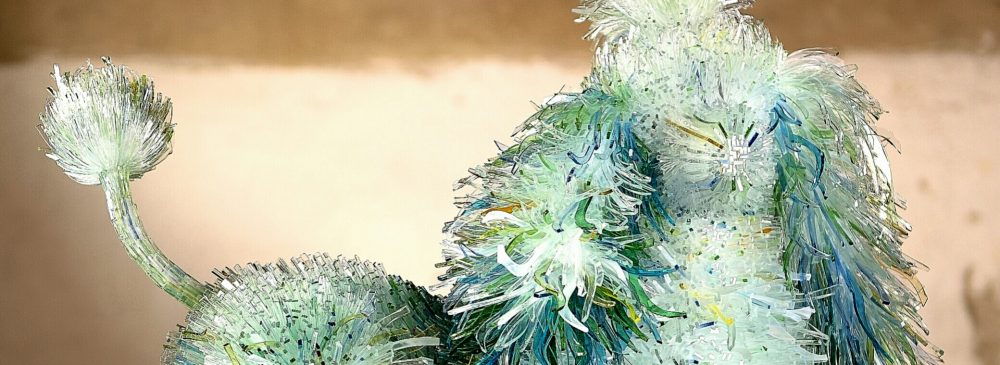
Cold! Art glass using coldworking processes
Poignant fragility and razor-sharp hardness, luminous colours and shining clarity – glass offers fantastic possibilities for creating profoundly expressive artworks that display both aesthetic and technical brilliance. Artists who work with glass do not rely solely on familiar processes such as casting and blowing the molten, i.e. hot, glass. On the contrary, once the glass has cooled down, it can be technically processed further at room temperature without further exposure to heat using methods such as cutting, grinding, polishing, engraving, etching, laminating, bonding, sandblasting, wiring and painting. These diverse steps that go into further shaping or finishing the cooled glass are subsumed under the collective term “coldworking techniques”.
From this so-called “cold glass” artists create astonishing works, a selection of which is on view at the Glass Museum Lette, arranged in groups. Some of the pieces are on loan from artists while others come from the museum’s own collection. Viewed together, they draw attention to the multi-faceted and diverse possibilities of coldworked glass.
Among the featured artists is Marta Klonowska, who has gained recognition on the international art market over the years with her unique animal sculptures and installations. Based on motifs in old master paintings, Klonowska constructs naturalistic animals and figures using metal armatures onto which she assembles countless precisely cut shards and rods of coloured glass. As if by magic, the cold, rigid glass is transformed into soft, lifelike bodies, putting creatures in the spotlight that are otherwise mere extras in the venerable paintings. Josepha Gasch-Muche for her part uses coldworking to create fascinating iridescent murals and three-dimensional objects made of splintered glass. To make them she breaks apart paper-thin, irregularly formed display glass and then layers the splinters over and next to each other, gluing them together invisibly. When light falls across the layers, the works take on a vibrant, almost sensual, air. They appear to move and change depending on the angle of incidence or strength of the light and the position of the viewer. Cuban artist Carlos Marcoleta is at home in diverse fields – including glass. With finesse and craftsmanship, he layers custom-cut pieces of satin-finished float glass to form a structure, an inversion of positive and negative form, for example in the portrait of a woman who seems to be trying to free herself from inside the glass panes. Marcoleta’s work continually changes its appearance with the viewing angle, allowing the observer to explore “Mujer 2” layer by layer.
These and other glass objects by masters of coldworking techniques interact with and enrich one another in a way that is rarely seen in exhibitions and which makes a visit to the Glasmuseum Lette all the more rewarding.
The current Coronavirus Protection Ordinance of the State of NRW applies!
Photo above: Marta Klonowska, Jeune Femme en Robe à la Polonoise after Pierre-Thomas LeClerc, 2019 – Photo Artur Gawlikowski, Galerie lorch+seidel contemporary
Photos (from left):
Josepha Gasch-Muche, T. 10-01-17, 2017 – Photo Josepha Gasch-Muche
Jens Gussek, Hammer und Sichel, 2016 – Photo Eric Tschernow, Galerie lorch+seidel contemporary
Carlos Marcoleta, Caribena-Mujer 2, 1997 – Photo Horst Kolberg
Masami Hirohata, Natura Morta, 2015 – Photo Eric Tschernow, Galerie lorch+seidel contemporary
Anne Knödler, Hoffnungsglück, 2014 – Photo Eric Tschernow, Galerie lorch+seidel contemporary
Gerd Kruft, Kubus mit Blau, 2006 – Photo Gerd Kruft
Judith Röder, Dickicht 2, 2017 – Photo Eric Tschernow, Galerie lorch+seidel contemporary
Marta Klonowska, Die Versuchung des Heiligen Antonius (Flötenspieler), 2008 – Photo Stephan Wieland, Galerie lorch+seidel contemporary
Jiří Harcuba, Chopin, 1982 – Photo Ron Zijlstra
Ronald Fischer, Ein Stück Unendlichkeit, 2005 – Photo Ronald Fischer
Olga Pusztay, Tasche, 2008 – Photo Zoltan Szalai
Katharine Coleman, Small Ruby Waterlily, 2014 – Photo Katharine Coleman
Alena Matějka
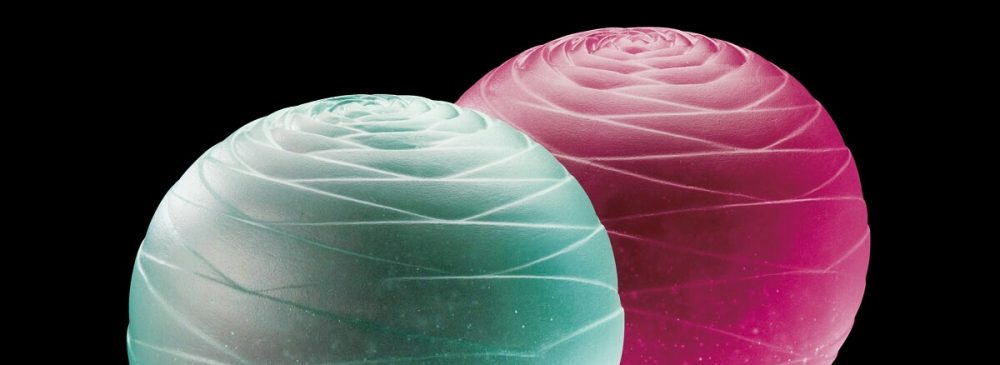
Alena Matějka
We all have our own unique view of the world, but few people have the desire, courage and talent to compellingly express their perceptions and share their ideas with others. Artists, on the other hand, have always delighted in fearlessly telling their stories, opening our eyes and broadening our horizons.
One such artist is Alena Matějka, a multi-award-winning sculptor and glass designer whose insatiable curiosity about life and joy in experimentation have enabled her to create an extraordinarily wide-ranging oeuvre. Her unusual sculptures, objects and installations are exhibited and collected worldwide.
Rather than working exclusively with glass, Matějka also incorporates other elements such as stone, marble, ice and organic materials, often in combination. But glass still occupies a special place in her work. In this medium she creates a fantastic cosmos of opposites, such as truth versus poetic imagination, compassion versus irony. Her impactful sculptures and installations confront viewers with great immediacy, sometimes having an unsettling effect and demanding a reaction. Matějka’s artful storytelling never presents us with a linear narrative but is instead rife with metaphors and unexpected twists. She is a master of exaggeration, paradox and provocation, making the tales she tells with her works all the more suspenseful and inspiring.
Alena Matějka was born in 1966 in the South Bohemian town of Jindřichův Hradec in the Czech Republic. After training at the Kamenický Šenov School of Glassmaking, she studied until 1997 in the glass class taught by Prof. Vladimir Kopecký at the Academy of Arts, Architecture and Design in Prague, earning her doctorate there in 2005. Today she lives alternately in the Czech Republic and Sweden with her husband, the stone sculptor Lars Widenfalk.
In our new exhibition, we invite you to discover Alena Matějka’s art, as powerful as it is poetic. On view are around 40 wall and floor installations, along with sculptures and work groups, all of which reflect the versatile artistic repertoire of this exceptional artist.
Photo above: Alena Matějka, Aimable Amie, 2008 – Foto Gabriel Urbánek
Photos (from left):
Alena Matějka, She is not me, 2018 – Foto Gabriel Urbánek
Alena Matějka, Water, 2020 – Foto Gabriel Urbánek
Alena Matějka, Moren Clai Moor of Ptarmigan + Barabas an Clachan of Kilmur, 1998 – Foto Hildegard Morian
Alena Matějka, Between Heaven and Earth, 2015 – Foto Ondřej Kocourek
Alena Matějka, Aimable Amie, 2008 – Foto Gabriel Urbánek
Alena Matějka, Feast (table), 2013 – Foto Gabriel Urbánek (Detail)
Alena Matějka, Feast (table), 2013 – Foto Gabriel Urbánek
Alena Matějka, The House of the Six Hawks, 2007 – Foto Ondřej Kocourek
Alena Matějka, Cuckoo´s Nest, 2015 – Foto Gabriel Urbánek
Alena Matějka, Rose, 2007 – Foto Gabriel Urbánek
Alena Matějka, Treasure Guardians, 2020 – Foto Gabriel Urbánek
Alena Matějka, My Dear, Hunter from Lavondyss, 2009 – Foto Gabriel Urbánek
![]()
![]()
![]()
Fernweh
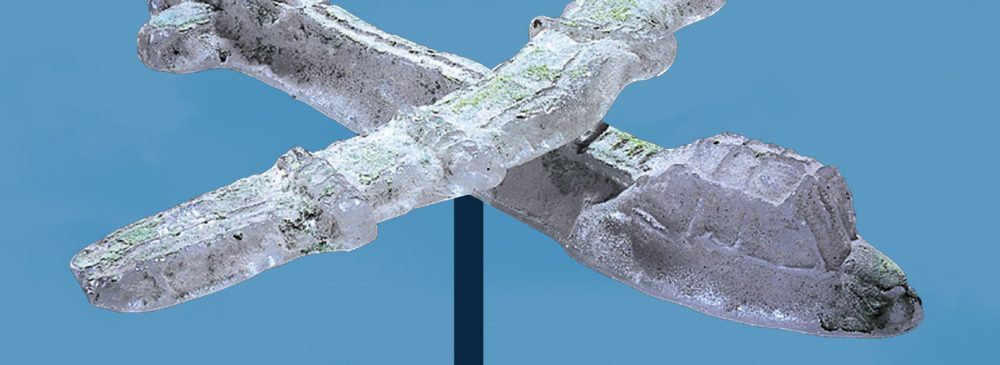
Fernweh
Fernweh – this term, akin to another German word that has come into common use in English, wanderlust, conveys a strong longing to leave one’s familiar surroundings and set off into the big wide world. But getting away has become complicated in these days of the coronavirus pandemic with all the travel restrictions, entry rules and quarantine regulations. Those who did travel over the past two years usually chose destinations closer to home. So the Fernweh we feel is undiminished!
Even before the term became common, people were well acquainted with the painful longing for far-off places. Goethe, for example, who was not yet familiar with the word, paraphrased it in 1822 as a “feeling of flight”, a “longing for far-off places” and “reverse homesickness”. With the concept of the “blue flower”, Romantic literature created a concrete symbol for this yearning, for the search for the unattainable and the infinite. The word Fernweh first appeared in literature around 1835, in a travel account by the famous writer and landscape architect Hermann Prince of Pückler-Muskau. He wrote that he “never suffers from homesickness (Heimweh) but rather from Fernweh”. The neologism quickly came into use in academic language as well as in poetry and art.
And then, in the twentieth century, the tourism industry seized upon the concept. Ever since then, Fernweh has been generated more or less artificially by means of targeted advertising featuring enticing images of tourist destinations around the world. It has thus become an important international economic factor. But Fernweh is not just about the urge to travel, as science has now discovered. It may simply reflect the desire for a change of scenery or some variety and colour in a more or less grey day-to-day life. Some of us may feel a diffuse restlessness, while others are unhappy and depressed. Travel promises an escape from this sense of unease, but when it is not possible, we can still immerse ourselves in fantasy worlds by way of books, the theatre or museum exhibitions. Scientists therefore also refer to Fernweh as an important “cultural technique for staying at home”.
This “cultural technique” of Fernweh has now inspired us to create a new exhibition. And the collection of the Ernsting Foundation has once again proven to be a treasure trove. We set out in search of appropriate works and ended up probing the entire spectrum of the collection. In the process, we discovered a wide range of different sculptures, objects, vessels and wall installations that each in their own way – sometimes whimsically, sometimes more thoughtfully – allude to other countries and cultures and evoke associations with the theme of Fernweh. A tour of the exhibition thus becomes an enjoyable journey to worlds both close-by and far afield.
In accordance with current regulations in the State of North-Rhine Westphalia, the 2G or 2G+ rule applies at the Glasmuseum and Glasdepot (2G: admission only with proof of vaccination against COVID-19 or recovery, 2G+: a negative PCR test is also required).
Photo above: Jens Gussek, Flugzeug, 1996 – Photo Ron Zijlstra
Photos (from left):
Gareth Noel Williams, Deep in my own world, 2001 – Photo Ron Zijlstra
Vittoria Parrinello, The perimeter of air, 2014 – Photo Vittoria Parrinello
Jens Gussek, Flugzeug, 1996 – Photo Ron Zijlstra
Gabriela Volna, Mensch und Wasser, 2003 – Photo Ron Zijlstra
Michael Behrens, Seaforms 2014-116, 2014 – Photo Paul Niessen
Dale Chihuly, Cerulean Blue Macchia, 1991 – Photo Glasmuseum Lette
Jens Gussek, Blue ship, 2004 – Photo Ron Zijlstra
Ned Cantrell, Tiger in a Tropical Storm, 2016, Detail – Photo Ned Cantrell
Winnie Teschmacher, Light of the soul, 2007 – Photo Louis Sonderegger
Irene Rezzonico, Armadillo cousin from Africa, 1998 – Photo Ron Zijlstra
Kati Kerstna, Drums 1+2, 2014 – Photo Glasmuseum Lette
Ivana Houserova, Butterfly, 2006 – Photo Tomas Hilger
2021
A Showcase of Excellence: Instructors at the Staatliche Glasfachschule Hadamar from the early days until today
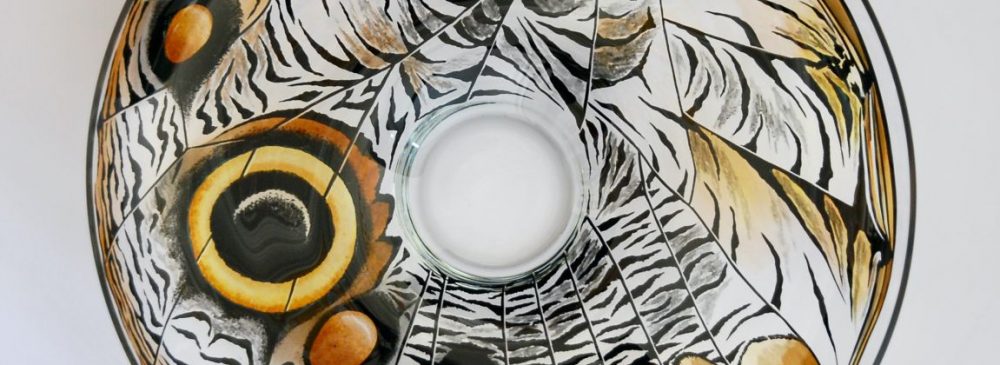
A Showcase of Excellence: Instructors at the Staatliche Glasfachschule Hadamar from the early days until today
“When the glass feels good while being cut, it starts to sing,” says Willi Pistor, a great pioneer in art glass and a former instructor at the Glasfachschule Hadamar. Like his colleagues at the school, Pistor ideally unites master craftsmanship with an artistic vision.
The heart’s desire of instructors at the school for glassmaking in Hadamar has always been to inspire young people with all the possibilities offered by this unique material. It thus comes as no surprise that many renowned glass artists studied and taught in Hadamar.
Located between Cologne and Frankfurt, the Glasfachschule Hadamar is today one of Germany’s best-known centres for glass processing and training. Always in step with the latest developments in glass technology, the school helps students to realise their potential and hone their expertise in the metier. It has succeeded in continually optimising its training programme in step with the changing requirements for professional practice in order to create an excellent setting for learning about glass.
The school was founded in 1949 on the initiative of glass workers who had been displaced from the glassmaking centres of northern Bohemia after the Second World War and settled in Hadamar and environs to set up new glass-processing businesses. Their aim was to teach young professionals their trade at a vocational school for glass, as had been customary in their homeland.
After presenting artworks by students at the Glasfachschule Hadamar in a special exhibition in 2019/20, we are now showcasing the mastery of instructors at the school. On view is a broad and exciting range of diverse pieces by 23 instructors who have worked as both educators and artists in Hadamar over the past seven decades. Some of them are currently teaching at the school and others used to hold a teaching position there or have since retired. The school’s very first pioneers who were involved in its establishment and development are no longer with us. This gives the works on display from the early years unique historical value. Reviewing the work of all of these artists allows us to trace how new techniques and processes have been continually assimilated and perfected in Hadamar.
We would like to convey our gratitude to Reiner Eul, who teaches glass painting, lead glazing and glass fusing in Hadamar and acted as an intermediary between the glass school, the artists, and the Foundation for this project. It is thanks to his commitment that we are now able to marvel at the wonderful creations by Hadamar’s instructors in the new exhibition!
Photo credits: Reiner Eul
Photo above: Andrea Hebgen, Brassolini-Caligo – Bananenfalter, 2021
Photos (from left):
Andreas Otto, Hommage, 1988
Thomas Kruck, Still Living On The Edge, 1995
Herbert Petters, o.T., Entwurf 1935-40, Ausführung nach 1953
Reiner Eul, Gestörte Kommunikation, 2021
Willi Pistor, o.T., um 1970 (undatiert)
Josef Welzel, Liegende Figur,1980
Carolin Schwarz, Staatspreis I, 2010
Hans Jorda, o.T. (Meisterstück),1965
Alfred Otto, Jagdszene, um 1972
Alexander Pfohl, Kristallglasteller, ca. 1928
Kurt Eiselt, Große Vase, 1966/67
Frank Ballowitz, Namnam, 2021
EXHIBITIONS AND COLLECTION 2016–2020
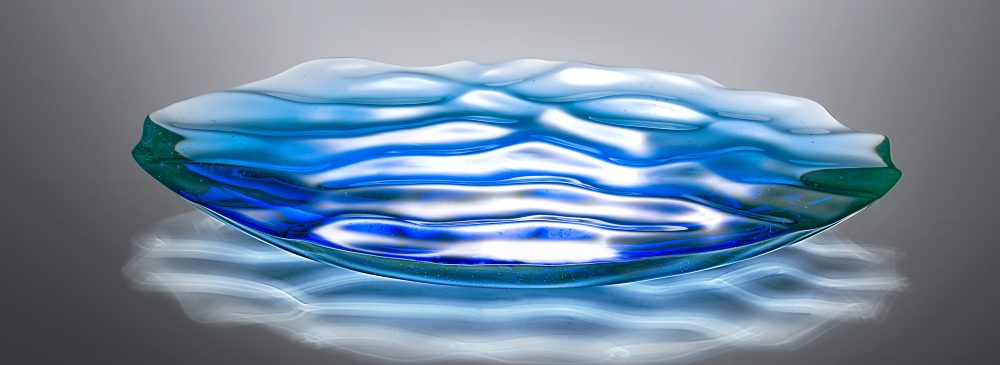
EXHIBITIONS AND COLLECTION 2016–2020
In 2021, collector Lilly Ernsting, the founder of the foundation, will be able to look back on 25 years of exhibiting and collecting! Reason enough to kick off the new year at the Glasmuseum Lette with a special exhibition. On view is a selection of objects acquired over the past five years at exhibitions and on our travels. A catalogue offering insights into the museum’s activities during this period accompanies the show.
A series of in-house exhibitions and numerous journeys made across Europe bear witness to several busy years of collecting. During those years, 270 objects found their way into the collection. From this rich assortment, we have chosen 60 pieces that illustrate our broad-based exhibition and collection concept. The current show displays all the vibrancy and diversity of the collection itself, like a multi-coloured kaleidoscope revealing the exuberant creativity of the glass scene. These glass objects thus serve as a mirror of developments in art glass, in artistic concepts and in the applied techniques.
The catalogue tells the story of how the exhibitions and the numerous objects housed at the Glasmuseum Lette came together over the past five years, sometimes in a summary, sometimes in brief artist monographs. The value of Lilly Ernsting’s maxims is born out here: direct contact with artists, frequent visits to galleries and museums, examining objects on site, and talking with all those involved. Only in this way is it possible to maintain the continuity and quality of the exhibitions and collection. In the course of many trips during the past years, existing contacts were rekindled and new ones made, often resulting in new projects. Contemplating the outcome of the exhibition and collection activities and looking back on the origins of what was still a modest private collection in the 1970s, one can only agree with Lilly Ernsting: “Who would have thought!”
Photo above: Alena Matejka, Water, 2020 – Foto Gabriel Urbánek
Photos (from left):
Lars Widenfalk, La Greca, 2019 – Photo Gabriel Urbánek / László Lukácsi, FAN, 2019 – Photo Liza Lukácsi / Carol Milne, Purple Reigns, 2016 – Photo Carol Milne / Josef Marek, Fusion, 2019 – Photo Jirí Koudelka /
Anna Torfs, Parts High – Crystal Gold, 2017 – Photo Jaroslav Kvíz / Julius Weiland, Down the Rabbit Hole, 2017 – Photo Eric Tschernow / Antoine Pierini, Vestige Contemporain (VEC1A2), 2017 – Photo Gaëlle Pierini / Jan Surýnek, Igel, 2014 – Photo Glasmuseum Lette /
Thomas Kruck, Treasure Box, 2013 – Photo Thomas Kruck / Stanislaw Jan Borowski, Sweet delight VS The Pinch a bit Bear, 2013 – Photo Grzegosz Matoryn / Alison Allum, Twitter Troll, 2018 – Photo Glasmuseum Lette / Iris Haschek, Fadenwesen, 2018 – Photo Iris Haschek
2020
Antoine Pierini and Friends
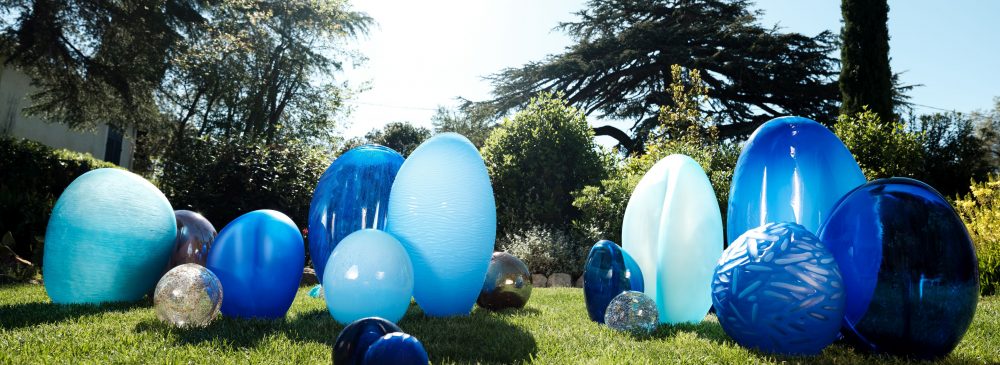
Antoine Pierini and Friends
The small town of Biot in Southern France, located between Cannes and Nice in the Alpes Maritimes region, is considered the French capital of contemporary glassmaking. A number of highly skilled glassmakers have their place of work there. Among them are Robert Pierini, his son Antoine and Antoine’s wife Gaëlle, true enthusiasts who are devoted heart and soul to this fascinating material. The family members have long worked hand in hand very successfully for their own company: the Pierini Glass Art Center.
The Pierini family success story goes back to 1980, when Robert Pierini, a pioneer of the studio glass movement in France, and his wife Francine discovered an old olive oil mill from the fifteenth century at the foot of the town of Biot. They immediately recognised the potential of this magical place. After purchasing and renovating the historical building, they set up their glass studio here. Their son Antoine was born in 1980 and grew up in this extraordinary setting, watching his father at work with growing interest. By the age of ten he was already able to wield his father’s utensils, such as pipe, wood block and shears. But he learned more from his father than just the basic techniques and knowledge of glassmaking – he also discovered the joy of mastering this molten material. Antoine later continued his training by taking courses, doing residencies, and working in various artists’ studios and at museums and art centres in the USA, Japan and Europe.
Travelling and meeting the biggest names on the international glass scene enriched and refined Antoine Pierini’s own artistic vision. The prime themes in his work today are the richness and fragility of the natural and cultural heritage of the Mediterranean region: “I try to capture with my glass sculptures the ancestral and ephemeral poetry of Mediterranean cultures and landscapes.” Antoine Pierini has developed his own signature style, creating pieces that captivate with both their colours and shapes. His working method combines traditional skills with cutting-edge experimentation, and he likes to call himself an “artist of matter” who lends his creations a sensitive and poetic depth.
The Pierini family’s many encounters with international artists inspired them to establish their own artist-in-residence programme. Artists who share the Pierinis’ passion for glass flock to Biot from all over the world to work in the studio at the Pierini International Glass Art Center. Here they find an ideal setting for sharing ideas with other artists as they develop and produce new works that then have their public debut in the Art Center galleries.
In 2005, Antoine and his wife Gaëlle took over the management of the family business. But this transfer of responsibility did not really change anything in the daily life of the family, as father Robert still works side by side with his son Antoine and the other artists.
We are very much looking forward to a rendezvous with “Antoine Pierini and Friends”. Bienvenue!
Photo above:
Antoine Pierini, Dunes (Installation-blue) – Photo Ilan Dehe
Photos:
Antoine Brodin, Hypnos, 2018 – Photo Antoine Brodin
Robert Pierini, Plume, 2001 – Photo Gaelle Pierini
Raven Skyriver, Hyppocampe, 2018 – Photo Galla Theodosis
Rob Stern, Solares, 2019 – Photo Ilan Dehe
Nicolas Laty, Snake Berlingot, 2018 – Photo Nicolas Laty
Antoine Pierini, On the Rock, 2017 – Photo Ilan Dehe
Kelly O’Dell, Homard, 2018 – Photo Galla Theodosis
Gabe Feenan, Squiggle tea, 2018 – Photo Loic Bisoli
Ethan Stern, Blue Fraction, 2018 – Photo Loic Bisoli
Ondrej Novotny, Speculum Multicolor, 2019 – Photo Ilan Dehe
Ethan Stern, Blue Fraction, 2018 – Photo Loic Bisoli
Léo, Toa (P1010859), 2019 – Photo Leo
Galla Theodosis, Tears of Dionysos, 2018 – Photo Galla Theodosis
NEW ACQUISITIONS 2019
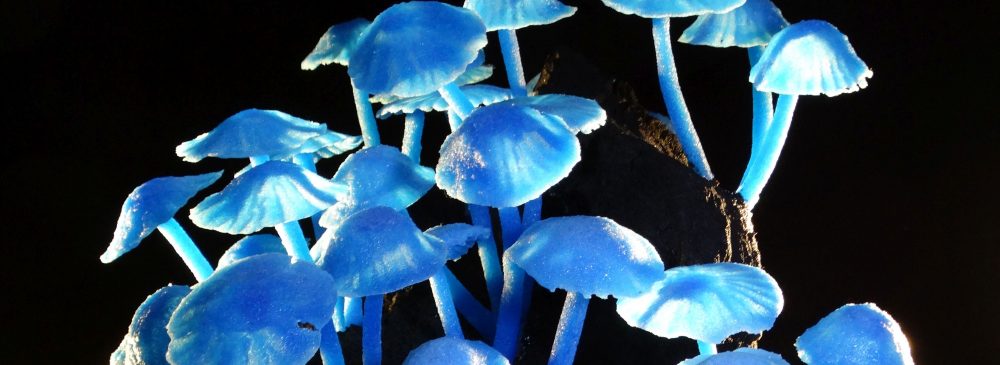
NEW ACQUISITIONS 2019
“I love images arising in me which describe situations or relationships. To bring them into the glass is joy. With the glass, the light and sometimes the inner touch.” This is how Heikko Schulze Höing describes his work with the artistic medium of glass. Last year we were able to acquire for our collection his multi-layered graal vase “Herz der Finsternis” (Heart of Darkness), which won first prize in the prestigious Immenhäuser Glaspreis 2019 awards. The shadowy cameo engraving is reminiscent of cut-out silhouettes, with a further dimension added by an inner motif of people fleeing. We were also impressed by the work that took third place, “Fadenwesen” (Thread Creatures) by Iris Haschek. Here, she masterfully pushes the pâte de verre technique to its limits: delicate azure-blue mushrooms grow up out of charred wood, evoking the eternal circle of life, death and rebirth.
Our quest for exciting glass art took us to some special events this past year. The British Glass Biennale 2019 in Stourbridge, for example, was a real highlight! We were able to acquire some fantastic works, including “Curled over” by Nina Casson McGarva. The young artist was born in England but grew up in rural Burgundy in France, so it is no wonder that natural phenomena in all their variety are her great inspiration. She says that “to me the material is most alive when it’s hot and being transformed. The end result is solid and doesn’t move any longer; it is at the fragile time before disintegration and maintains a dynamic form and rich structures such as dry leaves, feathers or sea shells.” Allister Malcolm’s vase object “Bubble-Wrap” also caught our interest with its distinct flair for design and flawless workmanship. Malcolm was inspired here while diving, observing underwater how the bubbles released with each breath ascend to the surface.
In the Netherlands we made another exciting discovery: Han de Kluijver, an architect who has also worked as a glass artist for many years. His efforts have now been crowned with success, as he was awarded first prize in the competition Glasplastik und Garten (Glass Sculpture and Garden) hosted by the City of Munster! Each one of his glass objects resembles an architectural creation: a fixed form in space. The work of the Japanese artist Masayo Odahashi is by contrast more sculptural. Her meditative figures, mostly young girls, seem to look inward, radiating a quiet strength, as if they could guide us to greater inner peace.
We present to you these and other fascinating new works in our first exhibition of 2020. Be prepared to make some delightful discoveries!
Photo above:
Iris Haschek, Fadenwesen, 2018 (Photo Iris Haschek)
Photos:
Han de Kluijver, Mesocosm, 2010 (Photo Tomas Hilger)
László Lukácsí, FAN, 2019 (Photo Liza Lukácsí)
Masayo Odahashi, In my hands II, 2018 (Photo Galerie B)
Simone Fezer, Cell (Serie Organix), 2014 (Photo Simone Fezer)
Heikko Schulze Höing, Herz der Finsternis, 2019 (Photo Peter Hübbe)
Tomáš Brzoň, Shark, 2015 (Photo Jiří Koudelka)
Nina Casson McGarva, Curled over, 2019 (Photo Nina Casson McGarva)
Allister Malcolm, Bubble-Wrap, 2019 (Photo Simon Bruntnell)
2019
Free and applied glass art from the Staatliche Glasfachschule Hadamar
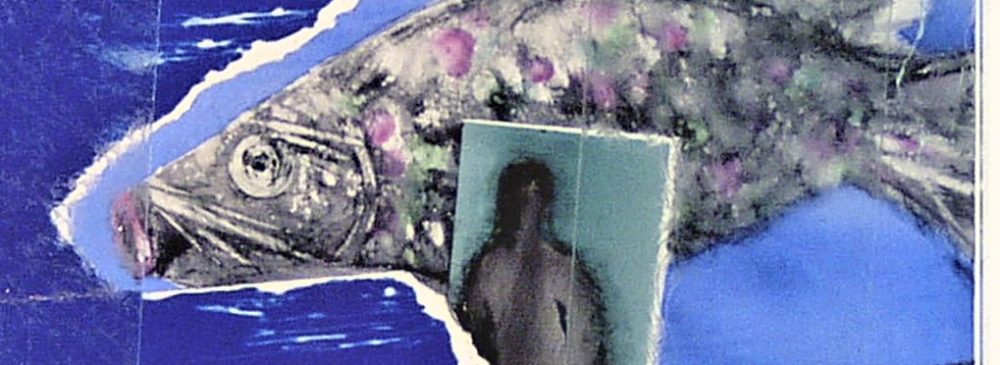
Free and applied glass art from the Staatliche Glasfachschule Hadamar
The small Hessian town of Hadamar, idyllically set at the edge of the Westerwald forest between Cologne and Frankfurt, has been home to a modern training centre for glass technology and glass design since 1949.
The Staatliche Glasfachschule Hadamar is today one of the best-known training and glass-processing establishments in all of Germany. It was founded in 1949 on the initiative of glass workers who had been displaced from the glassmaking centres of northern Bohemia after the Second World War and settled in Hadamar and environs and established new glass-finishing businesses there. Their aim was to teach young professionals their trade at a vocational school for glass, as had been customary in their homeland.
Thanks to forward-looking management with a finger on the pulse of the glass industry, the school has succeeded in continually optimising its training programmes to fit the latest developments and requirements of professional practice. In addition, the school’s directors and teachers have regularly had a say in amending the training regulations and framework curricula for the glass working and processing professions, thus creating excellent conditions for training.
The school’s fine reputation enables it to attract young people from all over Germany to Hadamar, and not infrequently also from neighbouring European countries as well as Asia and Africa. They come here to learn a glass-processing or industrial occupation, to do advanced training in the various techniques, and to work creatively with glass.
The multi-year full-time vocational school offers foundation training in the professions of glazier, glass apparatus maker, and glass finisher (edge and surface finishing, glass painting and art glazing). Other school forms in the Hadamar complex are a two-year technical college, a school for apprentices, and a preparation course for the master craftsman exam offered by the Federal Association of Glazier Trades (BIV).
But beyond the trade aspects, working with glass as a material gives students the opportunity to find their own means of creative expression. It thus comes as no surprise that many distinguished glass artists have come out of the Glasfachschule Hadamar.
In our new exhibition we present some 50 works by both graduates and current students at the school. The artists all have one thing in common: a perfect command of the various glass techniques, which they apply to reinterpreting and even breaking the rules they learned at the Glasfachschule Hadamar, each in their own way. The works on view are abstract, sculptural, narrative, ironic, or simply beautiful – unfolding a broad kaleidoscope of artistic skill and creativity!
Photo above:
Alexandra Lesch, Fischdrache, 2002 (Photo Alexandra Lesch)
Photos:
Elvira Bach, o.T., 1985 (Photo Derix Glasstudios, Taunusstein)
Fritz Prehal, Gegen den Strom, 2014 (Photo Lena Prehal)
Elisa Ekler, Schmetterlings Kronenleuchter, 2017/18 (Photo Elisa Ekler)
Gabriele Küstner, Deckelgefäß 3.B.2007, 2007 (Photo Max Hundertmark, Fotostudio Maxwell)
Samuel Weisenborn, Destruction, 2019 (Photo Samuel Weisenborn)
Thomas Kruck, Treasure Box, 2013 (Photo Thomas Kruck)
Sandra Urban, Seelenverwandte, 2017 (Photo Reiner Eul)
Jochen Härter, o.T. (Wettbewerbsarbeit), 2017 (Photo Reiner Eul)
Glass Generations
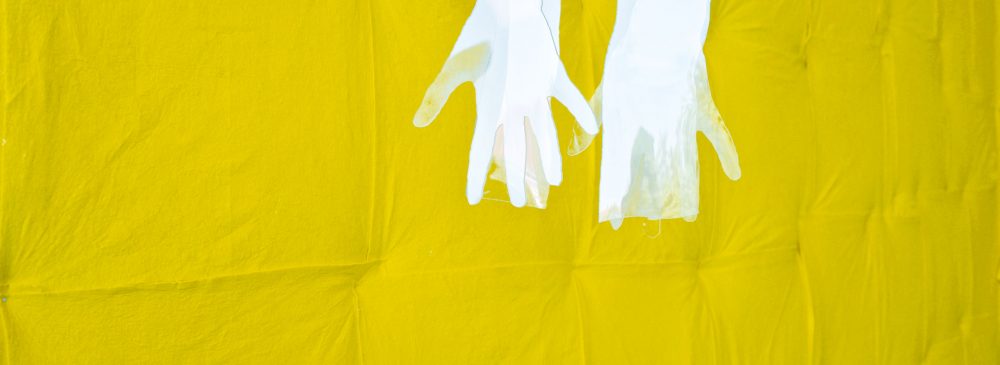
Glass Generations
The Gerrit Rietveld Academie in Amsterdam, an independent college of fine arts and design, has been home to a close-knit community of students from all over the world for the past 50 years. Students and teachers work together here to create a learning environment where theory and practice coincide, giving rise to unexpected ideas. The academy hones the skills of talented young artists to enable them to work independently in the field of fine arts or design.
Glass has always played an important role at the Gerrit Rietveld Academie. The glass department was founded in 1969 by Sybren Valkema, who coined the term “free glass” to distinguish glass designed and made by artists from what Americans call “studio glass”. Thanks to his pioneering work, the worlds of teaching and art have been able to cross-fertilise one another. The glass department at the Rietveld Academie takes a strongly conceptual approach, viewing glass as a sculptural material for contemporary art. The department’s new name is telling in this respect: “The Large Glass”, borrowed from the title of a work dating to 1915–1923 in which the artist Marcel Duchamp used glass for the first time in a conceptual artwork.
The students hence do not see themselves as glass artists but rather as fine artists who happen to work with glass. They are encouraged to work freely and to explore the possibilities offered by the material, challenging it and pushing it to its limits. Technique is a tool here rather than an end in itself. Nevertheless, basic skills are taught throughout the course of study: art theory, conceptual thinking, hot and cold glass techniques (blowing, casting, grinding, sandblasting, mould-making, etc.). The focus is on each student’s own individual artistic approach and on teaching the practical and theoretical knowledge required to be an artist.
With our latest exhibition we congratulate the academy on its 50th anniversary and present exceptionally freeform objects, wall pieces and installations by eleven young graduates. These recent works are accompanied by numerous pieces from the collection of the Glasmuseum Lette, the only institution in the German-speaking world to present an extraordinary cross-section of works produced by the glass department at the Rietveld Academie. The exhibition thus functions as a satellite show for the anniversary year, conveying the development of glass art over the past 50 years at academy.
Jens Pfeifer, who has been head of the glass department there since 2011, graciously invited us to undertake this project. Thanks to his initiative we are also able to demonstrate to our own audience the potential displayed today by the Rietveld Academie!
Photo above:
Mirre Yayla Séur, When Memory Enters, a Midwife as a Metaphor (The Pretense of Presence), 2018 (Photo Kit Séur)
Photos:
Katrien Van Liefferinge, „…Blood, Sweat, and Tears“, 2017 (Photo Katrien Van Liefferinge)
Marie De Bruyn, The process and its object, 2011 (Photo Marie De Bruyn)
Jenny Ritzenhoff, Lover 11 – 127 #reconstruction 1, 2017 (Photo Jenny Ritzenhoff)
Geir Nustad, Street view – Mother, son, soldier, 2014 (Photo Geir Nustad)
Jens Pfeifer, Bohemian cut 1, 2013 (Photo Jens Pfeifer)
Gareth Noel Williams, Deep in my own world, 2001 – Collection Glasmuseum Lette (Photo Ron Zijlstra)
Richard Meitner, Jumbo Lights, 2003 – Collection Glasmuseum Lette (Photo Ron Zijlstra)
Mieke Groot, o.T., 2003 – Collection Glasmuseum Lette (Photo Ron Zijlstra)
Taking Off – Hungary’s Young Glass Scene
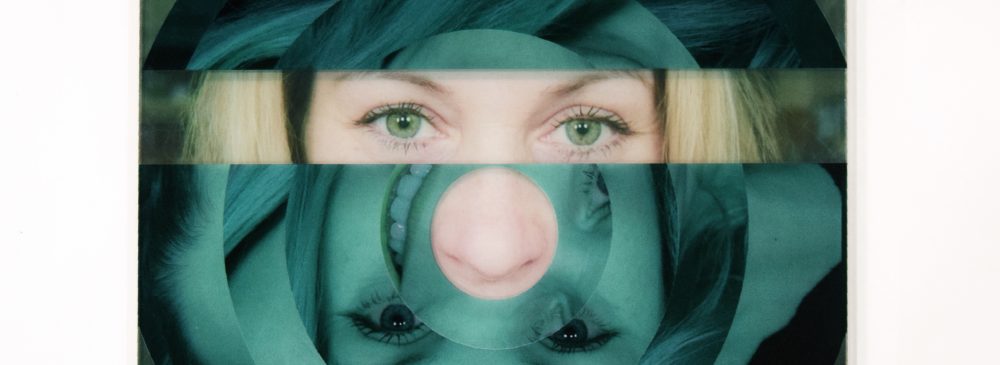
Taking Off – Hungary’s Young Glass Scene
Hungary’s glass scene is still young, and it’s off to a grand start.
Masterpieces by Hungarian glass artists are now in high demand, and major international museums and private collectors often have to wait a long time to acquire world-class works. This wave of interest comes as no surprise, as many Hungarian artists have already won top international prizes.
Nevertheless, glass art in Hungary has had to find its own unique path, which could not take its cue from the international studio glass movement. Although there were some folk art traditions and small-scale glassmaking, mass production dominated the country’s glass industry from around 1948 to 1990. Afterwards, many glassworks were forced to shut down due to privatisation, and thus they did not play an important role for either the industry or training in contemporary glass art.
Of enormous importance by contrast is the first-class education that has been available in Hungary since the 1950s and 60s at technical schools, academies and the Moholy-Nagy University of Art and Design Budapest (MOME). Zoltán Bohus, master, teacher and pioneer, has been a seminal figure for the development of autonomous glass art in Hungary, rapidly rising to world fame with his architectural sculptures made of cold-worked glass.
Surprisingly, the country’s glass art has yet to attract much recognition in Hungary itself. Hungarian museums for the most part show only design glass and display more interest in antique pieces than in modern studio glass. Although there are a number of active professional glass artists in Hungary, most of them work alone in their own studios and workshops. It is difficult for them to network with each other because there are very few specialised galleries, exhibitions or fairs where artists might freely exchange ideas and find mutual inspiration. Moreover, most of the pieces on display make their way straight to foreign galleries. The sole glass gallery – the Hefter Gallery – is located in the western town of Pannonhalma. Otherwise, works by Hungary’s glass artists can be found only in a handful of art galleries that do not specialise in glass. This means that the artists don’t often get the chance to see the work of their colleagues.
The Hungarian Glass Arts Society (HGS), founded in 1996, is the most active organisation devoted to autonomous glass art. Since 2012, it has been mounting the internationally acclaimed “HuGlass” exhibition every three years. The aim is to present the various areas of glass art to the public and to give members the opportunity to show their work in a professional context in order to attract the attention of the art market. Artistic work in glass is extremely versatile in Hungary, but all artists share a high professional standard in applying glass techniques and processes and the desire to develop their own personal form of visual expression.
Our new exhibition is devoted to presenting this young and lively glass scene to a wider audience. Around 55 works by 27 artists will be on view – including sculptures, objects and installations by both world-renowned artists and promising representatives of the younger generation. All of them are members of the Hungarian Glass Arts Society (HGS).
Our sincere thanks to the Hungarian artist and curator Zsuzsanna Kóródi, who displayed great dedication in making this presentation of Hungarian glass art possible.
Photo above:
Judit Grünfelder, Can´t Find, 2019 (Photo Judit Grünfelder)
Photos:
Rita Bánó, Blue peach, 2019 (Photo László Spengler, Lili Sziráki)
Bernadett Hegyvari, Above and below 01, 2019 (Photo James Carcass)
Zsuzsanna Kóródi, Grid VII., 2018 (Photo Zsuzsanna Kóródi)
Zoltán Bohus, Autum I, 2015 (Photo Réka Bohus)
Dóra Varga, Boov 2, 2017 (Photo Zsuzsanna Kóródi)
Kyra László, w.omens 04, 2017 (Photo Kyra László)
Péter Borkovics, Blue yellow 2, 2017 (Photo Péter Borkovics)
Endre Gaál, Golden age 7, 2019 (Photo Endre Gaál)
György Gáspár, Plan, 2017 (Photo Zsuzsanna Kóródi)
Birgit Köblitz, Der Kurgast (H.H.), 2018 (Photo Éva M. Fodor)
Vajk Farkas, Green Stripe, 2017 (Photo Vajk Farkas)
Eszter Bősze, Flow Motion II., 2018 (Photo Tamás Szelestey)
New Acquisitions 2018
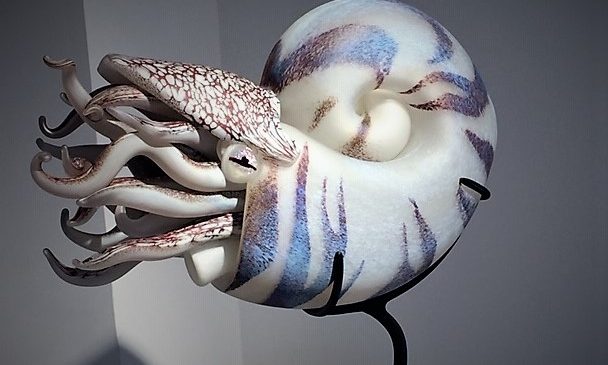
New Acquisitions 2018
A true treasure trove for first-class art this year was the exhibition YOUNG GLASS at the Glasmuseum Ebeltoft in Denmark. This event is held every ten years in the form of an international competition honouring young creative talent. The show has thus become an important point of reference for glass artists all over the world. Works by 57 artists from 18 countries were presented. One of the many stunning objects on view was Bjørn Friborg’s “BBC”, which was awarded the prestigious Finn Lynggaard Preis 2017 at the exhibition. Carrying on the traditional art of glass blowing while taking it to new extremes – this is the balancing act the Danish artist masters brilliantly.
In the famous “Glasriket” (Kingdom of Crystal) in the province of Småland in southern Sweden, Mattias Stenberg impressed us as a true all-rounder, a multi-award-winning artist, designer and architect who also boasts a degree in engineering. Despite a lifelong love of glass, he only made his debut as a glass designer in 2016, with his “Septum” series for Kosta Boda. These highly aesthetic objects, painstakingly produced by means of a prolonged process, stand for Stenberg’s artistic philosophy: clarity in concept, form and material.
The art of glass enjoys a high standing in the south of France as well. In Biot, renowned as a traditional centre for glassmaking, the Pierini family’s glass studio stands out from the rest. Robert Pierini and Alain and Marysa Begou count among the pioneers of glass art, and examples of their work have long since joined the collection of the Glasmuseum Lette. The younger generation is also gifted with creative talent. Antoine Pierini, born in 1980 in Antibes into this distinguished artist family, turns to nature and his Mediterranean cultural heritage for inspiration, as is plain to see from the impressive glass amphorae he calls “Vestiges Contemporains”: “My work invites the viewer to step back in time to the fascinating early years of antiquity; it reinterprets the magic of rituals, objects and symbolic artefacts used by women and men of different cultures all around the Mediterranean Sea.”
The Foundation was also delighted to make some new discoveries in its own exhibitions during 2018: “Japanese Glass Today” was especially popular, with the extraordinary Japanese aesthetic captivating both us and the visitors alike.
We would like to take this opportunity to draw your attention to three exhibitions coming up in 2019: In May we will present an exciting glimpse of the current Hungarian glass scene, in summer we are planning a joint exhibition with the Dutch Academy of Fine Arts to mark the 50th anniversary of the Gerrit Rietveld Academie Amsterdam, and in autumn students from the Glasfachschule Hadamar in Hessen will show their works here for the first time!
Photo above:
Kelly O´Dell + Raven Skyriver, Biot Nautilus, 2018 (Photo: Glasmuseum Lette)
Photos:
Sachi Fujikake, Vestige II, 2016 (Photo: Sachi Fujikake)
Natsuki Katsukawa, Microworld Specimen, 2016 – „Stanislav Libenský Award 2016“ (Photo: Natsuki Katsukawa)
Nicolas Laty, Glassy Puppy, 2017 (Photo: Glasmuseum Lette)
Jan-Erik Ritzman, Face Arial 1, 2017 (Photo: Glasmuseum Lette)
Mattias Stenberg, Septum Stor F, 2018 (Photo: Kosta Boda/Jonas Lindström)
Björn Friborg, BBC, 2016 – „Finn Lynggaard Preis 2017“ (Photo: Anne Marie Jo)
Antoine Pierini, Vestige Contemporain (VEC1A2), 2017 (Photo: Gaëlle Pierini)
Antoine Brodin, Le Roi des Oiseaux, 2016 (Photo: Antoine Brodin)
2018
Glass and Light
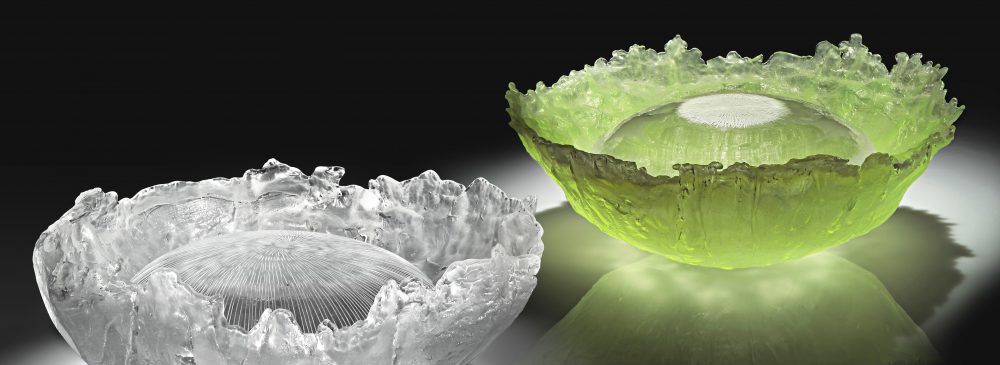
Glass and Light
The small but world-famous Czech glassmaking town of Kamenický Šenov (known as “Steinschönau” in German) is set in an idyllic landscape on the border between the Lusatian Highlands and the Bohemian Uplands. The region has been synonymous with glassmaking since the 16th century, and in the 18th century Kamenický Šenov became an important centre of the European glass trade.
When the glass industry experienced a boom around 1840, glass producers in Kamenický Šenov set out to upgrade their artisans’ professional skills in an effort to remain competitive on the international market. Drawing classes were thus introduced at the local Sunday school as early as 1839, attended by pupils and by glass journeymen and masters. In 1856, the Secondary School of Glassmaking was founded, which is considered to be the oldest school for this discipline in Central Europe. In the beginning there were only the traditional departments for glass painting and cutting, but departments were subsequently added for the design and construction of lighting fixtures and for glass engraving. Thanks to the excellent facilities available at the school, students have been able since the early 1990s to also learn glass blowing at a melting furnace, making glass sculptures out of molten glass, sheet glass slumping in the electric furnace, printing glass panes (vitreography), and the use of computer graphics. The training takes four years and ends with a qualification for university studies.
While at first the school oriented its teaching on industry requirements for skilled glass cutters, engravers and painters, changes in the field soon demanded the cultivation of artistic talent as well. The glassmaking school therefore not only offers training for future specialists in the glass industry but also prepares particularly talented students for studies at an art academy. Many distinguished glass artists have come out of the Secondary School of Glassmaking in Kamenický Šenov. The list of graduates reads like a who’s who of the Czech glass scene.
Ever since its foundation, the glassmaking school has exerted a major influence on the development of the glass industry in terms of art, craft and technology – throughout the school’s history, its headmasters, teachers and graduates have made a vital contribution to sustaining the high level of Czech glass art. This is amply evident from the works by graduates and teachers from the Kamenický Šenov school that are on view in our latest exhibition. They all reflect the high aesthetic and craftsmanship standards of the training there. The Glasmuseum Lette is thus carrying on its tradition of offering pupils and students a forum for presenting their artistic development and treatment of the material of glass.
We would like to express our sincere thanks to the school’s headmaster Pavel Kopřiva, an artist in his own right, and to the gallerist Daniela Welti, who have provided us with invaluable assistance in organising this exhibition!
Photo above:
Karolína Kopřivová, Forest flower, 2017 – Foto Vladimir Labaj, Jiří Koudelka
Photos:
Martin Novák, Engraved plate, 2008 – Foto Vladimir Labaj, Jiří Koudelka
Ladislav Průcha, Alter Ego, 2013 – Foto Jiří Koudelka
Pavel Kopřiva, The squirrel, 2017 – Foto Dagmar Petrovická
Nazerke Toleutay, Fish, 2014 – Foto Vladimir Labaj, Jiří Koudelka
Kateřina Fabiánová, Light object, 2011 – Foto Vladimir Labaj, Jiří Koudelka
Ondřej Skok, Untitled, 2011 – Foto Vladimir Labaj, Jiří Koudelka
Marie Jindrová, Idol 1, 2014 – Foto Vladimir Labaj, Jiří Koudelka
Dagmar Pánková, Pillows, 2009 – Foto Vladimir Labaj, Jiří Koudelka
NEW ACQUISITIONS 2017

NEW ACQUISITIONS 2017
“I see my knitted work as a metaphor for social structure. Individual strands are weak and brittle on their own, but deceptively strong when bound together. The connections are what bring strength and integrity to the whole and what keep it intact.” This is how the Canadian artist Carol Milne describes her unusual work. She is a pioneer in the field of “knitted glass”, experimenting with her material and persistently pushing its boundaries.
Carol Milne is one of the artists we discovered on our travels through Europe in 2017. Her work was on view in an exhibition in Hasselt, Belgium, where we also encountered the fantastic glass cloth objects made by UK artist Cathryn Shilling. The dazzling surfaces of her three-dimensional artworks give the impression of vibrating dynamics: through the unexpected interplay of texture, light and colour, Shilling succeeds in creating a stylised feeling of human movement without literally representing the human shape in the fabric. Though separate, the individual forms are connected by an almost dance-like flow of movement.
Our constant quest for special works in glass also took us to the exhibition HuGlass 2017 in Budapest, where we were amazed by what we saw, for example the sculpture “Big Fish Eats Small Fish” by the Hungarian artist Balázs Sipos. Sipos creates wonderfully detailed figures, often inspired by everyday life, the problems of our times and the inner struggles that can result. He sees himself as a glass sculptor, but his real tools are a caustic sense of humour and a predilection for the grotesque which allow him to venture a straightforward social critique.
We naturally did not neglect well-known artists in 2017 either. Anna Torfs, for example, impressed us with her breathtakingly beautiful vessel “Parts High”. The ability of glass to capture, reflect and absorb light is at the centre of the work of this Belgian-born artist and designer, who has lived and worked in Prague for many years. With sharp cuts, she reveals layer by layer how the respective work is structured. She thus lays bare airy, luminous depths through which energy and sensuality virtually pulsate.
Last but not least, we would like to draw your attention to the next exhibition after “New Acquisitions 2017”. In the summer of 2018, we will be presenting current work by students and professors at the Kamenický Šenov Glass School in the Czech Republic.
Photos from the left:
Anna Torfs, Parts High – Crystal Gold, 2017 – Photo Jaroslav Kvíz
Agnieszka Leśniak Banasiak, Enigma II, 2015 – Photo Krzysztof Pachurka
Carol Milne, Purple Reigns, 2016 – Photo Carol Milne
Cathryn Shilling, Hidden Gestures II, 2014 – Photo Ester Segarra
Cathryn Shilling u. Anthony Scala, Fragile Nature of Earthly Pleasures, 2016 – Photo Ester Segarra
Peter Bremers, Perception 4, 2011 – Photo Paul Niessen
Zuzsanna Kóródi, PF I, 2017 – Photo Zsuzsanna Kóródi
Gordana Drinković, Iyalawo, 2016 – Photo Mario Krištofić
Photo above: Carol Milne, Purple Reigns, 2016 – Photo Carol Milne
JAPANESE GLASS TODAY
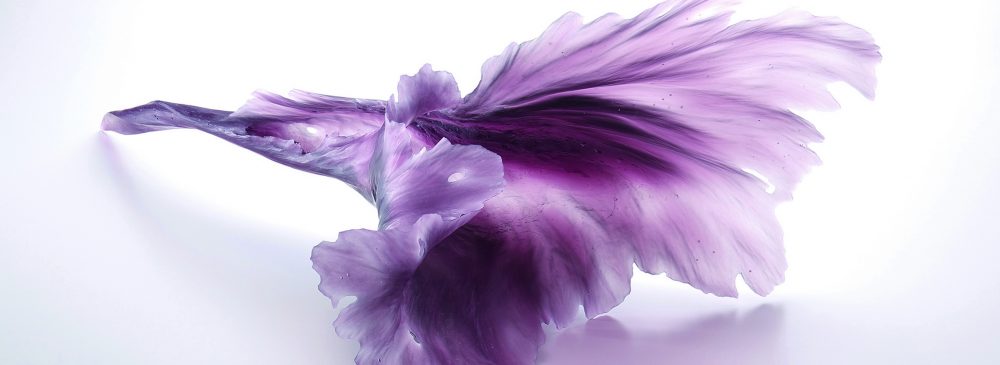
JAPANESE GLASS TODAY
Exotic, spiritual and emotional – Japanese art has an aesthetic all its own. In our new exhibition we delve deep into this world to present current artworks in glass. These sculptures, installations and wall pictures made of glass were already on view last year at the Glasmuseum Frauenau (in the Bavarian Forest), so we seized the opportunity to exhibit this unique selection of works at the Glasmuseum Lette as well.
Art lovers in Germany have had to wait a long time to experience contemporary Japanese glass of such excellence and diversity: The last major exhibition on this subject took place in 1993 at the Kunstmuseum Düsseldorf. Since then, Japan’s still-young glass scene has undergone some fundamental changes. While artists there initially worked with the medium of glass under the influence of European and North American role models, today’s generation takes inspiration from their own Japanese roots and values.
Our exhibition now gives visitors a chance to feel the effects of this elemental Japanese aesthetic sensibility. In Japanese art and culture, light and shadow, space and emptiness, silence and attentiveness are intuitively perceived and recognised not as opposites, as negative or positive poles as with us, but as value-free qualities that are inextricably connected. Only together do the two poles generate a whole.
The exhibition traces an arc from Japan to Europe, because it also includes works by Japanese artists living in Europe and by European artists who have lived and worked for a time in Japan. Viewers are therefore invited to look at Japan from multiple perspectives.
We would like to warmly thank the participating artists for making this possible:
Machiko Ito (Toyama, J), Masami Hirohata (Nuremberg, D), Jin Hongo (Toyama, J), Tsuyoshi Inoue (Tokyo, J), Ai Kigoshi (Tokyo, J), Yoshiaki Kojiro (Takayama, J), Takahito Komure (Akita, J), Runa Kosogawa (Takayama, J), Yoko Miyata (Hiroshima, J), Keiko Mukaide (Edinburgh, GB), Akira Nakagawa (Hokkaido, J), Mica Okuno (Yokohama, J), Shunji Omura (Chibaken, J), Mare Saare (Tallinn, EST), Masahiro Sasaki (Nagoya, J), Lada Semecká (Teplice, CZ), Yoshi Yamauchi (Kevelaer, D), Harumi Yukutake (Tokyo, J)
Thank you – ありがとう
Photos:
Shunji Omura, Blade Man 004, 2014 – Photo SAIKI TAKU
Takahito Komure, Message from the passed, 2015 – Photo Takahito Komure
Yoshiaki Kojiro, Breaking Composition 6, 2016 – Photo Yoshiaki Kojiro
Akira Nakagawa, Wind deviated, 2008 – Photo Akira Nakagawa
Masahiro Sasaki, Tensei #1604, 2016 – Photo Masahiro Sasaki
Keiko Mukaide, Family Tree, 2016 – Photo Keiko Mukaide
Masami Hirohata, Apfel und Birne kann man nicht vergleichen, 2013 – Photo Helge Articus
Mare Saare, Mono no aware, 2017, Detail – Photo Mare Saare
Photo above: Runa Kosogawa, Engraved on Life, 2013 – Photo Kichiro Okamura
2017
Glass from Belgium
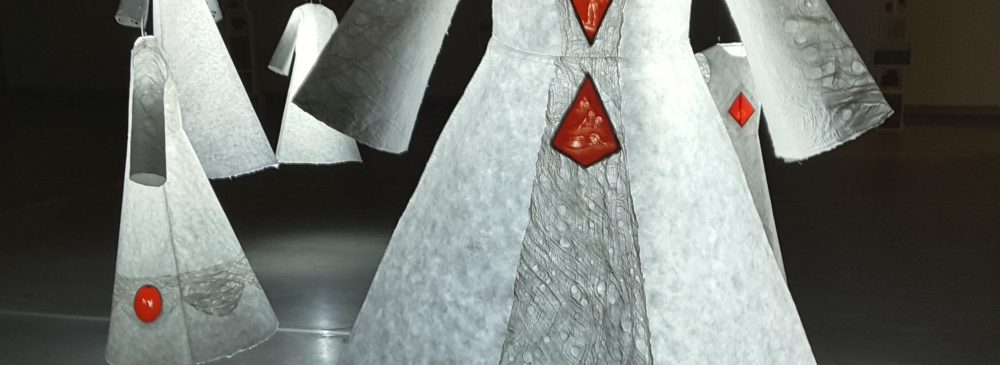
Glass from Belgium
Belgian glass captivates us today with its fresh vibrancy, innovation and variety. And yet, Belgium’s glass scene is still relatively young. The glass department at the Instituut voor Kunst en Ambacht, or IKA for short, located in the Belgian town of Mechelen, has done pioneering work here at the highest level. Because, before its founding in 1985, Belgium did not look back on a sophisticated history of glassmaking or any tradition of training, independent glass art or studio glass.
“The institute offered me the opportunity to discover the substance of glass, to understand its language and to explore its nature as a material,” says the artist Marre Geesink, describing the special significance of the Instituut voor Kunst en Ambacht Mechelen. Fostering the artistic potential of each and every student is at the heart of teaching at the IKA. Candidates from various countries, among them trained artists, are drawn to Mechelen for this reason. An inventive and inspiring atmosphere has evolved in which different ideas, backgrounds and working methods cross-fertilize one another.
In terms of technique and craftsmanship, the IKA provides exceptionally thorough training. All of the major disciplines in the warm glass field are taught, including glass blowing, casting, fusing and pâte de verre, along with coldworking processes such as engraving, grinding and polishing. The teachers and students at the IKA handle glass with a high degree of freedom and self-assurance. No one is mired either in the classic artisanal tradition or in the compulsion to undertake artistic experiments at any price. It’s thus no wonder that there is no such thing as a typical “IKA style”.
In our new exhibition, 14 students and graduates of the glass department at the IKA Mechelen present their work. They are guided in this endeavour by Sandra De Clerck, head of the glass department since 2002, and the lecturer Jeroen Heerwegh. The students in Mechelen face the demanding artistic task of finding and defining their own delicate balance between aesthetics, expression and technique. Just how well they have mastered this balancing act is demonstrated by their idiosyncratic, lyrical and in some cases socially critical installations, sculptures and objects.
Please join us in welcoming:
Ans Bakker, Thérèse Bouwens-van Herwaarden, Chris De Bock, Marre Geesink, Krista Israel, Anne Notebaert, Wilma van Rees, Rini Ronckers, Myriam Thomas, Ingrid Vandekelder, Ton Van Looijen, Ireen Van Praet, Nataliya Vladychko, Tinne Vroonen.
Van harte welkom!
Photos:
Nataliya Vladychko, Sleep well, 2016 – Photo Steven van Kooijk
Ans Bakker, Ode to the Oosterschelde, 2015 – Photo Johan Kole
Tinne Vroonen, I do, 2017 – Photo Tinne Vroonen
Krista Israel, Crowding, 2017 – Photo Krista Israel
Stanislaw Borowski
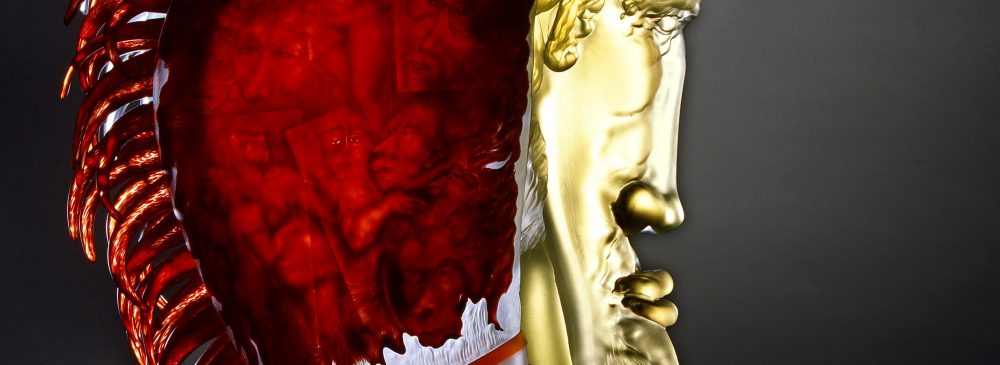
Stanislaw Borowski
After arriving in Rheinbach from Poland in 1982, Stanislaw Borowski embarked on a life journey that still fills him with gratitude: “I’ve been so incredibly lucky in my life, met the right people at the right time and made the right decisions. I was able to find fulfilment as an artist, I have a great family – things couldn’t be better.”
He ranks today among the world’s pre-eminent glass artists and is considered the undisputed master of glass engraving. In his pieces, he combines the diverse techniques of glass working with engraving in a unique fashion to create his fascinatingly detailed, often surrealistic imagery. Stanislaw Borowski was born in 1944 in Moûtiers in France, where his father was employed as a migrant worker in the coal industry. Four years later, all the propaganda for a fresh start for the Polish People’s Republic lured the family back to their homeland. The young Stanislaw sensed early on that he had an artistic streak, but his father first made him learn a more solid trade. He became a mechanic. In 1964, chance took him to the Krosno glassworks – and he was hooked. He immediately got a job there in order to learn about the different areas of glass production and design. But working at the industrial glassworks did not satisfy his artistic urge.
Secretly he set up a workshop in his aunt’s garage, where he experimented intensively but on a shoestring with the material of glass while reading the literature on the subject. He then made his first contacts with German artists and galleries in 1977 at the exhibition accompanying the 1st Coburg Prize for Contemporary Glass. When Stanislaw Borowski then moved to Rheinbach in 1982, his career skyrocketed. He was finally able to do his own artistic work, display it in exhibitions, and exchange ideas and knowledge with other artists such as Pavel Molnár, Udo Edelmann, Gerd Kruft, Erwin Eisch and Jack Ink.
He achieved a sensational breakthrough in the USA, where galleries and collectors scrambled to purchase one of his pieces. Demand was so high that new production possibilities had to be found. Borowski found a temporary solution in Hennef near Bonn, and then set up his own private glassworks in Bunzlau (Bolesławiec) in Poland in 1992, where he has been producing his work ever since. In the meantime, his sons Pawel and Stani Jan have also taken up the profession of glass artist, while Wiktor now manages the family business – a happy situation for the established glass artist, who can now see his talent and his love for glass being kept alive in the next generation.
Our new exhibition provides a glimpse of Stanislaw Borowski’s life’s work. At the centre are his early pieces from Rheinbach, works from the phase during which he took the American market by storm, and finally artworks from the period leading into the new millennium. His work is presented not only in the context of selected pieces by his earlier fellow-artists but also in combination with works by his two sons Pawel and Stani Jan. The baton has been passed on, and Stanislaw Borowski’s lifetime achievements are pointing the way to the future!
Photos:
Stanislaw Borowski, The Grande Valentino II, 2005, Leihgabe THE EKARD COLLECTION – Photo Grzegosz Matoryn
Stanislaw Borowski, White Ship, 2003, Leihgabe Borowski – Photo Sasa Fuis
Stanislaw Borowski, Deep from my heart, 2005, Leihgabe Borowski – Photo Sasa Fuis
Stanislaw Borowski, Tales from the blue Lagoon, 2006, Leihgabe Borowski – Photo Sasa Fuis
New Acquisitions 2016
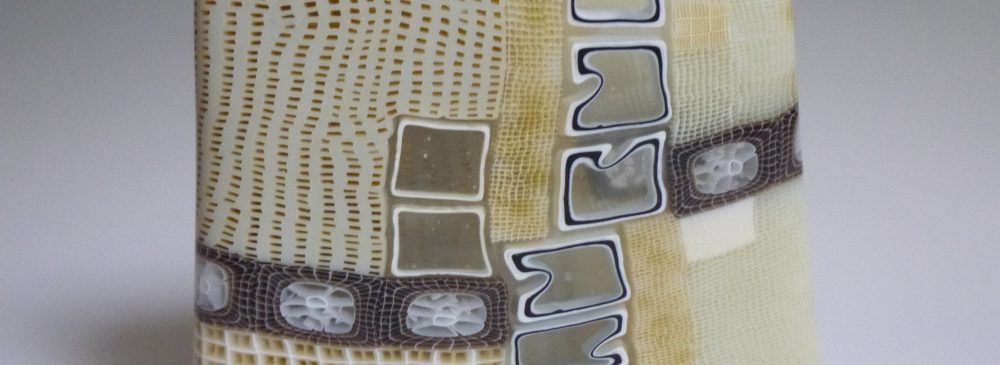
New Acquisitions 2016
South Africa, Japan, USA – and especially Australia! Talented artists from these far-off places exhibited award-winning works in Europe last year – reason enough for the Foundation to set off to experience these remarkable objects live in the hopes of enriching the collection with further multifaceted works of art.
Along the way, we noticed that artists from Australia are particularly well-represented on the European glass scene, perhaps because the history of glass art there traces its roots back to our own continent. The initial spark came in fact from the German artist Klaus Moje (1936–2016), who was summoned in 1982 to the School of Art at the Australian National University in Canberra to set up a study program for contemporary glass art. He rapidly succeeded in making glass a recognised artistic discipline in Australia. Today, many of his former students are enlivening the international glass art scene. One promising Australian newcomer is Marcel Hoogstad Hay, who works with traditional Venetian techniques and a fascinating spectrum of colours. Giles Bettison has long since made a name for himself in the art world. His beautifully crafted Murrini vessels follow in the tradition of Italian glass art while updating it with contemporary compositions that create unusual patterns.
Back home here in Lette, the appearance of our grounds has changed over the years, both outside the museum and in front of our glass depot, where H.-W. Horn’s float-glass sculpture “Spurensuche, I learn from disaster” has a commanding presence and glass objects titled “Flüchtigkeit des menschlichen Lebens” (Transience of Human Life) by Wladimir Rudolf seem to be suspended above the grass. Set before the museum, Torsten Rötzsch’s extraordinary installation “Valge” likewise proves that art and nature can converge almost magically.
Finally, we would like to draw your attention to two further exhibitions that we will be featuring following “New Acquisitions 2016”. In May we will present works by the legendary Polish artist Stanislaw Borowski, and in September we will welcome the new generation of students from the Belgian Instituut voor Kunst en Ambacht (IKA) in Mechelen.
We cordially invite you to treat yourself to some new encounters with the endlessly fascinating world of glass!
Photos:
Giles Bettison, Billett 09-6, 2009 – Photo AHH
Manuela Castro Martins, Impossible Jar I, 2012 – Photo Jorge Manuel Enes Soares
Yoshiko Okada, Three friends of winter – Bamboo, 2014 – Photo Ester Segarra
Vittoria Parrinello, The perimeter of air, 2014 – Photo Vittoria Parrinello
2016
20 YEARS GLASS MUSEUM ALTER HOF HERDING, 10 YEARS GLASS DEPOT HÖLTINGSHOF
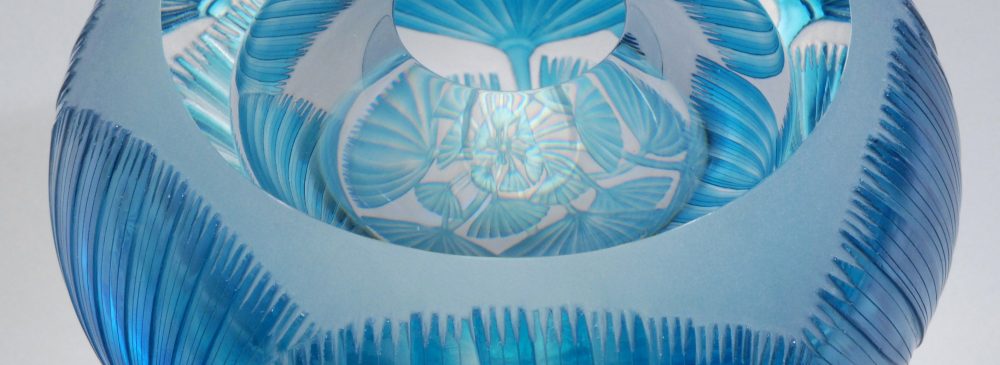
20 YEARS GLASS MUSEUM ALTER HOF HERDING, 10 YEARS GLASS DEPOT HÖLTINGSHOF
Everything started with a poster: Really, in the late 1970s, Kurt and Lilly Ernsting went to the Bavarian Forest for wandering. A look at a poster with glass objects didn’t make any rivalry to the initial intention. Without guessing the consequences of this visit they saw a glass exhibition. Spontaneously, both found that they were not only curious and interested about this special direction of art. It was a special spark that jumped on both while looking at the vases, bowls and also sculptures.
Lilly Ernsting purchased her first object – a bowl from the artist Willi Pastor, followed by further glass objects. At the beginning of the 1990s she looked at a considerable glass collection. The desire to display them and to share the joy in glass with others became stronger. She found a perfect place of exhibition in the Alten Hof Herding that she purchased together with her husband in the 1970s and saved before demolition. Kurt and Lilly Ernsting thus opened the glass museum Alter Hof Herding in Coesfeld-Lette 20 years ago.
A lot of things have happened in the two decades: 79 exhibitions displayed the art from glass of artists, students and pupils from Europe, many trips to exhibitions, trade fairs and artists studios in Germany and abroad and many glass objects (until now 1,822) found their home in the appreciable glass collection worth seeing in the museum. In this process the maxim is emphasized to collect current and contemporary glass only. Not looking backward, but forward is heeded until now in the work of the museum and its core task of collection.
On its birthday the glass museum presents a big anniversary exhibition with an extensive catalog. The new acquisitions of the last 10 years are being shown and published, that means from 2006 to 2015. The glass objects from 1996 to 2005 have already been published. The works of art from the first decade are accessible in the threshing floor at Alten Hof Herding and in the glass depot Höltinghof. The glass depot with its display in the neighboring Höltinghof is also celebrating birthday. Kurt and Lilly Ernsting inaugurated this second establishment in 2006 to promote the art of glass which is still unique in Germany.
It has become a life’s work from an accidental encounter. Starting with a moderate number of works of art from glass Lilly Ernsting started explaining more and more with artistic glass. Today she is looking at an established glass museum involving a sound glass collection.
Photos:
Katharine Coleman, Small Light Blue Haeckel Bowl, 2014 – Photo Katharine Coleman
Karen Lise Krabbe, Blind Boxes for NoThing, 2012 – Photo Enok Holsegaard
Karlie Sears, Pale Cluster, 2009 – Photo Horst Kolberg
Michael Behrens, Underwater-World 100-08, 2008 – Photo Paul Niessen
Guest: Art Academy Burg Giebichenstein Halle
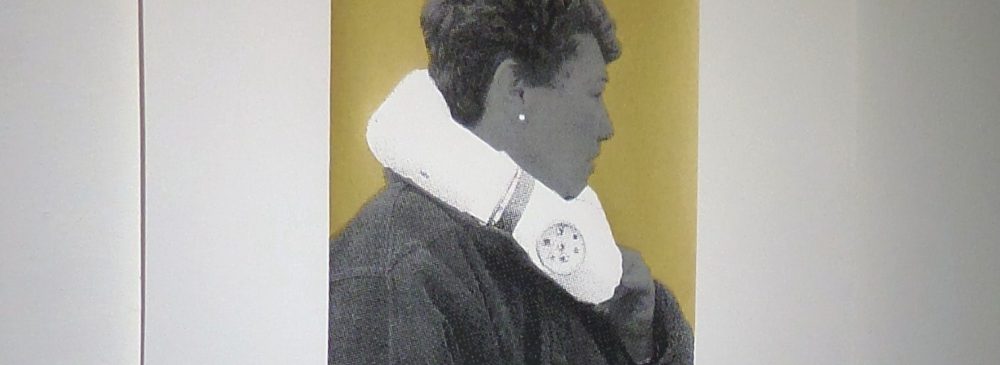
Guest: Art Academy Burg Giebichenstein Halle
The Art Academy Burg Giebichenstein in Halle (Saale) has a traditional history. In 1915 it was officially founded as Art Vocational School within the meaning of German Werkbund. When in 1925 the Bauhaus in Weimar was dissolved, numerous representatives came from there to the Burg. The Burg Giebichenstein remained until 1989 one of the most influential training centers for designers and artists in the GDR. In 1989 it was reorganized as Art Academy and the training is since then in line with international and finding support related with specific field from the industry, economy, private and public institutions.
In the special class Pictures/Space/Object/Glass young artists come together to concentrate themselves on the material glass. At the same time the name of the class is program – a statement for material and context! According to this principle the students conceptually deal with glass. They learn or refine not only manual skills, but also come to a stop to fathom out the plastic and artistic properties of the material glass. In the event of a high manual requirement idea, concept and discourse come to the fore. It develops a process in which the young artists experience the training of their individual artistic language, derive formats and social acts to position themselves with their work.
In our exhibition we present actual results of these processes that also stands for a new consideration of glass in the contemporary art: Displayed are space-seizing installations, wall objects and sculptures from cast or blown glass, often in connection with other materials. They all demonstrate esprit, humor and profoundness as well as great manual knowhow. The works originate from 11 artists – a group that understands itself as a team under the management of instructor Sebastian Richter. They are accompanied by their female professor, the renowned artist Christine Triebsch.
The guests are: Carl Bens, Felicitas Fässler, Wilhelm Frederking, Eri Hayashi, Juliane Hoffmann, Nora Manthei, Anne Martin, Alexander Roschke, Jorge Sanchez Di Bello, Jakob Schreiter, Jenny Trinks, Sebastian Richter, Christine Triebsch.
Photos:
Jorge Sanchez Di Bello, Elvia Cortés, 2015 – Photo AHH
Anne Martin, Fraktale Geometrie, 2016 –Photo Anne Martin
Eri Hayashi, Eine Insel, 2015 – Photo Uli Kühnle
Jakob Schreiter, Space Solid, 2015 – Photo AHH
New Additions 2015
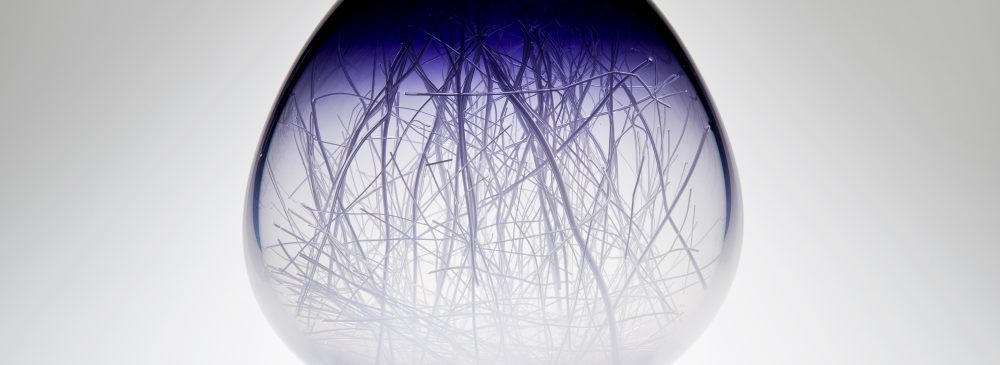
New Additions 2015
The European glass scenery remains alive full of surprises.
For example, the annual exhibition “Ovengevormd Glas“ in the Dutch Joure has emerged as an attractive address for enthusiasts of art from glass. We have met many interesting newcomers who approach the art in a fresh and unprejudiced manner at this international show. One of them is Nataliya Vladychko from the Ukraine. Her tender, nostalgic lace handkerchief from fine Pâte de verre takes us to the past when such an utensil was of high value. Finally, a long contemplating desire came true to see works of the renowned artist Heike Brachlow displayed. The adopted Englishwoman is almost never represented in Germany so that we deemed ourselves extremely lucky to come to know her in Joure with her precisely cast and ground autonomous works. With “Ellipsis III“ we welcome the artist in our collection.
For the first time we visited the British Glass Biennale in Stourbridge. Even this visit was rewarding: We acquired the sculpture of Ashraf Hanna, which received the 1st prize. The Ethiopian artist mostly works with cast glass. He is fascinated from shapes that apparently change drawing the attention of the eye to their three-dimensional aspects. Among the representative number of the exhibits some new entries were chosen, but also a “well-known” I the meantime, Louis Thompson. “Panicum“, expression of harmony and magic, formally and stylistic supplementing his „DNA Helix“ already being represented in the collection.
Even in Germany two renowned glass prize awards took place in 2015 thanks to the glass museums Immenhausen and Rheinbach. Visits to these two exhibitions had serious consequences. Works full of poetry now enrich the narrative side of the glass collection.
Last but not least we want to announce a special highlight: In summer 2016 the glass museum Alter Hof Herding will celebrate its 20th anniversary and the glass depot its 10th anniversary. On the birthday we will present you a big anniversary exhibition, a comprehensive catalogue as well as with a glass edition designed for this festival.
Look forward with us to 2016 full of actions!
Photos:
Louis Thompson u. Hanne Enemark, Panicum in Amethyst, 2015 – Photo Ester Segarra
Ashraf Hanna, Untitled 1, 2014 – Photo Ester Segarra
Christina Kargl, Bowls of Nature, 2014 – Photo Christina Kargl
Michael Behrens, Seaforms 2014-116, 2014 – Photo Paul Niessen
2015
Destination Glass
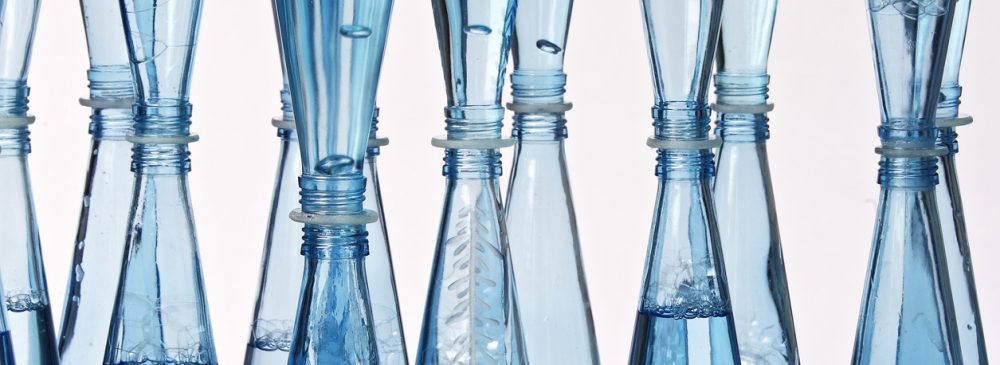
Destination Glass
Glass as a destination – with our new exhibition we want to take you to an expedition through the manifold world of glass.
For that purpose we have gathered glass from five different collections. They are representative works that show the medium glass from its history to the present age, ranging from its convenience up to the free art, from hollow glass up to the flat glass. For this extensive exhibition the Foundation has invited established and renowned museums, to present their varied orientations and core areas which are last not least distinguished through the typical history. Each museum throws a completely new bright light on the material.
The LWL Industriemuseum / Westfälisches Landesmuseum for industrial culture – glass factory Gernheim in Petershagen is located in the historical buildings of a former glass factory. Besides a museum presentation of the glass manufacture in the 19th and 20th Century the museum sponsors artists to manufacture their works in the glass furnace. The glass museum Immenhausen is located on the premises of the former glass factory Richard Süßmuth, who developed sophisticated art and utility glass, among others, the renowned AE series with filigran shining cut. The museum is engaged in the regional historic glass tradition ranging up to the modern international studio glass art. Das Deutsche Glasmalerei-Museum Linnich is a nation-wide unique museum for flat glass painting that offers a platform to the national and international glass painting. Linnich became the location of the museum because the oldest German glass painting workshop Oidtmann since 1857 is domiciled here still being active. The LWL Museum for Art and Culture in Münster accommodates in its collection for regional history historical glass from Westphalia too. The glass museum Rheinbach with the collection Mülstroh exhibits in its permanent exhibition valuable glasses from baroque up to contemporary studio glass and provides an overview of the Bohemian glass manufacture and refinement. Rheinbach became glass city with the State-recognized Special Glass School through the settlement of Sudeten German glass refiners after the Second World War.
Inspiration for our new exhibition came through the cooperation with the network glass museums, a cooperation project between glass museums and collections from NRW. The glass museum network will call forth curiosity and interest and cause amazement regarding the unlimited creative possibilities of the material glass.
Photos:
Karin Hubert, Gluckerflaschen, 2013 – Leihgabe LWL-Industriemuseum Westfälisches Landesmuseum für Industriekultur – Glashütte Gernheim – Photo Martin Holtappels
Richard Süßmuth, Serie AE 364 mit Strahlenschliff, 1954, Leihgabe Glasmuseum Immenhausen – Photo Christian Ruhlig
Renate Groß, Beziehungskiste Wassermond, 1995, Leihgabe Glasmuseum Rheinbach – Photo Siegmut Seeger
Anton Wendling, Sternrose, 1957, Leihgabe Deutsches Glasmalerei-Museum Linnich – Photo Stefan Johnen
Günter Wagner
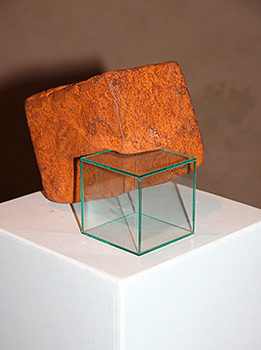
Günter Wagner
Günter Wagner is a sculptor – glass is for him an artistic significant carrier. His works are composed of different precisely processed materials. Coated cast iron, steel and lead develop conceptually with glass or mirror elements a combination with the light and the surrounding space. Mostly Wagner creates geometric shapes that transport the virtuosic in their varying materialism their contradictory effects. Ease and gravity, transparency and compactness unite in an extremely esthetic interplay. Together they build tension and relaxation that lead on their part into an almost mediatorial force.
In Günter Wagners objects, wall works and installations we experience glass in an unusual dimension for us. When he combines fragile glass with massive metal, the perception of the observer reverses because both materials can take up the part of the dormant, oppressive or the moved, easy moment. The two elements ease and gravity appear to easily pass over in each other. From this bipolarity his works obtain their internal tension and force of attraction.
Günter Wagner, born 1955 in Karlsruhe has been living for many years in Bruchsal. Initially, he studies graphic arts and painting in Marburg followed by a course in art at the State Academy in Karlsruhe. In 1988 he obtained a project stipend from the Bonn Art fund for sculpture in Italy. His works are exhibited with great success all over Germany, France, Belgium, Italy and Switzerland. Not until this year he received the art prize of Ettlingen Museum Society.
Together with the Art Association Münsterland in Coesfeld we have invited Günter Wagner to present his material overlapping creation in two parallel exhibitions: You can see his works here in the Glass Museum Alter Hof Herding and from June 21 in the Kunstverein Münsterland, Jakobiwall 1 in Coesfeld.
Photos:
Günter Wagner, Aufgesetzt, 1998 – Photo Günter Wagner
Günter Wagner, Ikarus, 2004 – Photo Günter Wagner
Günter Wagner, Hommage an Giovanni da Bologna, 2006 – Photo Horst Kolberg
Günter Wagner, Doppelkeil, 1996 – Photo Hildegard Morian
New Acquisitions 2014
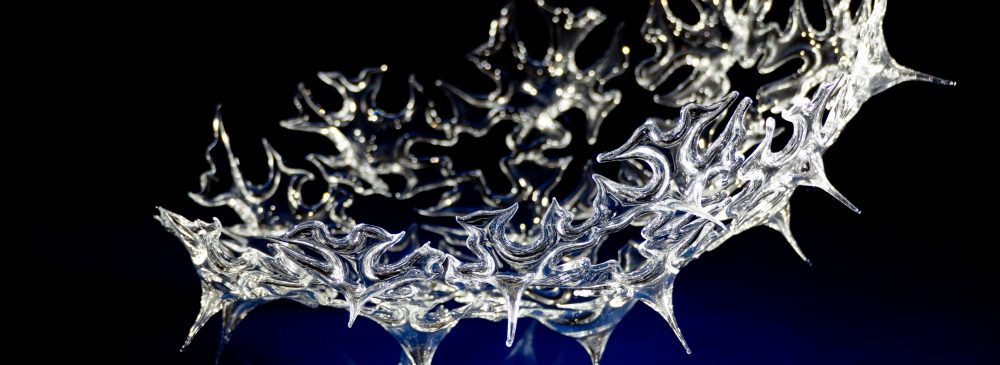
New Acquisitions 2014
It’s time again – traditionally we invite you to the first exhibition with the new acquisitions of the preceding year. At the beginning of a new year we question us again and again: Which exhibitions we will visit, how many new artists we can win for the collection, will we meet well-known with fresh, cute and cheerful works or we will come to know new techniques?
We were amazed in the past year while visiting the Coburg Glass Prize. We hit the mark here – we were extremely lucky that we could have the work that won the first prize for our collection: “Blind Boxes for NoThing“ of the Danish female artist Karen Lise Krabbe. They are fragile boxes made of glass powder and olivine (like glass they belong to the silicates) which can only be recognized as such in open condition. With utmost perfection the material is cast layer by layer in a sand cast creating the illusion they have occurred naturally like sand layers created through wind and erosion. Karen Lise Krabbe not only plays with the traditional shape and function of glass, but with the perception of the observer as well.
The lamp glass scene is running at full steam, the artist’s inspirations do not know an end as in case of Oliver Drobar from Germany. His works captivate through their incredible delicacy: They are precisely worked glass networks with waving structures that react even to tender air movements. Drobar himself describes his objects as living glass.
Another highlight was the Museum Glazenhuis in Belgian Lommel that presented us under the title “UK Glass“ new artistic glass from Great Britain. You can be sure that this visit also had consequence for the collection! The window images “Window I + II“ of the female artist Erin Dickson caught our attention. She attains her objective to understand her windows as autonomous works of art and not as a part of the architecture with a technique that makes the clarification of the motive impossible and manipulates the observer.
Be curious and look forward with us to a varied exhibition with our “New Acquisitions 2014“!
Photos:
Oliver Drobar, Eisschmelze, 2011 – Photo Daniel Heydecke
David Reekie, Daggers Drawn III, 2012 – Photo David Reekie
Julia Malle, Spheres, 2010 – Photo Horst Kolberg
Stanislaw Borowski, The Bird III, 2006 – Photo Sasa Fuis
2014
Visitor: Poland
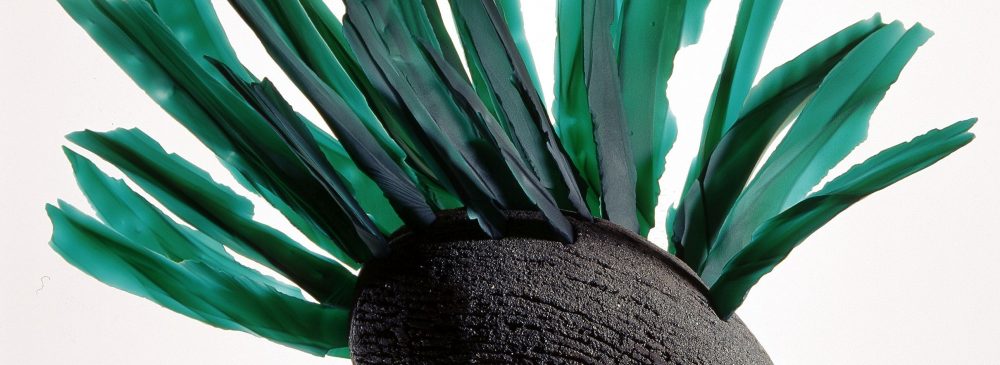
Visitor: Poland
Wroclaw, Polish for Breslau, holds good even today as a traditional centre for glass. Once this city was metropolis of the historical region Silesia and in the 13th century the place of production for glass. In the 17th century the glass conditioning (engraving, cut and painting) was pushed in such a masterly manner that glass from Silesia was an internationally demanded export article. However, new technologies from Italy like filigree and millefiori were picked here at an early stage and developed further.
After the 2nd World War an amazing multilateral glass creation developed from these roots. Wroclow had its strong power of radiation thanks to the Academy for Fine Arts being founded in 1946 – one of the most dynamic art academies of the country until this date. The only Faculty for Glass and Ceramics was founded here that quickly developed as a centre for new artistic and glass technical impulse. It offers a well-founded training at technical-industrial level to qualify the students for the artistic contact with conventional and new technologies of the glass formation. New perspectives start developing inventively and discovering an own artistic expression.
Our guests from Poland are partly international renowned teachers, graduates and students of the glass department present to you about 60 works. All of them have one thing in common: They perfectly master the handling of the different glass technologies, break and interpret however the long-standing tradition at the same time continuously anew. Their works are abstract, sculptural, narrative, ironical or simply touching. Each work is unique in its character, statement, style and shape – an expression of the individual access of the artist to the medium glass.
Our special thanks are due to the Polish artist Marzena Krzeminska-Baluch. She acted as an agent between the artists and the Foundation. Even Marzena Krzeminska-Baluch is present with strong and still works.
Welcome! It’s nice that you are here – Serdecznie Witam, Cieszymy się że Państwo z nami są!
Photos:
Wojtek Peszko, Archa III, 2008 – Photo Stanislaw Sielicki
Marzena Krzeminska, Between 3, 2011 – Photo Stephen Vest
Patrycja Dubiel, Nihil Novi, 2010 – Photo AHH
Stanislaw Sobota, Turquoise Atoll, 2013 – Photo Stanislaw Sielicki
Visitor: Estonia
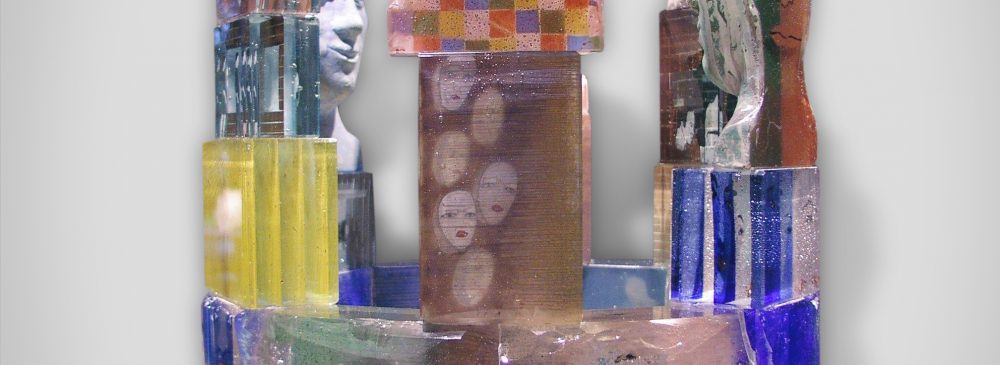
Visitor: Estonia
“Estonian glass strongly fits in its type into the country from which it originates. It is robust as well as vulnerable, it radiates a sense of calm and sometimes restlessness“, the extraordinary art of glass of her native country is described in this way by Mare Saare, one of the most popular Estonian artists.
When we were confronted with Estonian glass for the first time a few years ago we were immediately fascinated from its expressiveness and clear speech of shape – and we were extremely surprised that in the small Baltic country an independent glass culture has developed at high level almost unnoticed from the West European art scene.
Estonia’s glass scene is still young: It could only freely develop itself in the course of the nineties. During the Soviet period from 1940 thru 1991 there were scarcely any possibilities to work artistically with glass neither conceptionally nor technically. The former glass workshops which were founded in the third of the 20th century were characterized by the mass production to refine imported glass and crystal goods with cold techniques like cutting and engraving. Therefore, the studio glass movement reached Estonia rather late: In 1991 the first furnace was erected by Viivi-Ann Keerdo and Kai Koppel in Tallin. Works of these two pioneers can be seen in the new exhibition. Even though traditionally the cold techniques as well as optical glass play a big role as before the young generation prefers today the work on the furnace that enables almost endless artistic experiments.
With our new exhibition we give an insight into this unusual, young glass scene of Estonia, which is still scarcely known in these parts. Thanks to the great commitment oft he Estonian artists and the curator Kati Kerstna we can present nearly 40 unconventional works which to some extent have been created for our exhibition. It involves 22 Estonian glass artists – renowned personalities who have established themselves in the international scene in the meantime, but also young, creative artists who are going their own particular way.
Photos:
Rait Prääts, Round table, 2012 – Photo AHH
Mare Saare, Double Fragile, 2013 – Photo Mare Saare
Piret Ellamaa, Do you hear, 2013 – Photo Horst Kolberg
Kati Kerstna, Drums 1+2, 2014 – Photo AHH
SPUN AND DRAWN
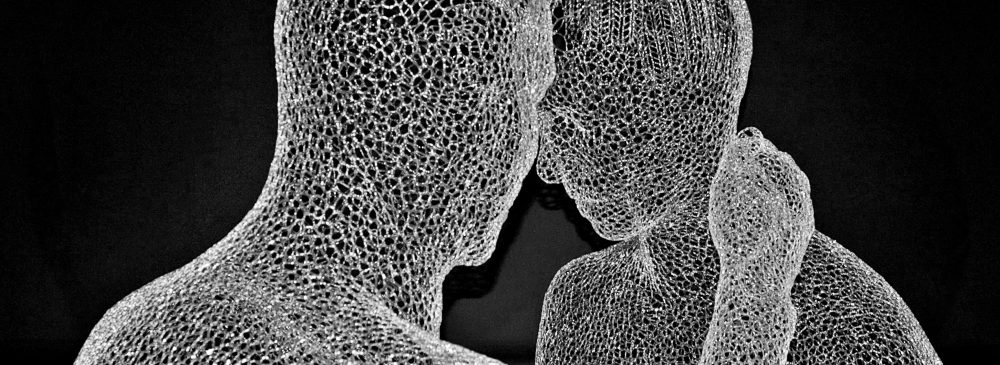
SPUN AND DRAWN
Lamp glass is an old technique by which glass objects are shaped not in the furnace, but at the open flame of a gas burner, the so-called “Lamp“. Traditionally, it is the art of the small shape that allows shaping pearls, miniatures, molds or small-size jars perfectly. In the past years artists have almost revolutionized this type of glass: With free, plastic, partially also large-size objects they currently pave completely new paths for the lamp glass.
We already presented this development in summer 2010 in our exhibition “Network, Rod, Barb – World View and Poetry. Contemporary Lamp Glass from Five Nations“ Now we are carrying on the topic and present you works of the Luxembourger Anne Claude Jeitz and the Frenchman Alain Calliste and the German Jörg Hanowski. All three have crossed the limits of the traditional lamp glass long ago. They know each other for many years meeting again and again through artistic projects. Specifically, for our new exhibition they have even created a joint work with „Playground“.
Anne Claude Jeitz and Alain Calliste are spouses and also closely associated with each other artistically. They jointly create poetic artworks according to the filigrane technology by which they have set international standards in the meantime. Their works in “verre filé“, a netlike spun lace fabric from glass narrates stories of their numerous trips and human encounters with a critical, but warmhearted view of the things and the people.
Inspired by the shapes and organic structures is the artist Jörg Hanowski living in Witten. He also has equally the command of the technology and the art. His works are voluminous and interactive- they appear to create a secret connection with the respective environment. In addition, he works with the luminous inert gases neon and argon. These illuminated objects with their partially pulsated, partially graphic shapes mislead to play with the perspective.
Lamp glass is a technology that one can experience closely and directly. It allows that the artists can finally demonstrate onsite live and stirring how their artworks are created.
The demonstrations will take place: Sunday, 30.03.2014 and Sunday, 22.06.2014 from 14 – 17 hours respectively at the Glasmuseum Alter Hof Herding.
Photos:
Anne Claude Jeitz u. Alain Calliste, Symphony, 2009 – Photo Anne Jeitz
Jörg Hanowski, Biogenese 1, 2003 – Photo Lutz Naumann
Jörg Hanowski, Phytoplankton 2, 2014 – Photo Norbert Dähn
Anne Claude Jeitz u. Alain Calliste, Patience, 2010 – Photo Anne Jeitz
New Acquisitions 2013

New Acquisitions 2013
“Working with glass offers me an unlimited variety of possibilities“, says the Swiss artist Veronika Suter about the world of glass. Her friendly, bold, but also seriously sheepish looking “Onlookers“ welcome you from now on outside on the way to the museum. In search of new objects for the glass collection it is always discovered that glass as a material and medium conceals an endless depth of options. Like that every year turns out differently again and again than the preceding one – similar to life: One never knows what will happen und whom one will meet. To react openly, unbiased and flexibly in respect of all artistic events has the highest proposition in this process.
In the new exhibition we present the fascinating results of the expeditions of 2013. Nearly 60 new works have been acquired almost clockwise from artists from all over Europe: Denmark, Sweden, Poland, the Czech Republic, Slovakia, Bulgaria, Italy, Switzerland, France, Germany, Netherlands and England. This time the main emphasis is on sculptural works. There are partly abstract works like the blazing blue “Propagate“ of the British artist Shelley Doolan or the “Between Fragment and Whole” made of a multiplicity of blown and cut glass fragments by Jeannet Iskandar from Denmark. However, there are figurals as well, e.g. the mysterious “Portrait“ of the Bulgarian Hari Arabyan.
Today we would like to tell you about two exhibitions in this year:
In spring we will repeat the topic lamp glass and to this effect we invited three excellent masters of their craft: Anne Jeitz and Alain Calliste from Luxemburg as well as their German colleague Jörg Hanowski. Specifically for the exhibition they will work out a composite work. On international scale it will continue in summer: Artists from Estonia will present their remarkable works which have been independently developed apart from the traditional glass strongholds.
Do not miss the inspiring, limitless world of glass!
Photos:
Shelley Doolan, Propagate, 2012 – Photo Simon Bruntnell
Oldrich Pliva, Un-Endlich, 2012 – Photo Horst Kolberg
Hari Arabyan, Portrait, 2012 – Photo Sandro Arabyan
Emmanuel Babled, Osmosi Vase, 2013 – Photo Nicole Marnati
2013
Early Work
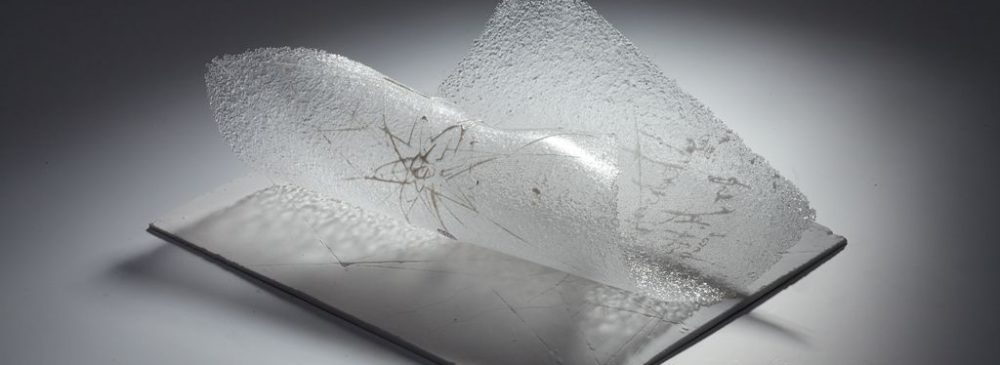
Early Work
The renowned Institute for Artistic Ceramics and Glass, briefly IKKG, is a department of Koblenz University. It‘s not incidental that it is located in Höhr-Grenzhausen: In the southern Westerwald, the “Kannenbäckerland“, a unique ceramic culture has developed in the course of the centuries characterizing the entire region until this date. In order to maintain and to continue this close correlation between handicraft, technology and art the IKKG 1987 was initially founded as an Institute for Artistic Ceramics.
In the year 2000 the newly booted liberal art glass class also enormously enriching the institute as well as the region. As one of the few international top-ranking facilities in the fine arts, the IKKG has since then been offering a comprehensive practical and artistic training to talented young people in the material areas of ceramics and glass. In 2007 the degrees of Bachelor and Master of Fine Arts were accredited for the first time to the course of studies so that the institute is on a par with the leading art faculties in Europe.
At the IKKG the artistic course of studies aims at keeping the talent of the student in line with his personality. The focus of the artistic process is on the independent, material thinking – idea, concept, criticism, reflection, technology, manual skills and curiosity constitute the means on this path. The course offers the scope to formulate questions the creative response to which may become the artist’s life-work. The material, the medium glass is an offer in this connection to transport or to visualize ideas, topics or emotions in an appealing as well as complex manner. As yet the facets of the glass have in no way been fathomed out since its range offers a big scope to the artistic possibilities of expression. At the IKKG unusual, suspense-packed, installations, sculptures, blown and moulded glass objects come into being. Currently, also in association with different other materials that altogether sensually and quietly narrate stations of the life.
Fascinating insights in the work of the glass class were already provided through our first common exhibition “Experiment Glass“ in spring 2008. Now we are delighted to present the current works of the new glass generation at the IKKG. The students will be accompanied by two reputed artists: Professor Jens Gussek, head of the glass class since 2011, and professor Ingrid Conrad-Lindig, who had been in charge of the institute until her emeritus in 2011.
Photos:
Anne Petters, Notizen, 2013 – Photo Horst Kolberg
Michéle Janata, Raum, 2013 – Photo Masami Hirohata
Judith Röder, Kristall-Konstruktion II, 2013, Leihgabe Judith Röder – Photo AHH
Lena Feldmann, o.T., 2013 – Photo AHH
Masters of Glass
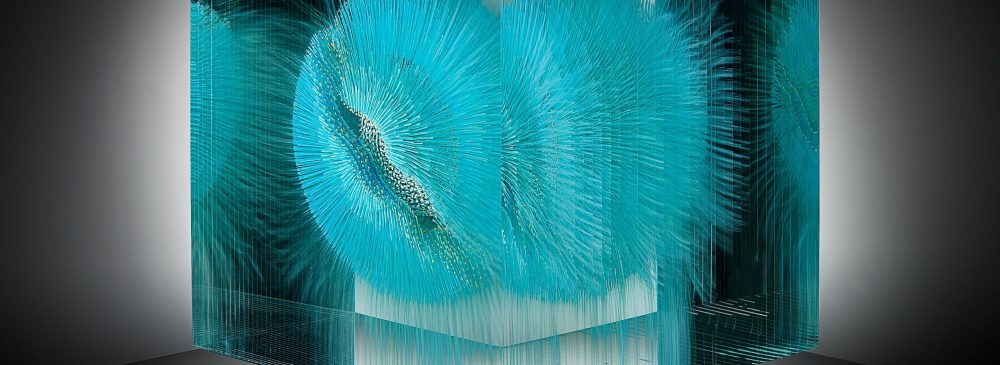
Masters of Glass
The huge success of our exhibition “Made in NRW – Staatspreisträger des Landes NRW in der Sparte Glas” [NRW State Prize winner in the glass division] in 2007 inspired us to take a look at the rest of the country. For decades now, several other German states have also been awarding prizes for excellence and innovation in artistic creations. Bavaria honours internationally renowned artists and artisans, Hessen focuses on German artists in its annual awards, whilst every two years NRW recognises artists who live and work in NRW.
The masters of their craft in this unique exhibition are
- Michael Behrens from Düsseldorf who was honoured for his inspiration in glass taken from the underwater world in 2009
- Bert Frijns from the Netherlands who impressed the Bavarian State Prize jury in 2012 with an installation of large-format vases made from flat glass
- Wilfried Grootens from Kleve who made an impression on the North Rhine-Westphalian jury with his laminated glass cube made from flat glass and the changing life within in 2011
- Gabriele Küstner from Göttingen who received the award for creative use of the ancient technique of melted-glass mosaics in 2012
- Ritsue Mishima from Japan who was awarded the Bavarian State Prize in 2012 for her mouth-blown work in Murano glass entitled “Tre Gole” because she united Far Eastern design with European glass technology.
All the artists have established themselves in the world of glasswork with their own individual styles, and the State Prize marks a significant milestone in their career. This exhibition is the first time the participants have worked together. The foundation is proud that the works of these established artists have been part of the collection for many years.
Photos:
Wilfried Grootens, Where the shark bubbles blow 10-13, 2013 – Photo Norbert Heyl
Ritsue Mishima, Tre Gole, 2009 – Photo Horst Kolberg
Gabriele Küstner, Mosaikteller 4.E.2013 – Photo Gabriele Küstner
Bert Frijns, Zwei Vasen, 2012 – Photo AHH
Michael Behrens, Seaforms 2013-74, 2013 – Photo Nele Siebel
Poesy in Everyday Life
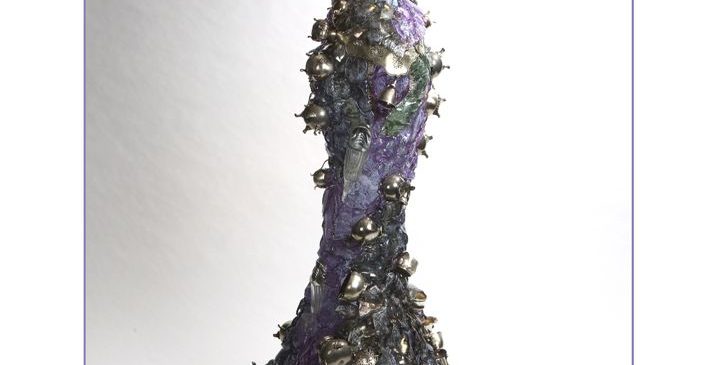
Poesy in Everyday Life
Everyday life means for many people routine and boredom. Continuous repetition of familiar sequences offers safety and security though it enlivens at the same time the wish to break out and to look for the particular and unexpected to spontaneously make a festive day out of the everyday life. A longing that connects all adult people irrespective of their sex, age, origin and social status. In order to shake off the everyday yoke and to bring magic into life everybody acts very individually. The one furnishes his new apartment, the other improves his external appearance with new things or makes life colorful with a few flowers. Someone changes his life, takes flight from everyday life that, in turn, may again be a trap.
The stunt to maintain here the balance and to arrange with the inevitable everyday life, to find magical moments in the putative sadness has also inspired artists. Their quest for the poesy in everybody life documents our exhibition carrying the same name. The glass collection proves itself to be an enormous source in this subject: A very big part of the stock reflects the commonplace items whether they are bowls, vases, bottles or cans. Even associations with varying textiles are frequently found. With it the art escapes the item as in a metamorphosis from its everyday reality – it mutates from an appropriated commodity to the independent work of art. The observer will be confronted with a new view of the material world that surrounds him everyday effective for the incredible aesthetics of the totally normal everyday articles. The artists dismiss the items from their banality, assign even to a saw or a scissor a new task and confer a glamorous appearance to Dutch clogs.
Escape the everyday life and go underground. Have a good journey!
Photos:
Patula Berm, Memories of Lavander, 2007 – Photo Richard Willebrands
Louise Rice, Safe as Houses , 2003 – Photo Ron Zijlstra
Caroline Prisse, Dutch Cinderella, 1997 – Photo Ron Zijlstra
Drew Smith, o.T., 1980 – Photo Ron Zijlstra
New Acquisitions 2012
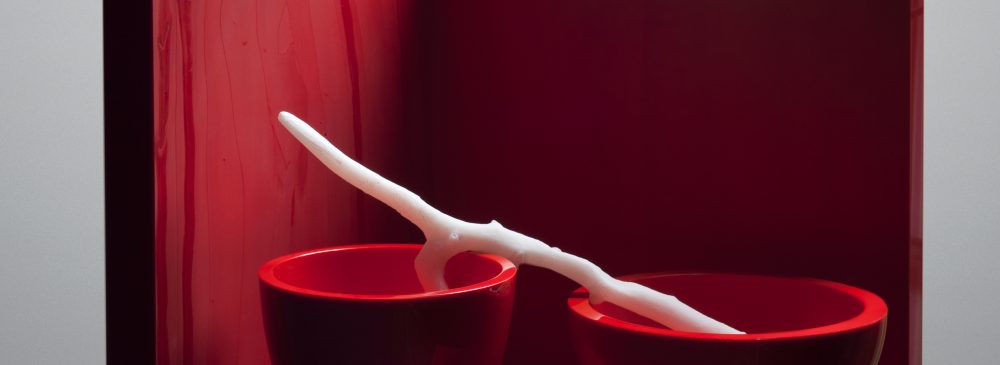
New Acquisitions 2012
What is happening in the European glass scenery? We have intensively followed up this question during the past year 2012. During our trips to exhibitions, trade shows and galleries we met artists from all over Europe. A large part of more than 70 new acquired works originate from Czech artists. This is mainly due to the fact that we exhibit the students of the three significant Czech art academies in Prague, Ústí and Labem and Zlín as well as subsequently their professors Rony Plesl, Ilja Bílek and Peter Stanický with remarkable works. In addition, well-established galleries in Germany often display Czech glass.
Even the exhibition activity of the glass museums at home and abroad was very much on the go. For instance, the glass museum in Belgian Lommel showed for the first time the International Glass Prize 2012. Intuitively, we acquired later the prize-winning works of the first prize winner Yoshiaki Kojiro and the prize winner of the audience, Siobhan Healy. Both works characterize through their enormous attractiveness: Thus, one likes to touch the huge and hackly glass cube of the Japanese despite possible danger of injury. And the tender glassy plants appear to emerge from the massive, oversize formate herbarium of the British female artist.
Our journey to Sweden was impressive. There we met artists who had been known to us since the beginning of the collection, but also outstanding and very productive artists and designers of Sweden. Ingegerd Råman, for instance, is one of the most prominent personalities of the Swedish design. Her artistry is uncomplicated, reduced to the essential with simple, timeless beauty and excellent cut. Martti Rytkönen on the contrary likes the playful poetic element. He says about himself: “When glass is concerned I am a babbler“.
The fantastic world of glass of Sweden has inspired us to present an exhibition with Swedish artists this spring. In the summer we will then show the prize-winning works of state prize winners of different German federal states and in autumn/winter works of students from the IKKG (Institute for Artistic Ceramics and Glass) Höhr-Grenzhausen.
For 2013 we wish you many fascinating insights and experiences with the glass!
Photos:
Rony Plesl, Scene of Red, 2012 – Photo Tomáš Brabec & Patrik Borecký
Yoshiaki Kojiro, Shiro former 2, 2010 – Photo Yoshiaki Kojiro
Martti Rytkönen, Puppet Show 7, 2010 – Photo AHH
Siobhan Healy, Herbarium, 2011 – Photo Lighthouse Photographics
2012
“With plenty of feeling and calm hand…“
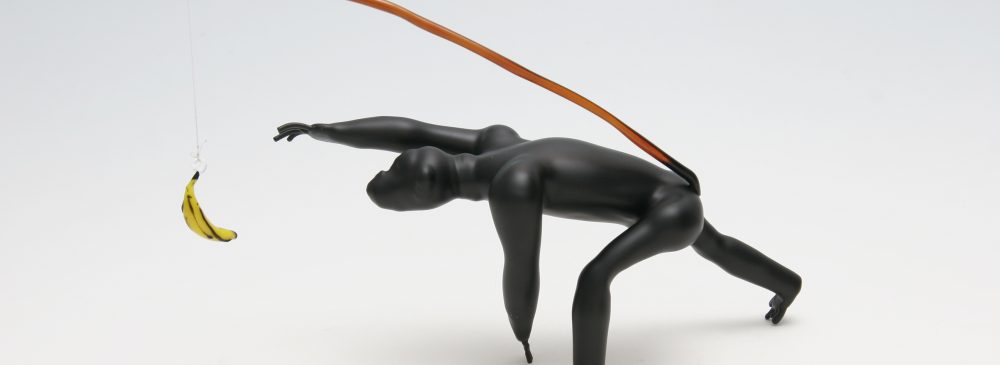
“With plenty of feeling and calm hand…“
At the Glasfachschule Zwiesel students and teachers have a common goal: expressing their passion for the material glass – with technical know-how and creative ideas, “with plenty of feeling and calm hand“, as accurately phrased by a female student. The enthusiasm for the material with its mere unlimited possibilities, the interaction between shapes and colors, the fascination of the hot glass and the joy in refining the cold glass characterize here the education.
Amid the Bavarian Forest with its great glass tradition, the Glasfachschule Zwiesel has developed itself to one of the most modern competence centers for design, craftsmanship and technology in the glass sector in Europe. The oldest glass school in Germany was founded as early as in 1904. Thanks to a future-oriented management it defies all upheavals in the glass industry and offers an outstanding infrastructure for the education and further education. Young people from the entire German-speaking region come to Zwiesel to work creative artistic, to obtain further education or to learn a glass technical or industrial profession. Many renowned glass artists come from the Glasfachschule Zwiesel, to some extent they also work there as teachers. In the vocational technical school the students obtain a comprehensive education that depending on the main focus range from the glass painting via glass refining like engraving, grinding and flat glass processing, design glass blowing up to creative glass making at the studio furnace. In this process, a quick transformation of concepts in the hot glass area is accomplished by the teaching and test glass factory of the school. New at the Glasfachschule Zwiesel is the education for creative design.
The works exhibited reveal that all students bear glass in their genes. All of them reflect the high aesthetic and technical standard of the education at that end. The exhibition will be accompanied by Hans Wudy, who has been acting as principal since 1997 with great success and Franz Xaver Höller, renowned artist and devoted teacher at the Glasfachschule Zwiesel since 1981.
Photos:
Markus Marschmann, Heimat und Ferne, 2011 (Glasfachschule Zwiesel, Abt. Lampenglas) – Photo Horst Kolberg
Doris Heymel, Schale, 2006 (Glasfachschule Zwiesel, Abt. Produktdesign) – Photo Gunther Fruth, Franz X. Höller
Alina Li, Gesellenstück, 2006 (Glasfachschule Zwiesel, Abt. Kaltveredelung) – Photo Gunther Fruth, Franz X. Höller
Michael Stangl, Heimat und Ferne, 2011 (Glasfachschule Zwiesel, Lampenglas) – Photo Gunther Fruth, Franz X. Höller
Ilja Bílek – Rony Plesl – Petr Stanický
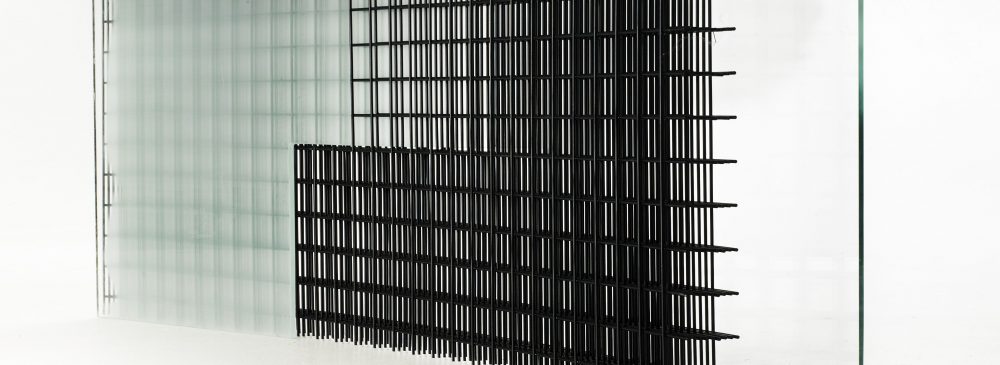
Ilja Bílek – Rony Plesl – Petr Stanický
They come from the Czech Republic, they are professors and their artistic medium is glass. However, is it everything that unite them. Though the great glass tradition of their native country is the source of their inspiration each of them follow its own path in style, technology and content. If one looks at the history of the Bohemian glass, you will understand its artistic origin since in the world of art and design Czech glass has been an international trademark since long. Bohemian glass had already been a desirable export item before centuries and it was Czech artists who recognized the artistic expressiveness of the material in the fifties.
As professors Bílek, Plesl and Stanický pass on their skill also to the next generation: The works of their students have already been presented by the foundation in an own exhibition during the winter 2011/12 in the glass museum – now we introduce to you the craftsman behind that: Ilja Bílek has been managing since 1996 the glass studio of the Jan-Evangelista-Purkynĕ-University in Ústí nad Labem. His sculptures from glass are free of poses and visual effect-catching – with their concentrated geometric shape language they follow rather an own deeper logic. Despite the almost ascetic restraint in shape, colour and processing of the material from time to time Bílek’s works communicate a strong internal dynamics.
Rony Plesl has been since 2008 director of the glass studio of the Academy for Art, Architecture and Design in Prague as well as since 2011 director of the department for applied art. As an internationally popular and award-winning top designer he has been working since long together with big glass design firms – not until 2011 he was honoured in the Czech Republic as “Designer of the year“. Characteristic for his works series is the shape. It is clearly contoured and mostly bearing a refining grinding technology. Both together merge into a symbiosis that can only be realized with the medium glass.
Petr Stanický has been in charge of the glass atelier of the Tomas Bata University in Zlín since its foundation in the year 2008. For him glass is not an end in itself, but a medium in order to artistically reflect social themes and the relation between human beings and nature. With a free, casual shape language he combines glass also with metal or wood.
Haló – Ahoj, Ilja Bílek, Rony Plesl und Petr Stanický!
Photos:
Rony Plesl, Samurai, 2011 – Photo Jaroslav Kviz
Petr Stanický, Factory building I, 2011 – Photo Lubomír Ančinec
Rony Plesl, Guard 1+2, 2010 – Photo Jaroslav Kviz
Ilja Bílek, Annäherung, 2010 – Photo Ilja Bílek
Nabo Gaß
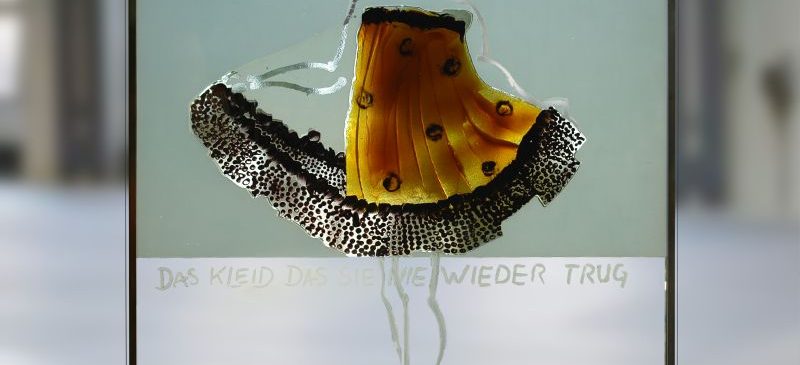
Nabo Gaß
The Artist Nabo Gaß is a storyteller – he discloses his tales through paintings made out of glass. He gets his inspiration from experiences and encounters with people, but also from harrowing news and inconsistencies in our sophisticated world. The transparency of glass allows him to tell his stories layer by layer, in which he is unrivalled. He takes milled glass, makes it doughy with glue, and paints his image motifs with a brush or a spatula onto a support glass. The outcome is an ambiguous, multi-faceted overlapping of the various image layers – similar to the interplay of our thoughts and perceptions which, detached from chronology, overlap incessantly.
Nabo Gaß, born in 1954 in Ebingen (Baden-Wuerttemberg, Germany), lives and works in Wiesbaden. Following a vintage training as a stained-glass artist he studied at the Free Art School in Wiesbaden and at the University of the Arts in Berlin in the 1970s. In order to implement his ideas he developed new techniques of glass design: in 1989 the photo-accurate sandblasting technique, in 1994 the painting with stained-glass powder.
In addition to his freelance works, Nabo Gaß deals with nature-related glass design of public and private buildings. In 1999 he was distinguished by the Corning Museum of Glass (NY, USA) for his pillars on the Via Publica in Wiesbaden. More than ten years ago he began to artistically integrate photovoltaics into architecture. For that he obtained the Innovation Award of the glasstec Düsseldorf. His breakthrough came in 2010 when he received the order, by Ernstings Bau & Grund, to put a new façade of solar panels to the new high-rise warehouse at Coesfeld-Lette.
The Foundation has used this as an opportunity to present Nabo Gaß’s broad repertoire and his virtuoso handling of the medium glass in an exhibition. What is more, the Foundation has been familiar with him for quite some time. In 2006 it acquired three works from his work series “Short moments”. In his latest exhibition Nabo Gaß accepts the challenge of entering into a lively dialogue with his work and the Foundation´s collection.
We invite you to meet this exciting intercommunication of artworks and tales!
Photos:
Nabo Gaß, Das Kleid, das sie nie wieder trug, 2010 – Photo Nabo Gass
Nabo Gaß, Short moments, 2006 – Photo Horst Kolberg
Nabo Gaß, Balance 1, 2010 – Photo Nabo Gass
Nabo Gaß, Maria-Maria, 2008 – Photo Frank Widmann
New Acquisitions 2011
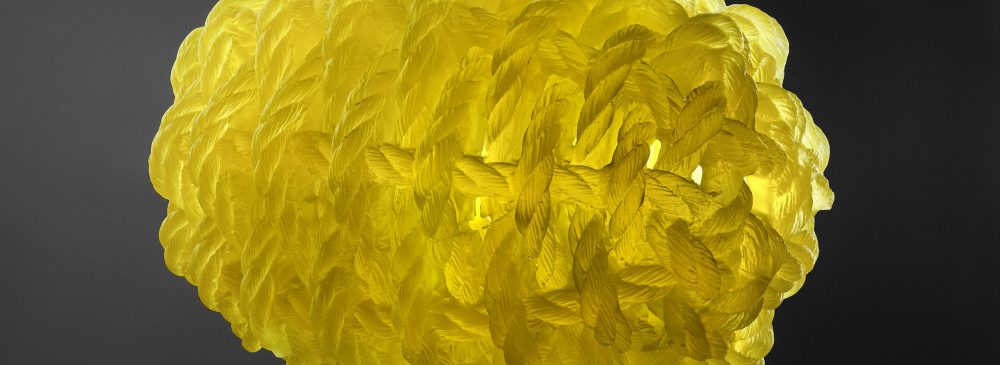
New Acquisitions 2011
February 04 – April 15, 2012
“Glass is like an idea – it can occur in different shapes as heavy as a block or as tender as the wing of a butterfly. Its transparency permits an insight into the hidden interior of the things and the balance between the visible and the invisible world“. In poetic terms the Estonian female artist Kairi Orgusaar describes her perception on the glass. And if one considers the 60 new acquisitions of the collection then you are very close to this philosophy. With Kairi Orgusaar the Foundation made its first meeting with Estonian artists who are comparatively unknown in Western Europe, however, developed themselves independently offside the traditional glass strongholds attaining outstanding performances. Their works generate a deep intuition for material qualities of the glass, for instance, Mare Saares touching tender Pâte de verre object “Casting Shadow“ or Ivo Lills ground object “Lace 1“ and his clear aesthetic language of shapes.
The Foundation conscientiously searched for well-known artists anew: Very impressive are the current works of the French female artist Anne-Lise Riond Sibony, which confront the view with common items incorporating unusual emotions. Only apparently the three dimensional lifestyle “Mangez le Omega 3“ is an abundantly arranged fish platter that brings the current health trend (“Eat Omega 3 fatty acids“) to the point. Actually, the modern (food) culture however degrades the vital creature and even the whole nature to an inanimate object that we thoughtlessly use for our modern lifestyle.
The Belgian artist Giampaolo Amoruso attracts with his “Dandy“ figures active attention that play lovingly ironically with the attributes of the manliness. Extravagant clad, but a little bit introverted enriches one of them, “Ernesto, le Dandy“, the collection.
You´re welcome to an inspiring expedition to the world of the contemporary European glass!
Photos:
Ivan Mares, Rope Egg, 2008 – Photo O. Kocourek
Kairi Orgusaar, The Kiss, 2010 – Photo Kati Kerstna
Anne-Lise Riond Sibony, Mangez des omegas 3, 2011 – Photo Jean-Marc Gourdon
Giampaolo Amoruso, Ernesto, Le Dandy, 2010 – Photo Horst Kolberg
2011
Prag – Ústí nad Labem – Zlín
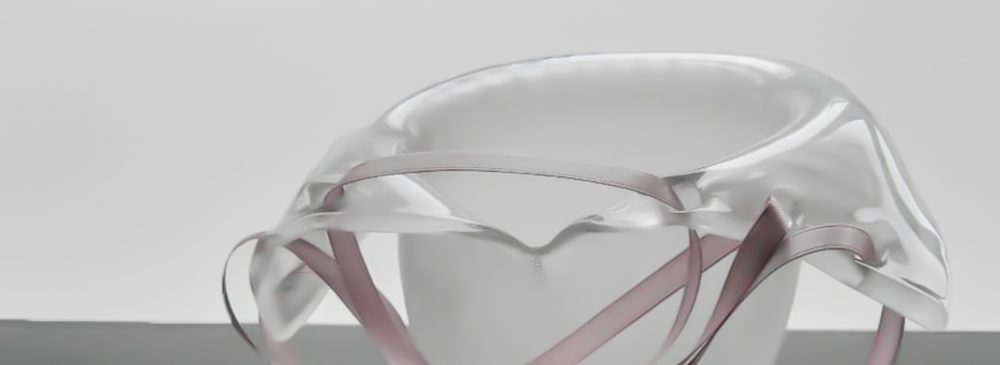
Prag – Ústí nad Labem – Zlín
Prag – Ústí nad Labem – Zlín: Three renowned Czech universities present at the same time in our new exhibition works of students and graduates of their glass departments – an exciting cross-section of young glass made in the Czech Republic. In Czech universities you will discover today a vivid and faceted dealing with the medium glass. Many young artists from all over the world are moving to the Czech Republic to learn here or to work together with the first-class Czech glass studios. For ever glass was regarded as an international figurehead of Czech art and designs. Bohemian glass had already been an attractive export item for decades. Czech artists also discovered in the fifties the artistic power of expression of the material: Glass art became an autonomous type of art with worldwide aura. Even in the world of the Czech design the creative work with glass today head for new, extremely successful paths.
The Academy for Art, Architecture and Design in Prague has a long, changeful history. It started 1885 when according to the wishes of Gottfried Semper, an asserter of a synthesis between art and technology, the significant Prague School of Arts & Crafts (briefly UMPRUM) was founded. In 1947 it was reorganized with the status of a university. Head of the glass studio since 2008 is the internationally coveted top designer Rony Plesl. Ilja Bílek, whose works find recognition worldwide has been head of the glass studio at the Jan-Evangelista-Purkynĕ-Universität in Ústí nad Labem since 1996. The objective of the studio founded in 1992 is a wide-ranging artistic, craftsman and technological training of students who already have completed a glass school. Since its foundation in the year 2008 the renowned artist Petr Stanický has been head of the glass atelier at the Tomáš-Bat´a-Universität in Zlín. In order to develop an authentic artistic position, the students here are required to conceptual thinking. Glass does not end in itself, but act as a medium to artistically reflect social themes.
Photos:
Kateřina Handlová, The Black Hole 1, 2010 – Photo Kateřina Handlová
Tereza Anderlová, Cup for ice cream, 2010 – Photo Tereza Anderlová
Anna Minxová, Watermelon enterprise, 2011 – Photo Horst Kolberg
Luba Bakicová, Oxymoron 1, 2009 – Photo Ilja Bílek
Danish Glass
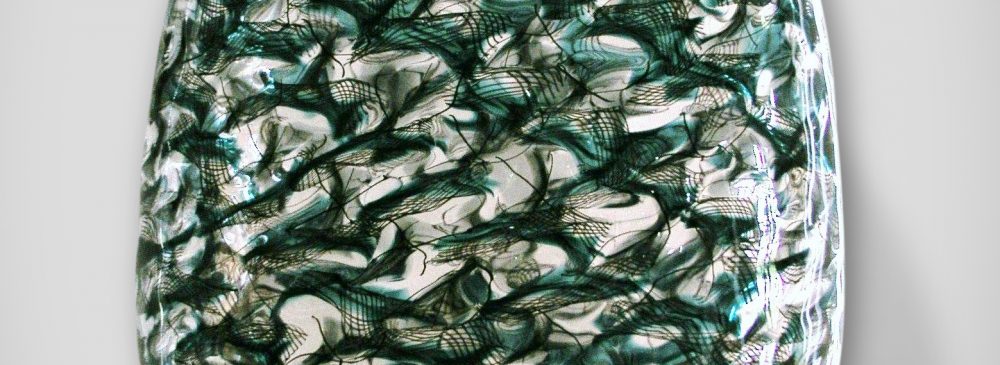
Danish Glass
Danish Design is a brand that enjoys an outstanding reputation worldwide. Whether in the architecture and industrial production, in the handicraft or arts and crafts up to the art nothing is possible without design in Denmark. Diversity, openness and fresh colors characterize this country consisting of big and small islands, precious, perfect in form and timeless it shows its art, especially from glass. Because its tradation in glass processing is long and famous so that an original and good quality glass scenery could establish itself in addition to the touristy paths of the small glassblowing shops. Design and free art mix together unbiased to form a kaleidoscope of creative possibilities of development.
On its journey through the Danish „Glass landscape“ the Foundation came to know the concentrated force of the Danish potential. And it also enters virgin soil: Six artists with six different positions on this material represent a cross-section of the current Danish glass: Lene Bødker, Trine Drivsholm, Micha Karlslund, Pipaluk Lake, Tobias Møhl and Steffen Tast are ambitious artists having international reputation. In the nineties they achieved their artistic breakthrough and obtained numerous national as well as international prizes.
Lene Bødker develops her monochromous sculptures from geometric shapes the outlines of which are mostly closed with basically spacious depth like plasticity in the surface treatment. Trine Drivsholms artistic starting point is the shape of use of the glass. Its functionality alienated by her in the context of sculptural combinations. Micha Karlslunds bizarre objects are inspired by the microcosm of the cells. They enable an insight into the otherwise concealed incredible diversity and depth of life. Pipaluk Lake experiments innovatively with the possibilities of the glass during the melting process as well as in connection with metal: Her glass sculptures are snapshots of this transformation. Tobias Møhl is designer par excellence – using the most sophisticated Venetian techniques he designs minimalist Danish design from organic and very sensual shapes. Steffen Tast, a master of the details, creates with utmost precision hanging space installations and objects from numerous float glasses having the same shape and size, fiber glass and metal. He borrows his subjects from the nature.
Photos:
Tobias Møhl, Glassweaver Vessel, 2011 – Photo AHH
Lene Bødker, Cylinder, 2007 – Photo Horst Kolberg
Micha Karlslund, Cells, 2003 – Photo AHH
Pipaluk Lake, Reticulate, 2009 – Photo Jesper Palm
Trine Drivsholm, Green Vessel, 2011 – Photo Horst Kolberg
Steffen Tast, Screw-screw, 2011 – Photo AHH
Eternal Spring
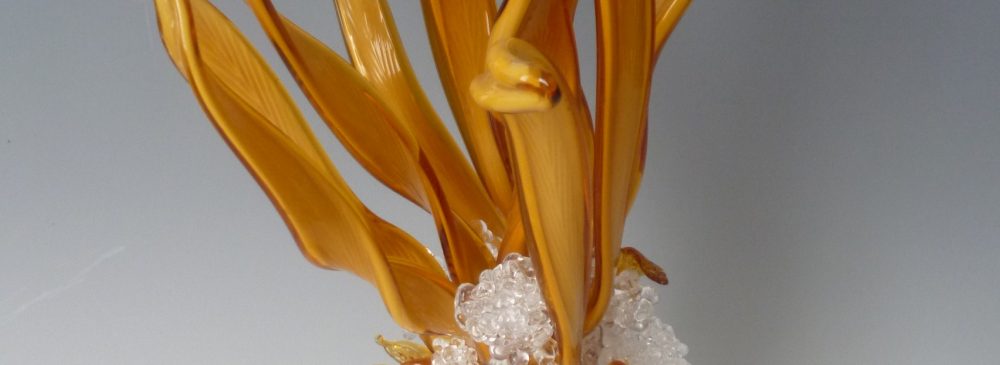
Eternal Spring
The acquisition of three autonomous works of the Dutch female artist Barbara Nanning for the glass collection in the year 2009 also implicated to get personally acquainted with the artist. The way how Barbara Nanning apprehends the medium glass in a wide variety of series of works impressed the Foundation so that it decided to pay attention and to show respect to her in an individual exhibition. Now it is achieved: The Foundation is extremely pleased to present to you Barbara Nanning’s brand-new works in the exhibition “Eternal Spring “.
Barbara Nanning, born in The Hague in 1957, initially made a name for herself in the international art scene with unusual individual ceramic works following her studies at the Amsterdam Rietveld Akademie. After that, she turned to glass under an order from the National Glass Museum and the Royal Glass Works Leerdam. With it, the passion for this material aroused and the artistic career took a new direction. For Barbara Nanning the nature with its manifold, often widespread world of shapes and colors is an almost inexhaustible source of inspiration. Therefore, her works are filled with contradictions and unite amorphous and rigid structures, liberty and rank, manual perfection and the use of unexpected materials.
A real priming that inspired her to do the new works was experienced by the artist in 2010 during her trip to the stronghold of the glass industry Nový Bor in the Czech Republic, where she has been working for many years with professional glass blowers in their projects. On the way she called on Meissen in Saxony and visited there a porcelain exhibition and immediately the spark ignited to transform this white splendor and beauty to glass. That way works with high aesthetics, brightness and haptic charm – all of them being messages of Barbara Nanning’s Eternal Spring. Barbara Nanning‘s new repertoire filled with varieties includes wall and floor installations as well as solitary and group objects and also humoresque pieces like the small red kiss mouth of the wall work “Kiss Kiss Kiss“, among others.
Photos:
Barbara Nanning, Bernsteinfarbener Seetang, 2011 – Photo AHH
Barbara Nanning, Verre d´eglomise, 2007 – Photo Tom Haartsen
Barbara Nanning, WV 1, 2011 – Photo Horst Kolberg
Barbara Nanning, Meeresschwämme 1-3, 2011 – Photo AHH
New Acquisitions 2010
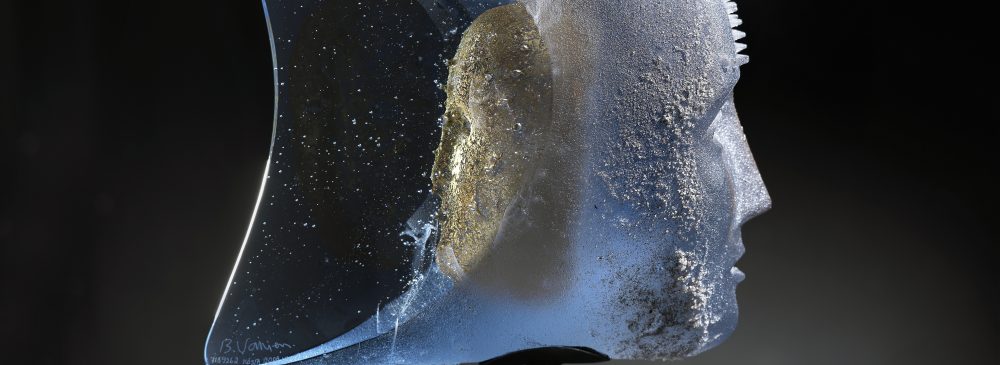
New Acquisitions 2010
With about 60 objects the exhibition New Acquisitions 2010 is this time also a mirror of the international art in the glass sector.
Visits to many art centers (exhibitions, galleries, artist studios and studios) revealed once again: Germany is insofar as glass is concerned strongly on the go and more than a good address for artists all over the world. Thanks to its path-breaking and lasting development and thanks to its outstanding glass factories and glass workshops Germany is in the process of becoming a downright melting pot for those who commit themselves to the material glass.
That artists consider the metropolis Berlin as a setting for the art is plain-talking and that Berlin will now also become a location for the glass is rather a recently emerging development. With Julius Weiland the Glass Museum presented already in 2009 a representative of this genre. New in the collection is the work “Freedom“ of the Australian artist Scott Chaseling, who has been living and working in Berlin for some time. For his expressive work the story-teller and philosopher received several international prizes during the past years. And another new arrival from Berlin: Wilken Skurk with his work “Quingelwingelqui“, the expressive power of which excites the fantasy once more.
Even travel to other regions was not exactly unfruitful for the Glass Museum. An extremely vivid young glass scene is found, for instance, at the Rietveld Akademie in Amsterdam, on the Burg Giebichenstein in Halle and at the Hochschule für Gestaltung in Karlsruhe, where we came to know Laura Jungmann and the Spanish Berta Riera Pomés. Both are represented through works which were developed in the workshop “Designing by Making“ at the French Center International d´Art verrier (CIAV) in Meisenthal. The students experiment together with experienced glass manufacturers using extraordinary materials and methods. For both sides the cooperation was very fruitful and led to unimagined results. In view of the exhibitions in this year the Glass Museum wishes you many exciting aha glass experiences: In spring-time you will see the Dutch artist Barbara Nanning in an individual exhibition, in summer current Danish glass and in autumn/winter works of students oft he art academies in Prague, Zlin and Ústí nad Labem.
Photos:
Bertil Vallien, Janus II, 2009 – Photo G. Örtegren
Laura Jungmann, Carbonize II, 2010 – Photo Laura Jungmann
Ivana Houserova, Solar wind, 2009 – Photo Tomas Hilger
Wilken Skurk, Quingelwingelqui, 2006 – Photo Jan Röhl
2010
Udo Zembok: From the Deepness of the Color
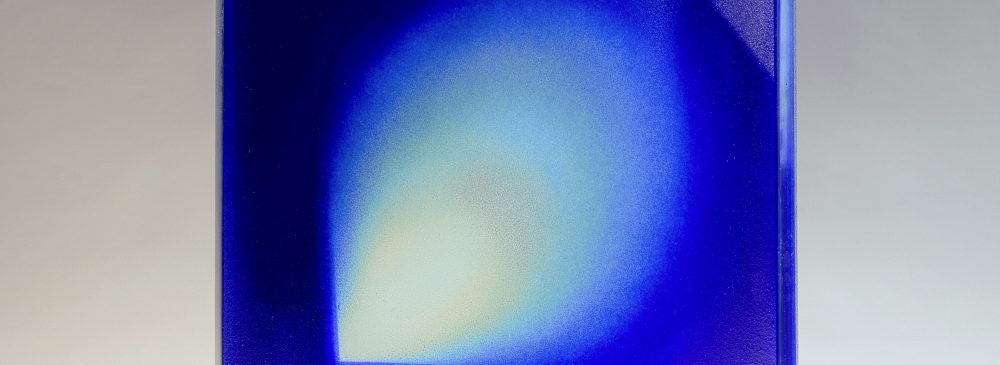
Udo Zembok: From the Deepness of the Color
“Glass is the only material that brings out color from the depth. I try to develop this third dimension of the color“ – Udo Zembok has been dedicating to this challenge since he started his artistic work with glass. His monumental sculptures and installations glow in intensive shades.
They develop from complex layers that optically merge like the colors and transcluent inks on a painter’s pallet. Light effects and the transitions between the colors generate depths in the glass objects in which color appears to materialize. His objects eradiate an almost transcendental force. They attract the viewer magnetically calling for a dialog. One wants to press into its deep interior and comprehend it, however, they remain incomprehensible and retain their last secrect for themselves.
Udo Zembok, born 1951 in Braunschweig, has been living since 1978 as freelance artist in France. After taking courses in graphic arts and painting he started working with the material glass for the first time in 1976. Orders followed very soon for public buildings and sacral buildings. Several times he was awarded international prizes for his work. He received, for instance, in 2003 the French State Prize for Art and Handicraft, 2006 the 2nd prize during the award of Coburg glass prize.
Whether in the autonomous or in the applied arts Udo Zembok remains as an artist true to himself. He is a painter, he paints on glass and with glass and it enables him to paint with light and to generate a depth that is only possible with the medium glass. Like nobody else he understands to preserve his color and forming language at all levels of his work – an universal idea combines his free sculptures and architecture-related objects.
This special strong point makes him pathbreaking for other artists. For many years he has been teaching as a desired lecturer at universities and institutions in Europe and the U.S. on the subject color tree and light in smelting glass technologies.
The new exhibition shows his current works including two monumental sculptures. In the one anybody may go in and stride through, the other, the most recent work is exclusively designed for this work show being matched with the architecture of the Glass Museum Alter Hof Herding.
Welcome – Bienvenue!
Photos:
Udo Zembok, Coeur, 2008, Leihgabe Udo Zembok – Photo Udo Zembok
Udo Zembok, Bleu 2, 2007 – Photo Henri Gaud
Udo Zembok, Noir-Orange, 2010 – Photo Udo Zembok
Udo Zembok, La Porte étroite, 2010, Leihgabe Udo Zembok – Photo AHH
Net, Rod, Thorn – View of Life and Poetry
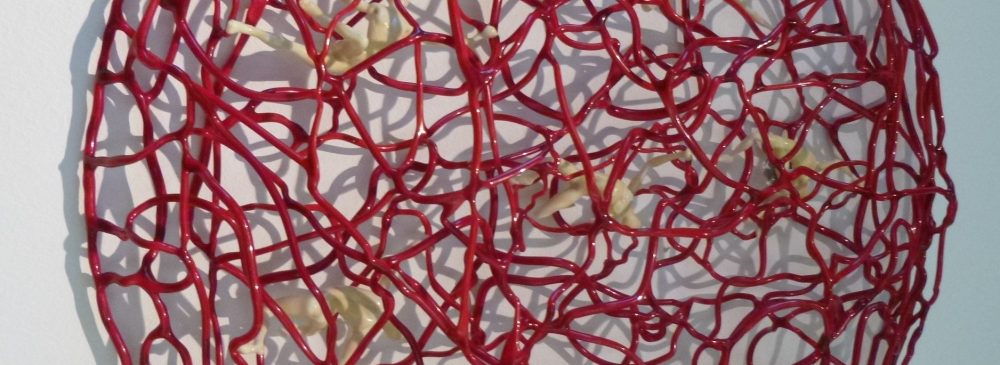
Net, Rod, Thorn – View of Life and Poetry
Lamp glass – the somehow misleading sounding name epitomizes a special technology by which glass objects are shaped not on the furnace, but before the open flame of a gas burner as the so-called „Lamp“. Until the middle of the 19th Century this was, in fact, an oil lamp that was provided with additional air.
Lamp glass is a very old technology with its origins going back to the ancient world. Traditionally, it is considered as an art of the small shape that enables to perfectly shape pearls, miniatures, decorations or small-size receptacles. Over the past years this type of glass has creatively been further developed by some artists and brought to completely new dimensions.
With free, plastic, partly also with big-size objects they have almost revolutionized lamp glass and opened up new possibilities for it in the modern art:
Mauro Bonaventura (*1965 in Venice) uses the nostalgic material Murano glass. He turns and rolls glass threads to spherical shapes until luminous, often spherical shapes, figures and details develop in luminous colors. The Israeli Dafna Kaffeman (*1972 in Jerusalem) also leaps over traditional techniques of the lamp work. She applies vast numbers of sharp glass thorns piece by piece on a silicon matrix: Her objects are fragile, vulnerable and also therefore extraordinarily attractive. Richard Meitner (*1949 in Philadelphia, USA) is one of the most successful artists who is being represented in the Ernsting collection since long. In his innovative, technically versatile work the „Allrounder“ living in Amsterdam has at all times also discovered and further developed the lamp glass for itself anew. He remains true to his style with humor and poetry. Steffen Orlowski (*1966 in Lauscha) plays in his works with the combination of two materials: He sets miniature figures cast from silver as protagonists in abstract spaces from glass. This interplay between abstraction and reality leads to scenarios that tell about feelings and relations. Olga Pusztay (*1958 in Hungary) works with lamp glass from the industry. For her filigree, permeable designed shapes and installations she forms glass tubes and small twigs to a harmonic unit: Symbol for relationship network between human beings and nature. The search for ease in a world full of dualism is the central theme for Nadja Recknagel (*1973 in Schmalkalden). Glass rods are „embroiled“ in the flame and set up netlike: Delicate and still extensive objects develop uniting light-heartedness and force.
Photos:
Mauro Bonaventura, The Human Condition, 2010 – Photo AHH
Steffen Orlowski, Erkenntnis, 2006 – Photo Steffen Orlowski
Nadja Recknagel, Beziehungsweise(n) 3, 2004 – Photo Horst Kolberg
Olga Pusztay, Tasche, 2008 – Photo Zoltan Szalai
Richard Meitner, Au Contraire!, 2010 – Photo AHH
Dafna Kaffeman, Wolf 03, 2004 – Photo Galerie Lorch + Seidel
Jung, Frisch and Frei – The Young, the Beautiful and the really Annoying
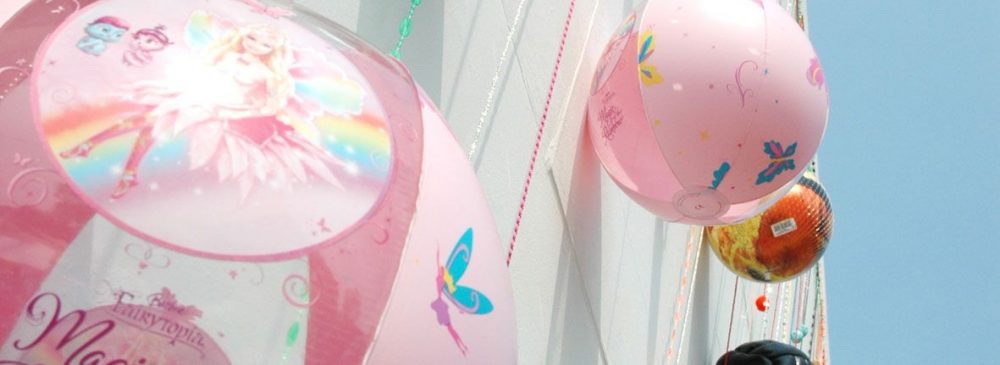
Jung, Frisch and Frei – The Young, the Beautiful and the really Annoying
Not only that the current exhibition in the Glass Museum Alter Hof Herding is conducted under this name, it also describes the concept of the renowned glass department of the Amsterdam Gerrit Rietveld Akademie, that enjoys a high reputation at international level and attracts young artists from all over the world.
Glass and the Rietveld Akademie are connected by a special common history: Since Sybren Valkema 1966 founded the glass department in the academy building, teachings and creation of arts have reciprocally influenced and fertilized themselves. Beyond doubt the role of the glass in the art has basically changed over the past 40 years. For a long period of time predominantly artists of the studio glass movement and the Free Design discovered the material, however, it has in the meantime found its way with all its possibilities and facets to the world of the „Fine Arts“. Besides other materials glass has also become a medium, an artistic concept to transform an idea and to visualize.
Glass as a visual medium? Just at this point the teachings start at the Rietveld Akademie: It wants to enable its students to bring their works in line with the complex demands of modern art and design. Therefore, the glass department of the Rietveld Akademie encourages an innovative, experimental and interdisciplinary use of the glass. Each student is facilitated in the process to unfold its special artistic and conceptual potential, to develop its own visual language and to reflect and challenge the work in context with the time in which we live. Glass is a difficult material so that technical skills and know-how must be acquired in order to work with it. The knowledge of material that every artist needs to materialize its concept and to create the artwork is presumed at the Rietveld Akademie.
The Foundation is delighted to present to you the works of 19 students and graduates of the glass department of the Amsterdam Rieiveld Akademie in the new exhibition „Jung, Frisch und Frei“. The young artists will be accompanied by Caroline Prisse, who has been running the glass department since 2003. The unusual free glass objects, sculptures and mixed-media installations are visualized stories, they bubble over freshness, unbiasedness, inventiveness and unexpected perspectives in the artistic community.
Photos:
Xandra Bremers, Morella, 2010 – Photo Paul Niessen
Frederic van Overschelde, Short stories – Trapped soul, 2008 – Photo Horst Kolberg
Sabrina Metselaar, o.T., 2010, Leihgabe Sabrina Metselaar – Photo Sabrina Metselaar
Mia Lerssi, Freedom belongs to the man who has the balls to take it, 2008, Leihgabe Mia Lerssi – Photo Alma Anselmi
New Acquisitions 2009
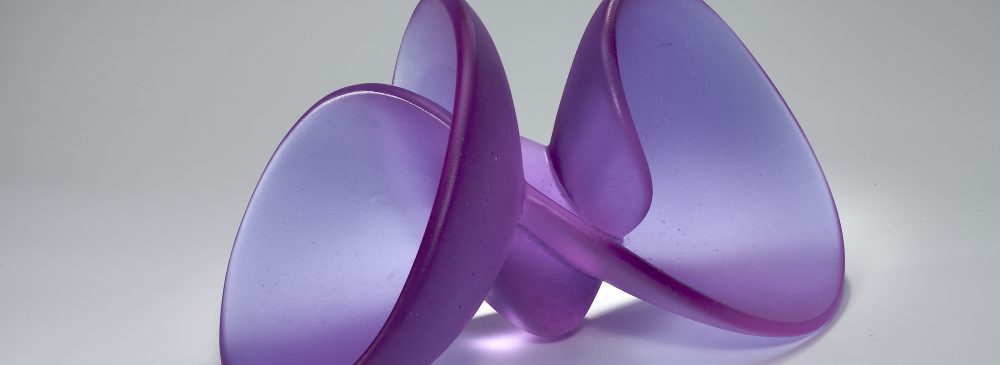
New Acquisitions 2009
“Working with glass teaches discipline, respect and patience, but if you get involved with it you get a type of colorful message full of energy, love and hope“, the way the artist Anne Hein describes her work with the medium glass – a message that also achieves its goal while looking at the glass art. Anne Hein belongs to the great young talents of the actual glass scene. She received several prizes in the past years, in 2007 she received, e.g. the state prize of the federal state Rheinland-Pfalz. Her works attract through an incredible tenderness; bowls that remember to fine woven fabrics though it is difficult to conceive that they were made out a type of glass slurry.
The Foundation has also met many innovative artists on the international floor during the past year. While visiting the exhibition „Connections“ in Prague one could come to know the works of the Danish woman Pipaluk Lake. She is an extremely creative artist, fascinated from the almost inexhaustible possibilities that result through the combination between glass, metal and other elements. „What would have been if..?“ – the question is her most important motivation during the creation process. The Foundation discovered on its trips with great pleasure: Glass as artistic medium evokes in fine artists a growing, intensive interest. For this, the Mexican artist Rebeca Huerta Viga left even her native country to exercise her work with glass at the Glass Centre in Prague under professional conditions.
The Foundation has also made artistic new discoveries in 2009 during own exhibitions in the Glass Museum. Through their free, refreshing handling with glass students of the glass departments of the IKA Mechelen, (Belgium) also the visitors – the show „Een eigenzinnige weg“ developed itself to the absolute darling of the public! The Dutch artist Winnie Teschmacher, who together with Simsa Cho and Menno Jonker devoted herself to the exhibition topic abstraction and surprised everybody with the clear, reposing architecture of her glass objects. Apart from that, the Foundation could purchase some of the unusual hollow-wares of the renowned artist Franz Xaver Höller, who said about his exhibition „Form – Wandel“ that it is a milestone of his artistic career. This show compiled the subjects of his lifework and opened at the same time the door to new works with optical glass.
Look forward to a staggering new exhibition with a cross-section of the ongoing glass art scene and artists about whom one would like to say Stars on the rise!
Photos:
Rebeca Huerta Viga, Infinity Spring, 2008 – Photo Horst Kolberg
Pipaluke Lake, Carry away I, 2008 – Photo Horst Kolberg
Anne Hein, Diabolo, 2009 – Photo AHH
František Janak, Capricorn, 2005 – Photo Frantisek Janák
2009
Julius Weiland
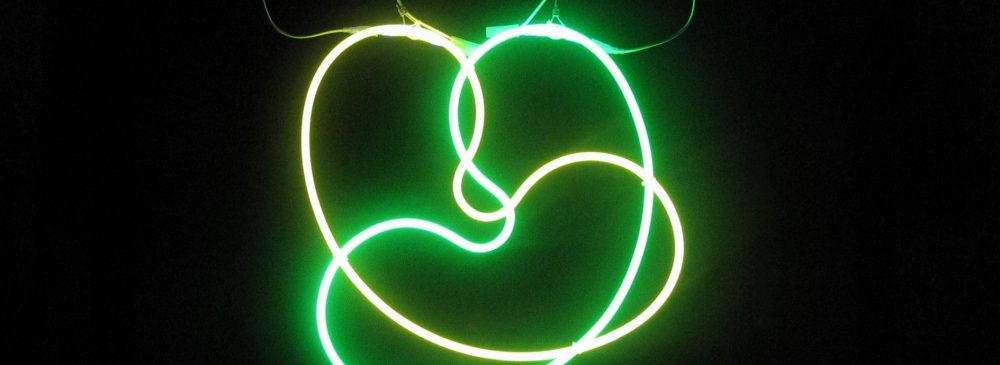
Julius Weiland
The neon works of the Berlin artist Julius Weiland have virtually a sensual emission. Luminous colors in warm red, yellow and green, combined with blue to purple colored shades create a unique, captivating luminous space. The neon light immerses the walls in color spectrums and reflects at the same time thanks to the existing glass surfaces. The floating objects guide the observer and lead him once in an unusual manner to surprising perspectives and vistas thoroughly new through the space. The simple shape language of the objects develops from the circular shape and Weiland plays with it in a sovereign manner. He often forms doublings, superimpositions of same shapes or reflections and evokes optical deceptions.
The Glass Museum is paying attention to the young, ambitious artist Julius Weiland for the first time in an individual exhibition. Thematically it reflects to the period from 2000 until this date. In the past years the Foundation could purchase three works of Julius Weiland, which are an enrichment for the collection both stylistically as well as technically. From this time the observation of this artist started. Weiland made it easy for collectors to focus on him: Many times he has been rewarded with prizes – in 2004 he received the „Gold Prize“ of the International Exhibition of Glass Kanazawa in Japan, in 2006 the Coburg Glass Prize, in 2007 the Jutta Cuny-Franz Prize. Julius Weiland does not take a rest, he proceeds further, looks for and finds new approaches.
The exhibition follows two aspects: It shows the way of Julius Weiland based on selected objects and displays it in the context of the collection. It gives the opportunity to the artist to combine the objects of the collection with his objects according to own ideas.
„Luminous Space“ is a special type of display of works to which we cordially invite you.
Photos:
Julius Weiland, Neon#4, 2008, Leihgabe Julius Weiland – Photo Julius Weiland
Julius Weiland, Neon#12, 2008, Leihgabe Julius Weiland – Photo Julius Weiland
Julius Weiland, Neon#11, 2008 – Photo Julius Weiland
Julius Weiland, o.T., 2005 – Photo Horst Kolberg
“Een eigenzinnige weg”
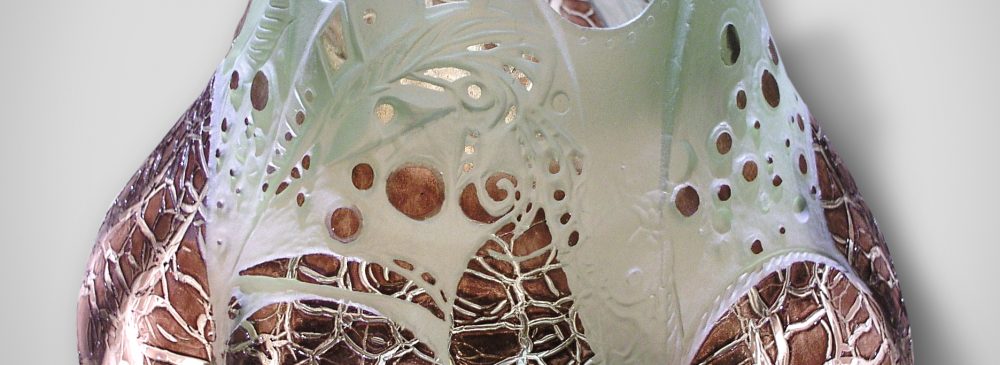
“Een eigenzinnige weg”
Freedom, vision and sovereignity are essential to follow an independent path. The glass department at the Instituut voor Kunst en Ambacht im belgischen Mechelen meets this challenge at a high level. In the course of this, it has achieved a pioneering work because there was no tradition in the free glass art and glass development prior to its foundation in the year 1985 and consequently no highly developed glass history and studio glass movement. It is admirable that the teachers and students at the IKA treat the artistic medium glass freely and self-consciously and are not bogged down – neither in classical craftsmanship traditions nor in artistic experiments. And it is not amazing that an „IKA Style“ has not developed as yet. Flemish glass shows today a vivid cheerfulness, openness and variety.
Promoting the particular artistic potential of each student constitutes the center of attention of the training. Candidates from different countries, among them also already trained artists, enroll themselves at the IKA. An innovative, inspiring atmosphere has developed in this way in which ideas, backgrounds and working methods mix together and cross-fertilise mutually. At the technical craftsmanship level the IKA conveys an unusual well-founded training. Currently, all essential disciplines in the hot glass range are being taught (e.g. blowing, molding or fusing) and in the cold processing (among others engraving, grinding, polishing).
The students in Mechelen are confronted with the demanding artistic task to find and to define the delicate equilibrium between aesthetics, expression and technology. How extraordinarily they master this balancing work is demonstrated by their works. Installations, sculptures, flat glass or mixed media designs, blown and molded objects – all of them reflect the high technical and aesthetic standard of the IKA.
The Foundation is therefore delighted to present to you in the new exhibition „Een eigenzinnige weg“ works of 14 students and graduates of the glass department of the IKA Mechelen. They will be accompanied by Sandra De Clerk, who has been supervising the glass department since 2002.
Photos:
Sylvie Van den Bosch, Manu´tribute seed, 2009 – Photo AHH
Olivier Devos, Fluide, 2008 – Photo AHH
Paul Funcken, Casa Vetro 1, 2008 – Photo Studio Hentschel
Mai Renders, o.T., 2008 – Photo Mai Renders
Beyond Abstraction – More than you see
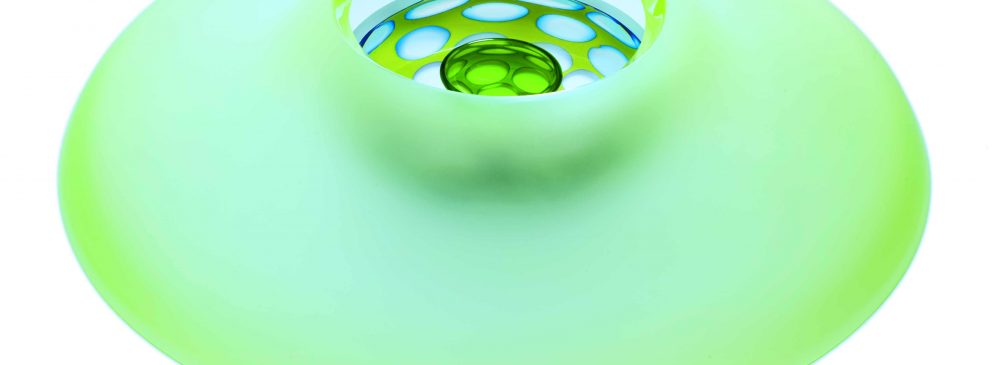
Beyond Abstraction – More than you see
What can be discovered on the other side of the abstraction? No simple answer because abstraction describes the process that filters out the general and conceptual from the concrete discernible and representational or removes the important from the unimportant. The three artists from the Netherlands, Simsa Cho, Menno Jonker and Winnie Teschmacher, confront themselves with this task. What you do not see, they interpret with brilliant works in a completely different manner. Despite high abstraction the themes of their works are discernible. They reveal to the observer sometimes playful, sometimes seriously and at all times satisfying the material.
Simsa Cho was born 1962 in Chiba, Japan. After taking his course at Tama Art University he moved to Amsterdam to the Rietveld Akademie. In the meantime, he has found his way beyond the big Dutch gallery circles. Poetic, sometimes romancing, Simsa Cho draws the artistic language from the rich source of the unconscious. His unconventional sculptures that he often combines with other materials tell mysterious stories, from time to time with humor and irony.
Menno Jonker, born 1968 in Castricum in the Netherlands, turned to glass as an artistic medium not until1997. Nonetheless, already in 2001 he was nominated as the best glass artists of the world by the Corning Museum of Glass (U.S.A). His works are appreciated due to their perfection, the unique shape language and the innovative dealing with the material glass. The organic, adaptable shapes of his objects encourage the observer to give way to his haptical tendencies and to feel the harmonic contours. This way they have a strong emotional force that underline the intensive, unusual shades of color. Menno Jonke’s artistic language acts lyrical and he thoroughly declares his support for the aesthetics of the glass.
Winnie Teschmacher, born 1958 in Rotterdam, can look back on a long-standing and widespread experience with the material glass. After studying at the Academy of the Fine Arts in Rotterdam and at the Free Academy in the Hague she opened her own glass studio already in 1983. As a freelance artist and designer she was active for several glass factories. In her artistic work she advances like a mystic to the core of the things. In the course of this works come into being from a clear, rational architecture the shape language of which congenially combines harmony, calmness and spirituality.
The Ernsting Stiftung is delighted to introduce these three unusual artists to you in the new exhibition „Beyond Abstraction“.
Photos:
Simsa Cho, Twilight Energy, 2002 – Photo Ron Zijlstra
Menno Jonker, Atlantic Ridge Crater, 2007 – Photo Jeroen van der Spek
Winnie Teschmacher, Equillibrium 1, 2006 – Photo AHH
Winnie Teschmacher, Light of the soul, 2007 – Photo Louis Sonderegger
New Acquisitions 2008
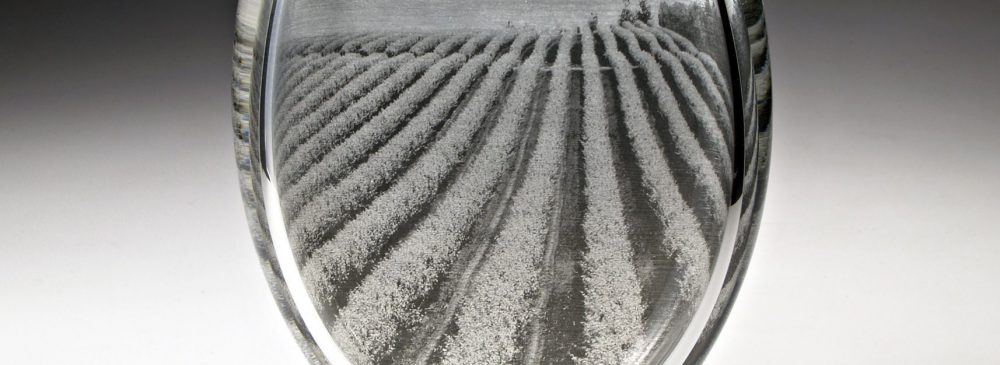
New Acquisitions 2008
As every year the Foundation has again visited many artists, galleries, exhibitions and academies in 2008 at home and abroad as well. The objective in this connection is always to discover current trends and developments of the international glass art.
The „flying visit“ to the London art exhibition Collect – a real treasure trove, has become a habit to get acquainted with works of young artists outside Europe. The Foundation is therefore delighted to present to you, among others, unusually worked glass pieces of three young Australians, Tali Dalton, Nicole Ayliffe and Tavita Havea.
A trip to the Czech Republic turned to be particularly worth seeing and worthwhile. A Highlight was certainly Prague, the centre of contemporary glass art. At the Academy for Art, Architecture and Design in Prague one meets promising young artists who deal with the glass in a convincing manner.
The Foundation could also acquire works of significant Czech artists like Jaromir Rybak, Ronny Plesl and Jan Fišar. There was an interesting meeting in Prague with Bohumil Elias junior, who is succeeding as a young glass artist his famous father who has unfortunately died in the meantime. His works are nonetheless very independent – massive, extensive monuments that let one forget how fragile the material glass is in reality.
In addition to these external acquisitions the collection has also been enlarged through new acquisitions from the own exhibitions of the year 2008. The Foundation acquired, among others, two dresses of the Dutch artist Patula Berm. Her exhibition “My dresses“ became the darling of the public. “Mirrow Image“ is permanently being exhibited at the Concert Theater Coesfeld, “Memories of Lavander“ can be admired at the Glass Museum Alter Hof Herding. Even exhibits from the students’ exhibition “Experiment Glass“ of the Institute for Artistic Ceramics and Glass in Höhr-Grenzhausen have also found a place in the glass collection like works of Peter Bremers and Michael Behrens. Their exhibition “Water and ice“ was presented by the Glass Museum for a few weeks in light and colours and caused such a sensation that the number of visitors attained a new record.
Share with us an exciting and varied new exhibition!
Photos:
Nicole Ayliffe, Vinyard, 1997 – Photo Michal Kluvanek
Tali Dalton, Memories, 2007 – Photo Jeremy Dillon
Jaromir Rybak, Schale mit Fischen, 2005 – Photo AHH
Bohumil Elias jr., Under the depht, 2008 – Photo Gabriel Urbánek
2008
Franz Xaver Höller
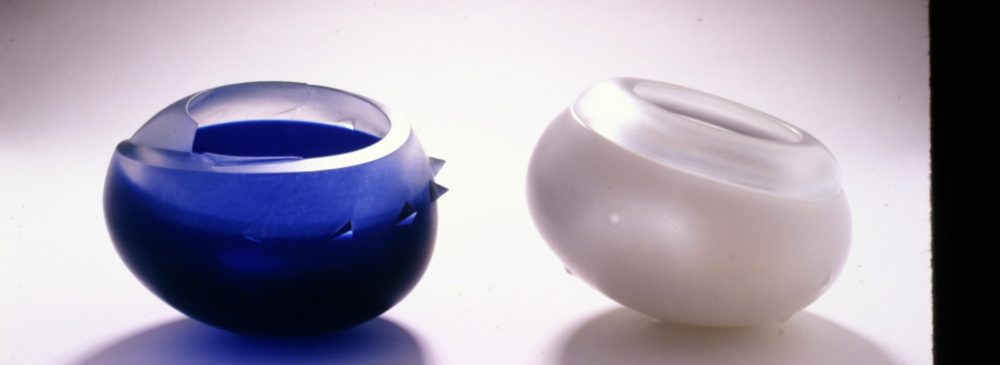
Franz Xaver Höller
The artist Franz Xaver Höller (born in 1950 in Leopoldsdorf, Bavaria) is one of the masters of his genre. Being rooted in a long glass-tradition, the shape of the vessel still plays the decisive part in his work. Even though he is tempted again and again by the unrestricted sculpture, it is mostly mugs, bowls and topped vessels that come into being in his studio – yet not for usage.
And that is what makes his work so fascinating. Indeed, the shapes are borrowed from the familiar traditional glass for usage, but its sense he interprets anew. The creations belong to themselves, they have become autonomous.
Thus, there is something unspeakable, metaphysical in his works that goes beyond the substantial. Höller takes vision and inspiration from nature’s phenomena. Rhythm and polarity, the perpetual returning and yet at the same time never equal manifestations of life are leitmotifs: day and night, life and death and over and over again pairs that, like two poles, are drawn together or pushed off from one another, symbolizing the binding and separating in unity.
Franz Xaver Höller is successful in the artistic execution of these interrelations, because of his disciplined and at the same time forceful and wilful iconography. The magical interplay between light and glass is particularly decisive. Höller especially dedicates much attention to the surface treatment, like grinding and engraving, as it coins atmosphere and charisma of the piece of work. By designing the surface he overcomes superficiality and opens a view for profoundness.
Franz Xaver Höller is a professional artist par excellence. He went through all stages: master craftsman as polisher for cupped glass, learned glass-designer, studies of glass-design and sculpture at the art academy in Munich, freelance artist, director of workshops, amongst others at the Corning Glass Museum in New York and at the Australian National University in Canberra. Since 1981 he has been working as academic at the Public Professional Glass-School in Zwiesel.
The glass museum Alter Hof Herding is proud to be able to present the lifework of Franz Xaver Höller to you with this exhibition.
Photos:
Franz X. Höller, Deckelgefäß 260, 2007 – Photo Franz X. Höller
Franz X. Höller, Paar-VIII (234), 2003 – Photo Franz X. Höller
Franz X. Höller, Objekt (271), 2008 – Photo Horst Kolberg
Franz X. Höller, Deckelgefäß 239, 2003 – Photo Horst Kolberg
“Water and Ice”
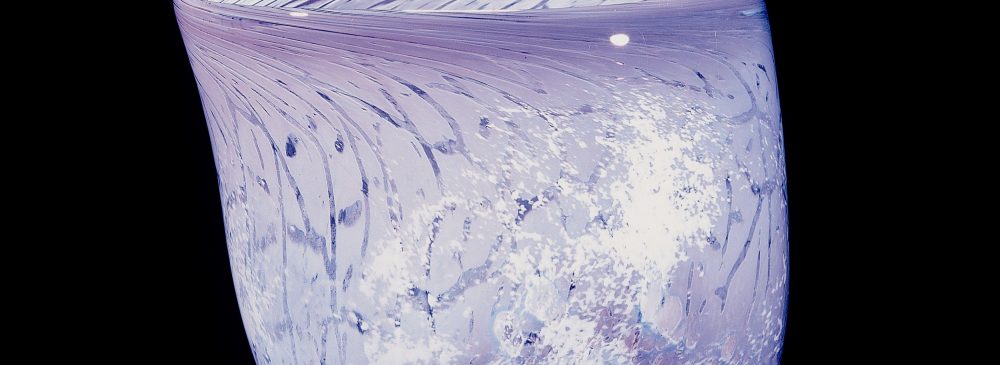
“Water and Ice”
Water and Ice – under this title the Glass Museum Alter Hof Herding will present works of the two artists Michael Behrens and Peter Bremers in a new exhibition.
Though the two artists look at the glass in a totally different way, their works show many points of contact. The natural phenomena water and ice, optically very close to the glass, are inexhaustible sources of inspiration for both.
Trips to the Antarctic have deeply impressed the Dutchman Peter Bremers. His monumental sculptures of great presence reflect the stunning aura of the polar ice formations. Ossified in abstract shapes like ice, they appear to rest themselves in an almost contemplative way.
Unforeseeable light fluctuations often lend to the monochrome works a mysterious depth, a hidden shine – one feels like looking inside a glacier.
Diving operations in the underwater world before the coasts of Indonesia inspired Michael Behrens. The young artist from Düsseldorf has introduced new trends in the art of glass: They act amorphous, liquid, appear like water always waving in a soft movement which is not easily comprehensible. The illusion is still intensified when the colours blend within the object. The observer wishes to take hold of the glass and to catch a structure in the diffuse thicket.
Michael Behrens and Peter Bremers brilliantly master the techniques of glass design. Their ice and water landscapes impress with an unparallel dimension and depth.
The foundation is delighted to present with „Water and Ice“ a double exhibition in German-Dutch cooperation.
Photos:
Michael Behrens, Underwater-World 91-2008 – Photo Paul Niessen
Michael Behrens, Underwater-World 89-2008 – Photo Paul Niessen
Peter Bremers, I&P 07-114, 2007 – Photo Paul Niessen
Peter Bremers, AS 02-19, 2002 – Photo Paul Niessen
„Experiment Glass“
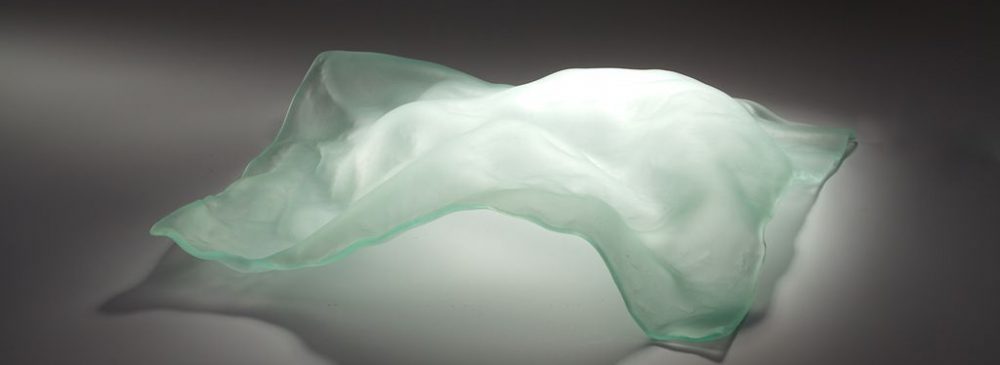
„Experiment Glass“
„Each work of art fetches its own material“ – so simple was the answer of a female student of the Institute for Artistic Ceramics and Glass to the question regarding the status of glass in the art. The Institute for Artistic Ceramics and Glass, a department of the Fachhochschule Koblenz, is rather new and located in Höhr-Grenzhausen.
While visiting the only Institute for Artistic Ceramics and Glass in Rheinland-Pfalz, it becomes obvious that the works of the students are determined by the concept and especially by the medium glass. Everybody experiments with his own idea and its realization using the adequate material. On that the prospective artists are tested by their teachers because the language of the material is the language of the work of art and its intention as regards content. The use of glass in the creative process is just as significant as its association with materials unlike glass.
The students of the glass class demonstrate in their works results and interim results on their personal path to the art. In the course of this unusual, fascinating works of art emerge ranging from installations via sculptures up to blown and moulded glass objects. They all reflect the freedom and openness towards glass as an artistic medium.
The Foundation is pleased to present to you in the new exhibition „Experiment Glas“ works of 11 students and graduates of the Institute for Artistic Ceramics and Glass. The young artists are accompanied by the Instutute Director, professor Ingrid Conrad-Lindig, the Head of the Workshop Glass, Thomas Kruck, and the teacher Jean Paul Raymond.
With this special exhibition the Foundation is once again following its tradition to show glass works of students from technical glass colleges and art colleges.
Photos:
Petra Sindelar, Experiment II, 2008 – Photo Horst Kolberg
Judith Röder, Faltenwürfe, 2007 – Photo Horst Kolberg
Wladimir Körting, Erinnerung 1, 2006 – Photo AHH
Stanislaw Jan Borowski, Torsi II, 2007 – Photo AHH
New acquisitions 2007
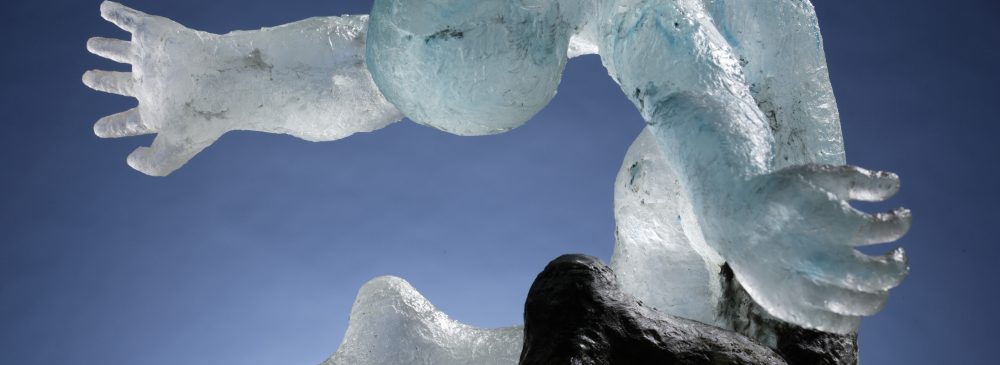
New acquisitions 2007
Collecting, exhibiting, informing are the main tasks of a museum. In order to fulfil this task, the foundation annually tracks down the trends in modern art. That way it acquires consistently and continuously the glass objects which grade up the collection to an exemplary work exhibition of European glass art. Right at the beginning of the new year the foundation traditionally presents the finding of its collection of the preceding year at its exhibition “New acquisitions”.
Travelling to such significant glass centres of Europe as, for example, Leerdam, Strasbourg and Ebeltoft (Denmark) gave the important impulses to the collection last year among other things. In Leerdam the foundation could acquire two works of Menno Jonker. The Dutchman was nominated to one of the best glass artists of the world in 2001 by the Corning Museum of Glass (USA). His works are appreciated, first of all, because of their technical perfection, the unique language of forms and the innovative handling of the glass material.
At the same time the collection has been increased by many interesting exhibits from the latest special exhibitions “Space 14″ and ” Made in NRW “.
The works of young, experimentally working glass artists from the Academy of Arts in Stuttgart and the works of the established artists who have received the State Price of North Rhine-Westphalia for their special handling of glass are among them.
The foundation is proud that in the course of this exhibition it could take up into the collection the sculpture “Into each other” by Klaus U. Hilsbecher , for which he was awarded the State Price in 2007.
Photos:
Carmelo López, Homenage an Goya, 2005 – Photo Ralf Bauer
Menno Jonker, Odi et Amo, 2005.- Photo Horst Kolberg
Hartmann Greb, Neptun verlässt das Meer, 2007 – Photo Horst Kolberg
Mieke Pontier, Clouds II, 2006 – Photo Aad Doorduin
2007
Patula Berm
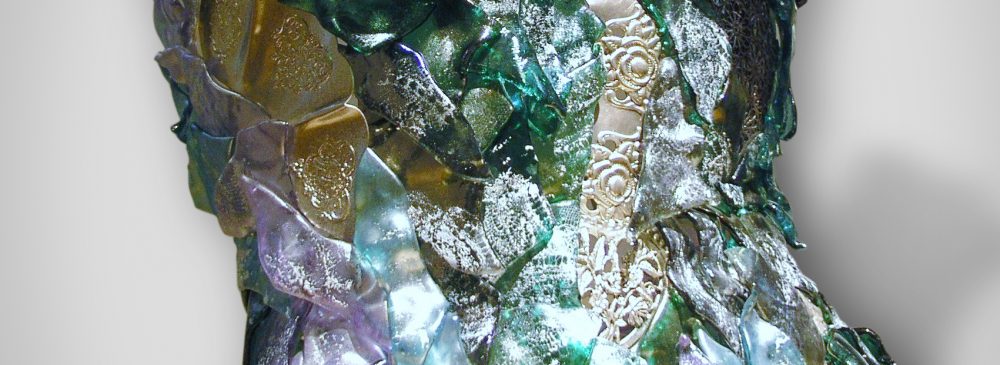
Patula Berm
The Dutch artist Patula Berm is the designer of exciting dresses, bustiers and wigs. You can’t wear her creations, though – they’re made of glass!
A fascinating aura encompasses her clothing, casting a spell on the observer and sending him or her on a journey replete with fantasy, esprit and poetry.
When Patula Berm works, she’s led by her intuition and associations. Even in the conceptual stage, each of her sculptures subsists on its own special atmosphere, which she then realizes in her creation.
The artist finds inspiration for her work everywhere: the depth of the ocean, the water which forms a type of second skin around the body, the nostalgia of an old movie or even just a particularly magical moment.
In creating her glass clothing on the other hand, she’s often stimulated by common everyday objects: mirrors, coins, silverware, brushes, strands of hair, red peppers or shells. She combines these various materials with her glass creations, thus giving them a completely new meaning.
Patula Berm started coming up with her glass clothing in 1995 in the Amsterdam glass studio Van Tetterode.
The glass museum Alter Hof Herding is extremely pleased to present the works of a single artist again for the first time in a long time. Come and be amazed by the extraordinary pieces on exhibit.
Photos:
Patula Berm, Knight in shiny armour, 2007 – Photo AHH
Patula Berm, Mirrow Image, 2002 – Photo Richard Willebrands
Patula Berm, Memories of Lavander, 2007 – Photo Richard Willebrands
Patula Berm, Flying fish, 2007 – Photo Richard Willebrands
„Made in NRW“
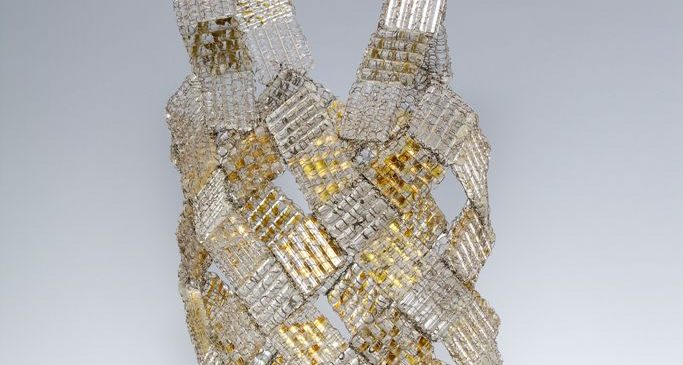
„Made in NRW“
For top performances in artistic and creative designs the federal state NRW awards every two years a state prize since 1962. It is awarded in eight different working areas including the glass sector. In the meantime the state prize NRW is considered the most significant prize of its kind in Germany.
The Glasmuseum Alter Hof Herding is therefore proud to present in a new, exciting summer exhibition glass works of seven state prize winners:
In this year Klaus Hilsbecher was awarded the state prize for the extraordinary formal language of his geometric abstract glass objects. Thomas Lemke’s sculptures, often geometrical basic bodies fascinate and irritate through a transparent interplay from inside and outside. Uta Majmudar’s clear and simultaneously complex objects from massive glass rods and wire mesh also play with the perception of the viewer. The glass sculptures of Gerd Kruft perfectly reveal the real character of the material transparency, reflection, the richness of facets. Lothar Göbel on the other hand links sandstone with basalt lava with clear, almost puristic shapes becoming successful in this case which still seem surprisingly natural. Georg Lindens impressive installations seem to produce a dialogue between light, colour and space. Helga Reay-Young catches through the intensive interaction of glass with natural materials the character of the light anew.
Photos:
Thomas Lemke, Goldquadrat, 2004 – Photo Horst Kolberg
Gerd Kruft, Blauer Keil + Blaues Quadrat, 2005 – Photo Horst Kolberg
Helga Reay-Young, Lichfänger, 2003 – Photo Horst Kolberg
Lothar Göbel, o.T., 2007 – Photo Horst Kolberg
Klaus U. Hilsbecher, In-Einander – Staatspreis NRW 2007 – Photo Horst Kolberg
Georg Linden, Wächter I, 2003 – Photo Georg Linden
Uta Majmudar, Körperform, 2004 – Photo Horst Kolberg
„Room 14“
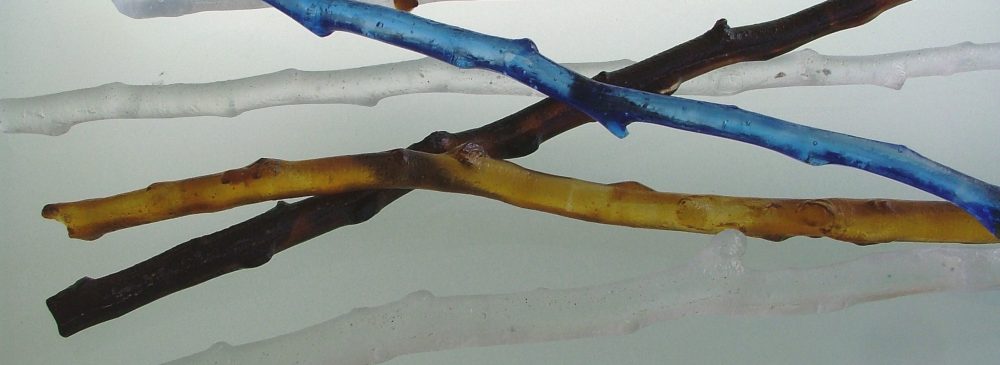
„Room 14“
„Room 14“? – Yes, it really exists! It belongs to the Academy of Fine Arts Stuttgart, is a workshop and communication room at the same time. Unusual objects are created here from glass – experimentally, conceptionally, aesthetically. In Room 14 students from completely different artistic subject areas meet together at the glass furnace: ranging from the glass design via ceramic up to painting, graphic and sculpture.
Stuttgart belongs to the minority of art colleges where the artistic association with the material glass is taught at all. The communication of basic technical skills, free working and experimental dealings with glass stand in the context with the own artistic development of the students. The inspiring effect of this freedom full of suspense on the work of the students is reflected by the unique glass objects which are created in cooperation with the workshop for glass, especially at the melting furnace.
Whether installation, sculpture, free-blown or shape-blown objects or sheet glass designs – all works of art scintillate an unusual cheerfulness and candour towards the medium glass. The Glass Museum Alter Hof Herding is therefore delighted to present to you in the new exhibition „Room 14“ glass works of 13 students and graduates of the Stuttgart Academy.
The students will be accompanied by Jörg F. Zimmermann, who manages the workshop for hot glass and plastic shaping, and by Claudia Heinzler, director of the workshop for glass painting and glass processing. With this special exhibition the Glass Museum Alter Hof Herding continues its tradition to show glass works of art college students and to sponsor young talents.
Photos:
Dilini Keethapongalan, Kopflastig 4, 2005 – Photo Horst Kolberg
Anja Römpp, Zweige, 2004 – Photo Anja Römpp
Gregor Linz, Konzentration, 2006 – Photo Horst Kolberg
Katharina Weidauer, Velena, 2006 – Photo Katharina Weidauer
New Acquistions 2006
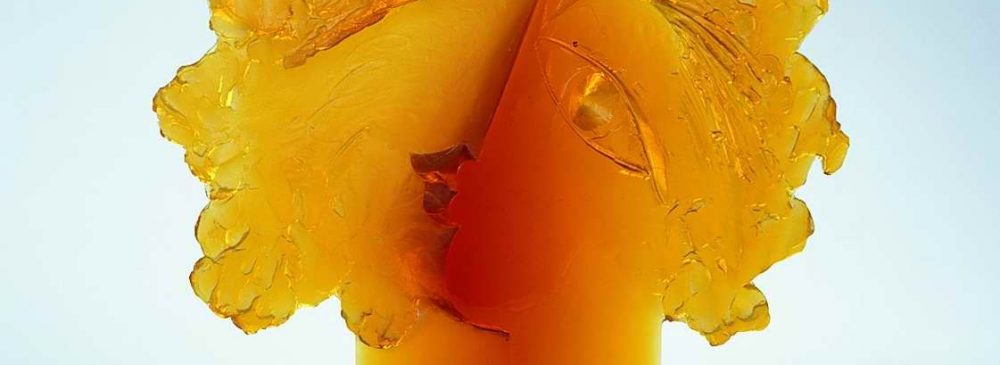
New Acquistions 2006
In the past year 2006 the glass collection Ernsting has expanded through many fascinating and important objects as well.
The Glass Museum is not only showing new works of already familiar artists like Hanneke Fokkelmann and Richard Price, but also works of less popular artists; e.g. Dafna Kaffeman from Israel, whose fragile, colourful objects possess a very special charm, or Blanka Adensamova, who gives her glass sculptures a shining transparency.
The Glass Museum is particularly pleased to simultaneously present two works of the prizewinners of the renowned Coburg Glass Prize 2006. Udo Zembok, a German glass artist living in Alsace, was honoured in April 2006 for his sculptural, multi-layer fusing objects that already gave him an international reputation. Zembok achieves the impressive brightness of his objects by applying colour pigments, metals or minerals on several glass layers and fusing them to compact plates. Once the sculpture is perfect, the colours appear to shine from the depth of the object – an effect that virtually exercises a magnetic attraction on the viewer.
Josepha Gasch-Muche, the second main prizewinner of the Coburg Glass Prize, is regarded as a newcomer in the glass scene. She belonged to free painting before turning recently to glass – with unexpected success. Gasch-Muche works with extremely thin display glass which is being used in industrial processes. She breaks it into tiny fragments and fixes them relief-like with a colourless glue on a picture frame. In the incidence of light the numerous reflecting fragment layers finally develop a breathtaking, intensive momentum.
The Foundation acquired one of the most fascinating glass pictures from the first exhibition of the artist in Baden-Baden – without suspecting that the glass collection Ernsting came to possess with this a work of the future prizewinner of the Coburg Glass Prize 2006.
The Glass Museum is delighted to present to its guests once again with the exhibition New Acquistions 2006 a varied view of the different trends of the current glass art.
Photos:
Josepha Gasche-Muche, 10.2.03., 2003 – Photo AHH
Blanka Adensamova,The head of Hathor, 2005 – Photo Horst Kolberg
Dafna Kaffeman, Tactile stimulation, 2005 – Photo Horst Kolberg
Hanneke Fokkelmann, o.T., 2006 – Photo Horst Kolberg
2006
“Männerhaut”
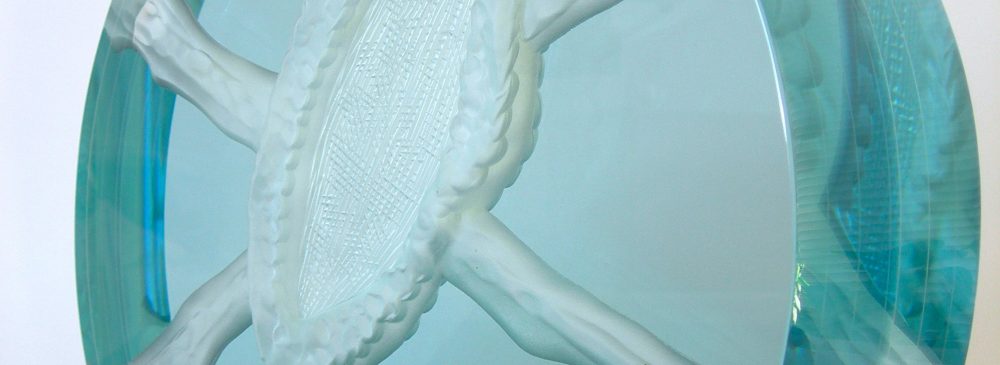
“Männerhaut”
When five men came together in 1991 to share a studio at Frauenau in Bavaria, they looked for a name to reflect them and their work.
An advertising slogan eventually inspired their name-finding efforts: “Men’s skin (Männerhaut) is quite natural, too”, it said in a magazine, and this was precisely what the five intended to express as individuals and artists – working in a group, with no group ideology slipped over them, a shared studio enabling the joint use of machines and a permanent exchange on artistic creation and craftsmanship.
The surprising thing is that glass receded into the background initially, although Frauenau is a historic location and a synonym for this material. Perhaps that was why during the first years of search and experiment, Männerhaut tried to keep their distance from glass and prove that artists in that part of the world, too, could be masters of free painting and sculpture.
It was only after four years of working together that Männerhaut returned to glass, and in 1995 they had their first exhibition at the Frauenau museum of glass. Their studio had meanwhile become too small because the group then had increased to six members and had reconstituted itself with the aim of winning recognition for glass in art, design and handicraft within the region and beyond.
After numerous exhibitions and projects, Männerhaut has become an integral part of the world of glass art. In the Bavarian glass-making centres of Frauenau and Zwiesel, this group of artists has become a real institution.
For the first time, the glass museum “Alter Hof Herding” hosts a Männerhaut exhibition – we are looking forward to the highly individual, poetic, playful and aesthetic creations in glass by “Atschi” Achatz, Ronald Fischer, Michael Gölker, G. Jo Hruschka, Stefan Stangl and Alexander Wallner.
Photos:
Ronald Fischer, Ein Stück Unendlichkeit, 2006 – Photo Ronald Fischer
Josef Achatz, Gipfelstürmer, 2006 – Photo AHH
Michael, Gölker, Ratte, 2003 – Photo AHH
Stefan Stangl, Vier seltsame Herren, 2006 – Photo Horst Kolberg
Alexander Wallner, o.T., 2004 – Photo AHH
2003
Tschechische Glasfachschulen
Tschechische Glasfachschulen
In der Glasgalerie Hittfeld bei Hamburg wurden im Jahr 2000 Arbeiten von Studenten tschechischer Glasfachschulen präsentiert. Die hervorragende Qualität der Objekte war so überzeugend, dass daraus die Idee zu einer eigenen Ausstellung im Glasmuseum entstanden ist.
In Kooperation mit der Galeristin der Glasgalerie Hittfeld, Eliška Stölting, organisiert das Glasmuseum eine Ausstellung mit Arbeiten von Studenten und Lehrern der tschechischen Glasfachschulen in Zelezný Brod, Kamenický Šenov und Nový Bor. Diese Schulen wurden Ende des 19. Jahrhunderts gegründet. Zu der Zeit begannen die Kunden, höhere Ansprüche an die Qualität der Glasprodukte zu stellen. Um konkurrenzfähig zu bleiben, hatte die Glasindustrie die Notwendigkeit der kontinuierlichen Anpassung an veränderte Lebensgewohnheiten und den Geschmack der Verbraucher erkannt. Zunächst orientierten sich die Schulen an den speziellen Erwartungen der Industrie und bildeten geschickte Schleifer, Graveure und Glasmaler aus, die nach ihrem Abschluss in die industrielle Fertigung übernommen wurden.
Durch den Einfluss der veränderten Anforderungen der Glasindustrie wurde gleichzeitig eine bemerkenswerte und intensive Entwicklung angestoßen. Es war offensichtlich, dass ein Zuwachs sowohl an technischen Kenntnissen als auch an künstlerischen Fähigkeiten immer wichtiger wurde. So werden heute an den Glasfachschulen neben der Ausbildung von Spezialisten für die Glasindustrie auch besonders talentierten Schüler für das Studium an einer Kunstakademie vorbereitet. Da jede Schule ganz spezifische Fachkenntnisse auf unterschiedlichen Gebieten der Glastechniken besitzt, zeigt diese Ausstellung eine breite Vielfalt von interessanten Arbeiten.
Objektbeschreibungen von links:
Jiri Sin, o.T., 2002 – Foto Ron Zijlstra
Lenka Bubnova, o.T., 1999 – Foto Ron Zijlstra
Anna Polanska, Motorrad I + III, 2000 – Foto Ron Zijlstra
Petr Mens, Comedia dell Arte, 2000 – Foto Foto Ron Zijlstra



